Paul van Yperen's Blog, page 57
March 6, 2024
Frankenstein (1931)
Frankenstein (1931) is an iconic American Horror film directed by James Whale and produced by Carl Laemmle Jr. for Universal. Whale based the story on the 1927 play written by Peggy Webling which was again based on Mary Shelley's 1818 novel 'Frankenstein; or, The Modern Prometheus'. For Boris Karloff, his role as the monster was a breakthrough. The film became a huge success and received several sequels. In 1991, it was listed on the National Film Registry.
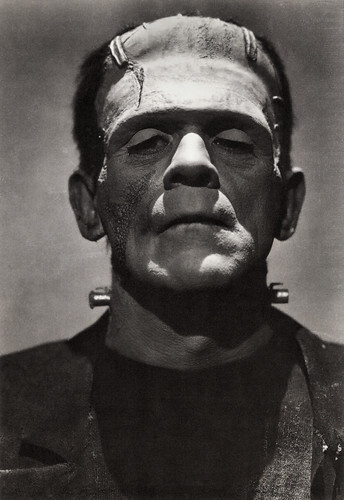
American postcard by Classico San Francisco, no. 233/06. Photo: Roman Freulich / Universal Pictures. Boris Karloff in Frankenstein (James Whale, 1931).
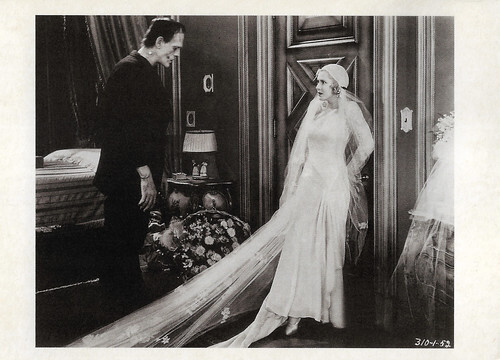
American postcard by American Postcard, no. 37. Boris Karloff and Mae Clarke in Frankenstein (James Whale, 1931).
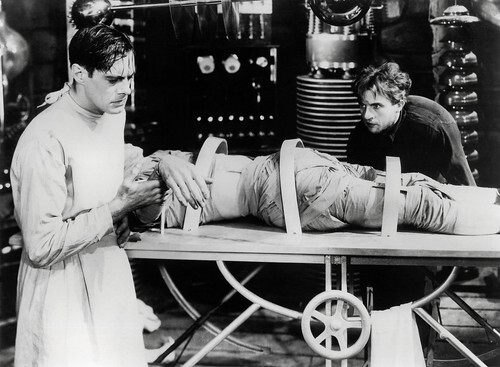
Vintage press photo. Colin Clive and Dwight Frye in Frankenstein (James Whale, 1931).
A man made entirely of parts from corpses
For Frankenstein (1931), the Peggy Webling play was adapted by John L. Balderston and the screenplay was written by Francis Edward Faragoh and Garrett Fort, with uncredited contributions from Robert Florey and John Russell.
In a village in the Bavarian Alps, Dr Henry Frankenstein, Victor Frankenstein in the novel, (played by Colin Clive ) is a brilliant scientist possessed by the idea of reviving dead tissue. To carry out his experiments, he goes out at night to dig up corpses along with his hunchback servant Fritz (Dwight Frye).
But instead of providing him with a healthy brain, Fritz gives him the brain of a murderer. Henry is about to marry his fiancée Elizabeth (Mae Clarke) to inherit his father's estate, but he increasingly loses sight of reality and becomes completely absorbed by his experiments. One stormy night, his greatest life wish is fulfilled when he uses lightning to revive his creation, a man made entirely of parts from corpses.
The creature ( Boris Karloff ), often known as "Frankenstein's monster", seems simple and harmless at first, meekly doing whatever Frankenstein commands, but soon Henry and Fritz begin to suspect that the creature could be dangerous and lock him in the cellar. Their fears prove well-founded when the monster breaks out and kills Fritz.
Henry realises his mistake and, helped by his old teacher Dr. Waldman (Edward Van Sloan), sets out to eliminate the monster with a lethal injection. They manage to administer the monster the injection, but it only renders the monster unconscious. As Henry goes to his wedding, the monster reawakens and kills Waldman. It then escapes from the castle. After some wandering, it meets Little Maria, a farmer's daughter (Marilyn Harris) who is not afraid of it, but in his ignorance, he throws her into the water and she drowns.
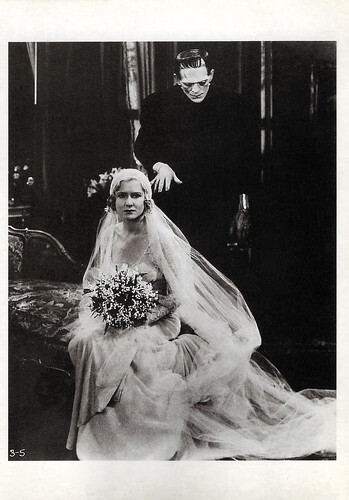
American postcard by American Postcard, no. 38. Boris Karloff and Mae Clarke in Frankenstein (James Whale, 1931).
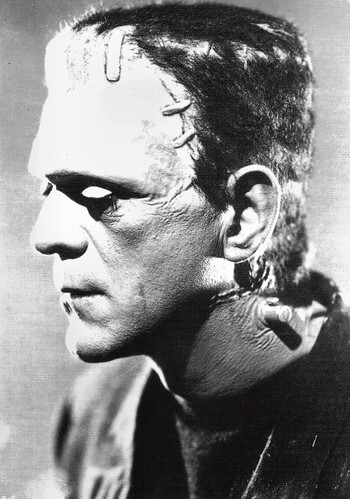
American postcard by Zoetrope Images Ltd., Boston, no 432. Photo: Boris Karloff in Frankenstein (James Whale, 1931).
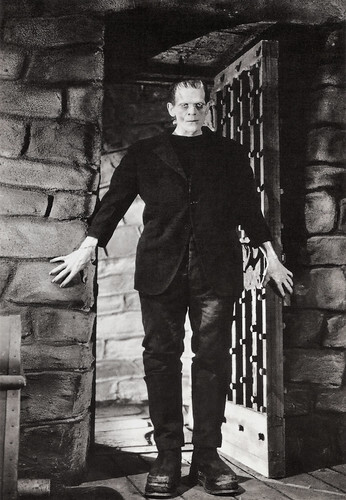
American postcard by Classico San Francisco, no. 233/01. Photo: Universal Pictures. Boris Karloff in Frankenstein (James Whale, 1931).
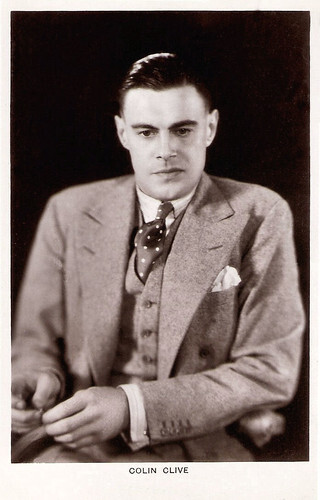
British postcard in the Picturegoer Series, London, no. 482. Colin Clive .
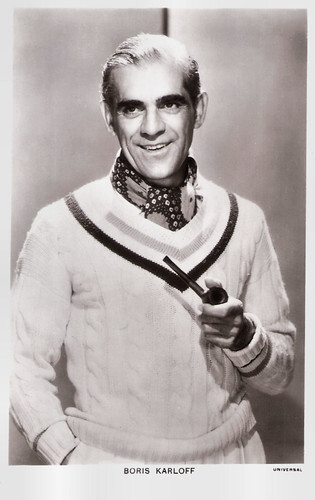
British postcard in the Picturegoer series, London, no 707 H. Photo: Universal. Boris Karloff .
How Dracula and Frankenstein Saved Universal
In 1930, Universal Studios had lost $2.2 million in revenues. Within 48 hours of its opening at New York's Roxy Theatre on 12 February 1931, Dracula (Tod Browning, 1931) starring Béla Lugosi had sold 50,000 tickets, building a momentum that culminated in a $700,000 profit, the largest of Universal's 1931 releases. As a result, the head of production, Carl Laemmle Jr., announced immediate plans for more horror films.
Frankenstein (1931) was initially to be directed by Robert Florey. Following his acclaimed role as Count Dracula, Béla Lugosi was Florey's first choice for the role of Dr. Frankenstein. However, when he proved unsuitable for the role, he was offered to play the monster instead so that Universal could at least include his name on the film poster.
Robert Florey shot two test reels with Lugosi in the role of the monster. Reportedly, these reels were disappointing. Universal then took Florey and Lugosi off the project. They were given Murders in the Rue Morgue, as a consolation. Lugosi would still play the monster years later in the film Frankenstein Meets the Wolf Man (Roy William Neill, 1943).
After Florey's departure, the newly arrived British director James Whale took over and he cast Colin Clive and Boris Karloff . He had the screenplay rewritten to give the monster more character. Jack Pierce came up with the familiar look for the monster. Pierce was inspired by brain operations when surgeons cut off the top of the skull. He flattened the top of the skull and added staples. Pierce covered Karloff's hair with a skullcap. He drew a square skull and forehead using cotton soaked in collodion. The actor felt that his eyes were still too bright and Pierce made wax eyelids.
Kenneth Strickfaden was responsible for the special effects surrounding the monster's creation, especially the electricity. Boris Karloff reportedly feared being burnt by the electricity in the scene. The effects were so successful that they became an essential part of every subsequent Universal film involving Frankenstein's Monster. Accordingly, the equipment used to produce them has come to be referred to in fan circles as "Strickfadens". It appears that Strickfaden managed to secure the use of at least one Tesla Coil (transformer) built by inventor Nikola Tesla himself.
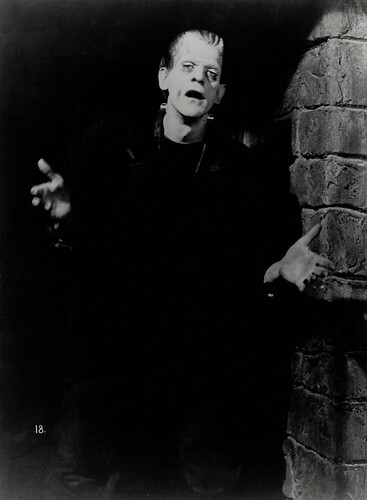
Dutch press photo by Nederlands Film Museum, Amsterdam. Boris Karloff in Frankenstein (James Whale, 1931).
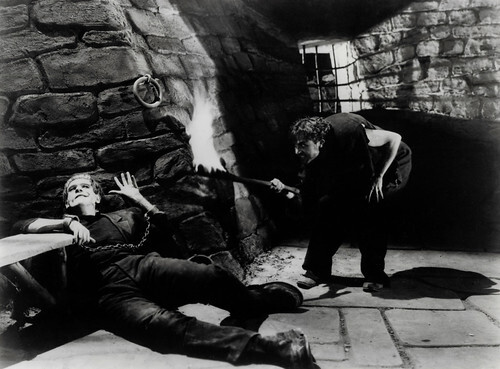
Vintage press photo. Boris Karloff and Dwight Frye in Frankenstein (James Whale, 1931).
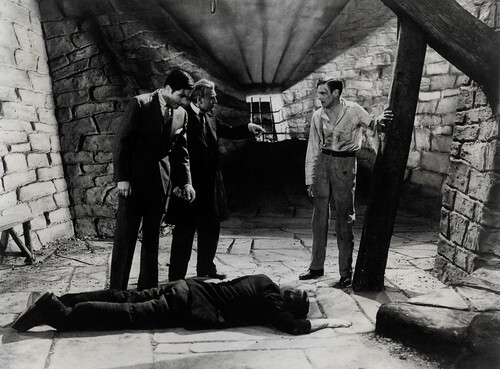
Vintage photo. John Boles, Edward Van Sloan, Colin Clive and Boris Karloff in Frankenstein (James Whale, 1931).
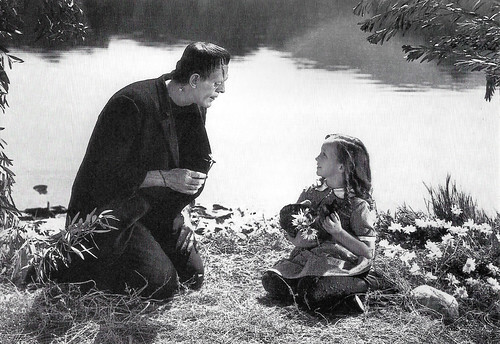
Vintage press photo. Boris Karloff and Marilyn Harris in Frankenstein (James Whale, 1931).
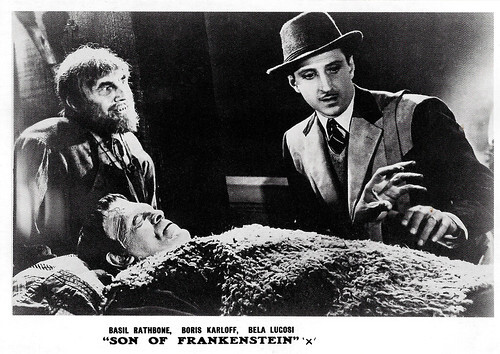
English postcard by Moviedrome, no. M7. Boris Karloff , Basil Rathbone and Béla Lugosi in Son of Frankenstein (Rowland V. Lee, 1939).
"It's alive!"
Frankenstein (James Whale, 1931) was produced with an estimated budget of $291,000. The film was a sensation. The scene in which the monster throws Little Maria into the water, accidentally drowning her, was long considered too controversial. In the states of Massachusetts, Pennsylvania, and New York, among others, the second part of this scene was cut. Cinemas in the state of Kansas wanted a total of 32 scenes removed from the film before they were willing to show it. If they had been removed, would have cut half of the film.
Frankenstein introduced several elements not found in the original book, but today closely associated with Frankenstein and his monster: Fr. Frankenstein's laboratory, the idea that Frankenstein steals the body parts for his creation from graves at night, the idea that Frankenstein uses lightning to bring his creation to life, the idea that Frankenstein would have an assistant, still called Fritz in this film but named Igor in many later films and series, Frankenstein's cry of joy "It's alive!" when the monster is successfully brought to life and the idea of an angry mob eventually armed with torches hunt down the monster.
Frankenstein was well-received by critics. The New York Times film critic Mordaunt Hall said that the film "aroused so much excitement at the Mayfair yesterday that many in the audience laughed to cover their true feelings. [T]here is no denying that it is far and away the most effective thing of its kind. Beside it Dracula is tame and, incidentally, Dracula was produced by the same firm".
People flocked to the cinema and the box office receipts amounted to $5,000,000. It was one of the biggest box office hits of the 1931-1932 period, proving to Universal Pictures executives that there was an audience for Horror films. The film had a significant impact on popular culture. The imagery of a maniacal "mad" scientist with a subservient hunchbacked assistant and the film's depiction of Frankenstein's monster has since become iconic.
In 1991, the United States Library of Congress selected Frankenstein (James Whale, 1931) for preservation in the National Film Registry as being "culturally, historically, or aesthetically significant".
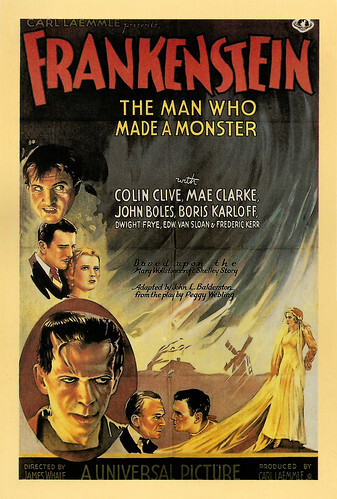
Vintage postcard by Edition Hugo, Movie Collection, no. 810. American poster by Universal for Frankenstein (James Whale, 1931).
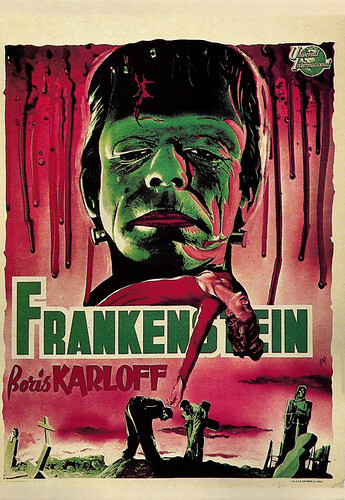
French postcard by Editions Zreik, Paris, no. 24. Original artwork: Bos. Vintage poster for Frankenstein (James Whale, 1931).
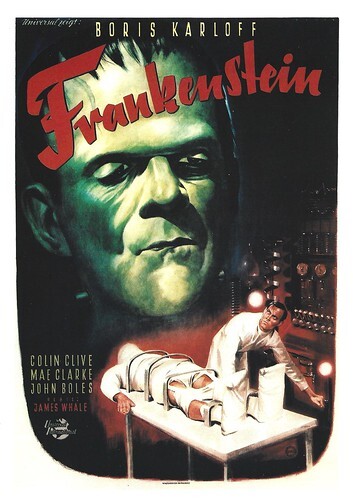
German postcard by Edition Tushita, Cinemania, no. B806. German poster for the Universal International film Frankenstein (James Whale, 1931).
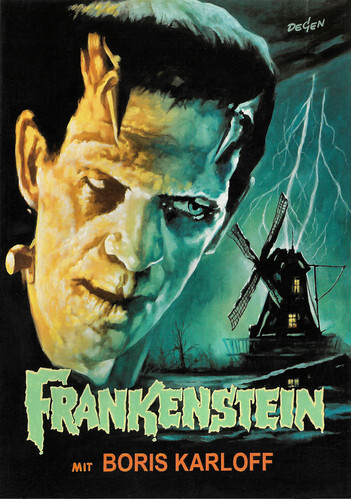
German postcard by ZigZagPosters, no. B. 016. Original artwork: Kurt Degen. German poster for Frankenstein (James Whale, 1931).
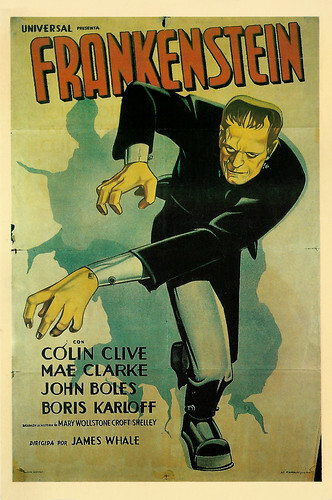
Vintage postcard by Edition Hugo, Movie Collection, no. 801. Spanish poster for Frankenstein (James Whale, 1931).
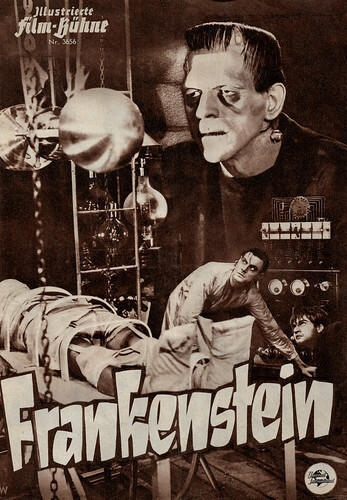
German flyer by Illustrierte Film-Bühne, no. 3656. Photo: Universal. Boris Karloff, Colin Clive and Dwight Frye in Frankenstein (James Whale, 1931).
Sources: Mordaunt Hall (The New York Times), Wikipedia (Dutch, French and English) and IMDb.

American postcard by Classico San Francisco, no. 233/06. Photo: Roman Freulich / Universal Pictures. Boris Karloff in Frankenstein (James Whale, 1931).

American postcard by American Postcard, no. 37. Boris Karloff and Mae Clarke in Frankenstein (James Whale, 1931).

Vintage press photo. Colin Clive and Dwight Frye in Frankenstein (James Whale, 1931).
A man made entirely of parts from corpses
For Frankenstein (1931), the Peggy Webling play was adapted by John L. Balderston and the screenplay was written by Francis Edward Faragoh and Garrett Fort, with uncredited contributions from Robert Florey and John Russell.
In a village in the Bavarian Alps, Dr Henry Frankenstein, Victor Frankenstein in the novel, (played by Colin Clive ) is a brilliant scientist possessed by the idea of reviving dead tissue. To carry out his experiments, he goes out at night to dig up corpses along with his hunchback servant Fritz (Dwight Frye).
But instead of providing him with a healthy brain, Fritz gives him the brain of a murderer. Henry is about to marry his fiancée Elizabeth (Mae Clarke) to inherit his father's estate, but he increasingly loses sight of reality and becomes completely absorbed by his experiments. One stormy night, his greatest life wish is fulfilled when he uses lightning to revive his creation, a man made entirely of parts from corpses.
The creature ( Boris Karloff ), often known as "Frankenstein's monster", seems simple and harmless at first, meekly doing whatever Frankenstein commands, but soon Henry and Fritz begin to suspect that the creature could be dangerous and lock him in the cellar. Their fears prove well-founded when the monster breaks out and kills Fritz.
Henry realises his mistake and, helped by his old teacher Dr. Waldman (Edward Van Sloan), sets out to eliminate the monster with a lethal injection. They manage to administer the monster the injection, but it only renders the monster unconscious. As Henry goes to his wedding, the monster reawakens and kills Waldman. It then escapes from the castle. After some wandering, it meets Little Maria, a farmer's daughter (Marilyn Harris) who is not afraid of it, but in his ignorance, he throws her into the water and she drowns.

American postcard by American Postcard, no. 38. Boris Karloff and Mae Clarke in Frankenstein (James Whale, 1931).

American postcard by Zoetrope Images Ltd., Boston, no 432. Photo: Boris Karloff in Frankenstein (James Whale, 1931).

American postcard by Classico San Francisco, no. 233/01. Photo: Universal Pictures. Boris Karloff in Frankenstein (James Whale, 1931).

British postcard in the Picturegoer Series, London, no. 482. Colin Clive .

British postcard in the Picturegoer series, London, no 707 H. Photo: Universal. Boris Karloff .
How Dracula and Frankenstein Saved Universal
In 1930, Universal Studios had lost $2.2 million in revenues. Within 48 hours of its opening at New York's Roxy Theatre on 12 February 1931, Dracula (Tod Browning, 1931) starring Béla Lugosi had sold 50,000 tickets, building a momentum that culminated in a $700,000 profit, the largest of Universal's 1931 releases. As a result, the head of production, Carl Laemmle Jr., announced immediate plans for more horror films.
Frankenstein (1931) was initially to be directed by Robert Florey. Following his acclaimed role as Count Dracula, Béla Lugosi was Florey's first choice for the role of Dr. Frankenstein. However, when he proved unsuitable for the role, he was offered to play the monster instead so that Universal could at least include his name on the film poster.
Robert Florey shot two test reels with Lugosi in the role of the monster. Reportedly, these reels were disappointing. Universal then took Florey and Lugosi off the project. They were given Murders in the Rue Morgue, as a consolation. Lugosi would still play the monster years later in the film Frankenstein Meets the Wolf Man (Roy William Neill, 1943).
After Florey's departure, the newly arrived British director James Whale took over and he cast Colin Clive and Boris Karloff . He had the screenplay rewritten to give the monster more character. Jack Pierce came up with the familiar look for the monster. Pierce was inspired by brain operations when surgeons cut off the top of the skull. He flattened the top of the skull and added staples. Pierce covered Karloff's hair with a skullcap. He drew a square skull and forehead using cotton soaked in collodion. The actor felt that his eyes were still too bright and Pierce made wax eyelids.
Kenneth Strickfaden was responsible for the special effects surrounding the monster's creation, especially the electricity. Boris Karloff reportedly feared being burnt by the electricity in the scene. The effects were so successful that they became an essential part of every subsequent Universal film involving Frankenstein's Monster. Accordingly, the equipment used to produce them has come to be referred to in fan circles as "Strickfadens". It appears that Strickfaden managed to secure the use of at least one Tesla Coil (transformer) built by inventor Nikola Tesla himself.

Dutch press photo by Nederlands Film Museum, Amsterdam. Boris Karloff in Frankenstein (James Whale, 1931).

Vintage press photo. Boris Karloff and Dwight Frye in Frankenstein (James Whale, 1931).

Vintage photo. John Boles, Edward Van Sloan, Colin Clive and Boris Karloff in Frankenstein (James Whale, 1931).

Vintage press photo. Boris Karloff and Marilyn Harris in Frankenstein (James Whale, 1931).

English postcard by Moviedrome, no. M7. Boris Karloff , Basil Rathbone and Béla Lugosi in Son of Frankenstein (Rowland V. Lee, 1939).
"It's alive!"
Frankenstein (James Whale, 1931) was produced with an estimated budget of $291,000. The film was a sensation. The scene in which the monster throws Little Maria into the water, accidentally drowning her, was long considered too controversial. In the states of Massachusetts, Pennsylvania, and New York, among others, the second part of this scene was cut. Cinemas in the state of Kansas wanted a total of 32 scenes removed from the film before they were willing to show it. If they had been removed, would have cut half of the film.
Frankenstein introduced several elements not found in the original book, but today closely associated with Frankenstein and his monster: Fr. Frankenstein's laboratory, the idea that Frankenstein steals the body parts for his creation from graves at night, the idea that Frankenstein uses lightning to bring his creation to life, the idea that Frankenstein would have an assistant, still called Fritz in this film but named Igor in many later films and series, Frankenstein's cry of joy "It's alive!" when the monster is successfully brought to life and the idea of an angry mob eventually armed with torches hunt down the monster.
Frankenstein was well-received by critics. The New York Times film critic Mordaunt Hall said that the film "aroused so much excitement at the Mayfair yesterday that many in the audience laughed to cover their true feelings. [T]here is no denying that it is far and away the most effective thing of its kind. Beside it Dracula is tame and, incidentally, Dracula was produced by the same firm".
People flocked to the cinema and the box office receipts amounted to $5,000,000. It was one of the biggest box office hits of the 1931-1932 period, proving to Universal Pictures executives that there was an audience for Horror films. The film had a significant impact on popular culture. The imagery of a maniacal "mad" scientist with a subservient hunchbacked assistant and the film's depiction of Frankenstein's monster has since become iconic.
In 1991, the United States Library of Congress selected Frankenstein (James Whale, 1931) for preservation in the National Film Registry as being "culturally, historically, or aesthetically significant".

Vintage postcard by Edition Hugo, Movie Collection, no. 810. American poster by Universal for Frankenstein (James Whale, 1931).

French postcard by Editions Zreik, Paris, no. 24. Original artwork: Bos. Vintage poster for Frankenstein (James Whale, 1931).

German postcard by Edition Tushita, Cinemania, no. B806. German poster for the Universal International film Frankenstein (James Whale, 1931).

German postcard by ZigZagPosters, no. B. 016. Original artwork: Kurt Degen. German poster for Frankenstein (James Whale, 1931).

Vintage postcard by Edition Hugo, Movie Collection, no. 801. Spanish poster for Frankenstein (James Whale, 1931).

German flyer by Illustrierte Film-Bühne, no. 3656. Photo: Universal. Boris Karloff, Colin Clive and Dwight Frye in Frankenstein (James Whale, 1931).
Sources: Mordaunt Hall (The New York Times), Wikipedia (Dutch, French and English) and IMDb.
Published on March 06, 2024 22:00
March 5, 2024
Sue Carol
Sue Carol (1906-1982) was an American actress and talent agent. Carol's film career lasted from the late 1920s into the 1930s. When it ended, she became a talent agent. The last of her four marriages was to one of her clients, Alan Ladd, from 1942 until he died in 1964.
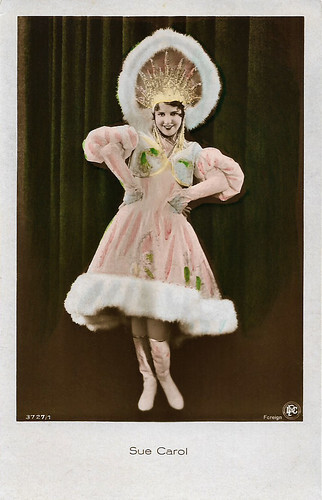
German postcard by Ross Verlag Foreign, no. 3727/1, 1928-1929. Photo: PDC.
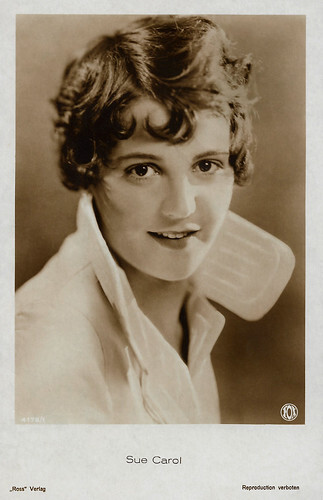
German postcard by Ross Verlag, no. 4178/1, 1929-1930. Photo: Fox.
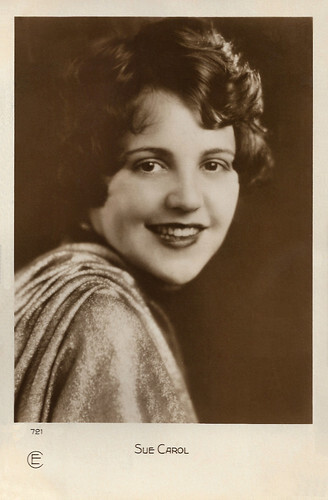
French postcard by Cinémagazine-Edition, Paris, no. 721, sent by mail in 1931.
One of the WAMPAS Baby Stars of 1928
Sue Carol was born Evelyn Jean Lederer in 1906 in Chicago, Illinois. Her parents were Samuel Lederer and Caroline Lederer née Schmidt, Jewish emigrants from Austria and Germany, respectively.
While Carol was in Hollywood on vacation, a director offered her a screen test that resulted in a contract with Fox. In 1927, she began playing minor parts in such films as the silent comedy-drama Slaves of Beauty (John G. Blystone, 1927). She had a major part in the comedy Soft Cushions (Edward F. Cline, 1927), now considered lost.
She became one of the WAMPAS Baby Stars in 1928. The WAMPAS Baby Stars was a promotional campaign sponsored by the United States Western Association of Motion Picture Advertisers, which honoured 13 young actresses each year whom they believed to be on the threshold of movie stardom.
Her next films were made in association with producer Cecil B. DeMille such as Skyscraper (Howard Higgin, 1928) starring William Boyd and the silent drama Walking Back (Rupert Julian, 1928) in which she starred as a bob-haired flapper. For Metro-Goldwyn-Mayer, she starred in the silent drama Beau Broadway (Malcolm St. Clair, 1928) with Lew Cody and Aileen Pringle. For Fox, she made the comedy Win That Girl (David Butler, 1928) with synchronised sound. Both films are considered lost now.
Among her other films for Fox are the musical Fox Movietone Follies of 1929 (David Butler, Marcel Silver, 1929) and the melodrama Girls Gone Wild (Lewis Seiler, 1929), which was released in sound and silent versions. The latter film starred Carol with Nick Stuart. Being an up-and-coming young film duo, they were moulded by Fox in the Janet Gaynor / Charles Farrell tradition. The two would be married later in the year, in November, in a surprise ceremony.
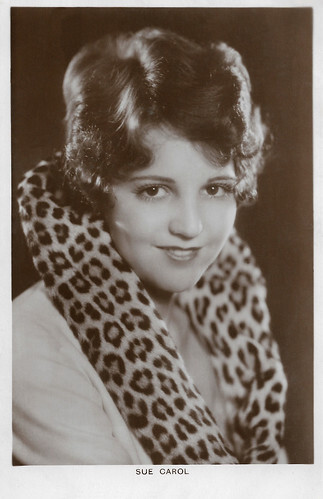
British postcard in the Picturegoer Series, London, no. 379a.
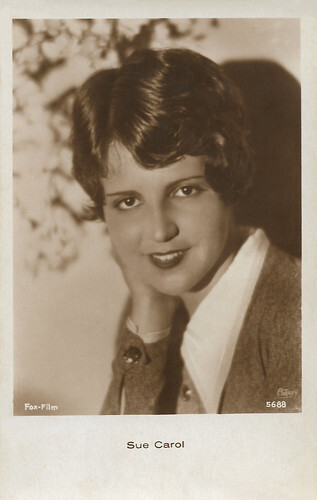
Austrian postcard by Iris Verlag, no. 5688. Photo: Max Munn Autrey / Fox.
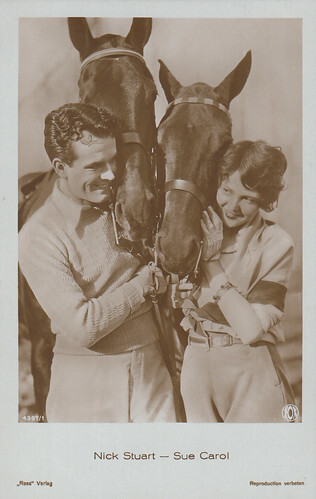
German postcard by Ross Verlag, no. 4397/1, 1929-1930. Photo: Fox. Collection: Marlene Pilaete.
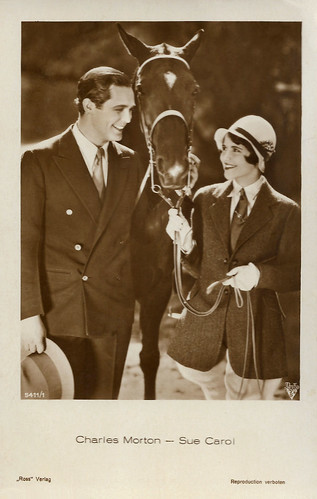
German postcard by Ross Verlag, no. 5411/1, 1930-1931. Photo: RKO Radio Pictures. Charles Morton and Sue Carol in Check and Double Check (Melville W. Brown, 1930).
Wife and manager of Alan Ladd
Sue Carol co-starred with George O'Brien in the Western The Lone Star Ranger (A.F. Erickson, 1930) based on a novel by Zane Grey. With Dixie Lee, she co-starred in the popular comedy The Big Party (John G. Blystone, 1930). In the next years followed fewer and minor films. Denny Jackson at IMDb : "While she didn't land the roles her contemporaries did, Sue was a very competent actress."
She retired from acting in 1937. After retiring, Carol established her talent agency, the Sue Carol Agency. She married four times. In 1924, Carol married Allen H. Keefer, a buyer for a Chicago stockyard firm. They divorced in early 1929. In July 1929, Carol became engaged to actor Nick Stuart, and the couple married that November. They had a daughter, actress Carol Lee Ladd (1932), who was briefly married to actor Richard Anderson.
In 1933, Sue Carol was cleared in a case involving the disappearance of a baby from a Brooklyn, New York, family. The family had complained that the baby had been taken for adoption in November 1932 by a woman who said she was acting on behalf of Carol. The Stuarts divorced in 1934. In 1936 in Los Angeles, Carol married for the third time to fellow actor William Harold Wilson. That marriage also ended in divorce in 1942.
She married actor Alan Ladd in 1942, in Mexico. They had a son, producer David Ladd, and a daughter, Alana Ladd Jackson who married radio commentator Michael Jackson. Actress Jordan Ladd is one of their grandchildren. Carol was also the stepmother of Alan Ladd, Jr.
Sue Carol was Alan Ladd 's manager until he died in 1964. Sue Carol died in 1982, in Los Angeles, California, from a heart attack. She was 75. Carol was interred next to Alan Ladd in the Forest Lawn Memorial Park Cemetery in Glendale, California. For her contribution to the motion picture industry, she was honoured in 1982 with a star on the Hollywood Walk of Fame at 1639 N. Vine Street.
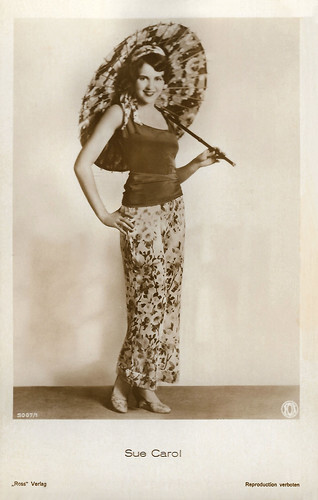
German postcard by Ross Verlag, no. 5007/1, 1930-1931, distributed in Italy by Casa Editrice Ballerini & Fratini, Firenze. Photo: Fox.
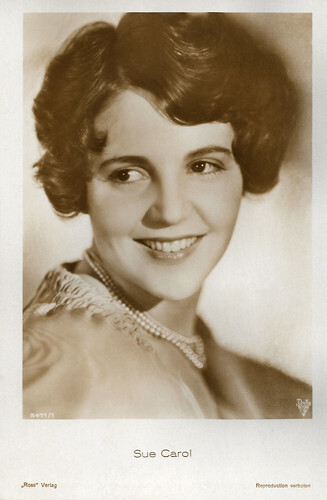
German postcard by Ross Verlag, no. 5471/1, 1930-1931. Photo: Radio Pictures.
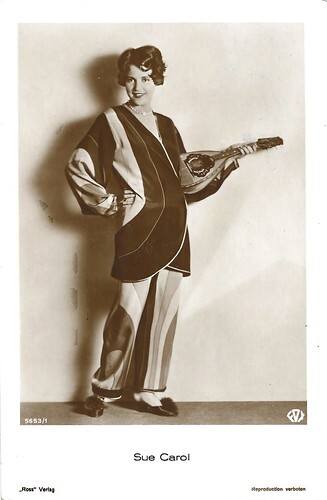
German postcard by Ross Verlag, no. 5658/1, 1930-1931. Photo: Fox.
Sources: Wikipedia and .

German postcard by Ross Verlag Foreign, no. 3727/1, 1928-1929. Photo: PDC.

German postcard by Ross Verlag, no. 4178/1, 1929-1930. Photo: Fox.

French postcard by Cinémagazine-Edition, Paris, no. 721, sent by mail in 1931.
One of the WAMPAS Baby Stars of 1928
Sue Carol was born Evelyn Jean Lederer in 1906 in Chicago, Illinois. Her parents were Samuel Lederer and Caroline Lederer née Schmidt, Jewish emigrants from Austria and Germany, respectively.
While Carol was in Hollywood on vacation, a director offered her a screen test that resulted in a contract with Fox. In 1927, she began playing minor parts in such films as the silent comedy-drama Slaves of Beauty (John G. Blystone, 1927). She had a major part in the comedy Soft Cushions (Edward F. Cline, 1927), now considered lost.
She became one of the WAMPAS Baby Stars in 1928. The WAMPAS Baby Stars was a promotional campaign sponsored by the United States Western Association of Motion Picture Advertisers, which honoured 13 young actresses each year whom they believed to be on the threshold of movie stardom.
Her next films were made in association with producer Cecil B. DeMille such as Skyscraper (Howard Higgin, 1928) starring William Boyd and the silent drama Walking Back (Rupert Julian, 1928) in which she starred as a bob-haired flapper. For Metro-Goldwyn-Mayer, she starred in the silent drama Beau Broadway (Malcolm St. Clair, 1928) with Lew Cody and Aileen Pringle. For Fox, she made the comedy Win That Girl (David Butler, 1928) with synchronised sound. Both films are considered lost now.
Among her other films for Fox are the musical Fox Movietone Follies of 1929 (David Butler, Marcel Silver, 1929) and the melodrama Girls Gone Wild (Lewis Seiler, 1929), which was released in sound and silent versions. The latter film starred Carol with Nick Stuart. Being an up-and-coming young film duo, they were moulded by Fox in the Janet Gaynor / Charles Farrell tradition. The two would be married later in the year, in November, in a surprise ceremony.

British postcard in the Picturegoer Series, London, no. 379a.

Austrian postcard by Iris Verlag, no. 5688. Photo: Max Munn Autrey / Fox.

German postcard by Ross Verlag, no. 4397/1, 1929-1930. Photo: Fox. Collection: Marlene Pilaete.

German postcard by Ross Verlag, no. 5411/1, 1930-1931. Photo: RKO Radio Pictures. Charles Morton and Sue Carol in Check and Double Check (Melville W. Brown, 1930).
Wife and manager of Alan Ladd
Sue Carol co-starred with George O'Brien in the Western The Lone Star Ranger (A.F. Erickson, 1930) based on a novel by Zane Grey. With Dixie Lee, she co-starred in the popular comedy The Big Party (John G. Blystone, 1930). In the next years followed fewer and minor films. Denny Jackson at IMDb : "While she didn't land the roles her contemporaries did, Sue was a very competent actress."
She retired from acting in 1937. After retiring, Carol established her talent agency, the Sue Carol Agency. She married four times. In 1924, Carol married Allen H. Keefer, a buyer for a Chicago stockyard firm. They divorced in early 1929. In July 1929, Carol became engaged to actor Nick Stuart, and the couple married that November. They had a daughter, actress Carol Lee Ladd (1932), who was briefly married to actor Richard Anderson.
In 1933, Sue Carol was cleared in a case involving the disappearance of a baby from a Brooklyn, New York, family. The family had complained that the baby had been taken for adoption in November 1932 by a woman who said she was acting on behalf of Carol. The Stuarts divorced in 1934. In 1936 in Los Angeles, Carol married for the third time to fellow actor William Harold Wilson. That marriage also ended in divorce in 1942.
She married actor Alan Ladd in 1942, in Mexico. They had a son, producer David Ladd, and a daughter, Alana Ladd Jackson who married radio commentator Michael Jackson. Actress Jordan Ladd is one of their grandchildren. Carol was also the stepmother of Alan Ladd, Jr.
Sue Carol was Alan Ladd 's manager until he died in 1964. Sue Carol died in 1982, in Los Angeles, California, from a heart attack. She was 75. Carol was interred next to Alan Ladd in the Forest Lawn Memorial Park Cemetery in Glendale, California. For her contribution to the motion picture industry, she was honoured in 1982 with a star on the Hollywood Walk of Fame at 1639 N. Vine Street.

German postcard by Ross Verlag, no. 5007/1, 1930-1931, distributed in Italy by Casa Editrice Ballerini & Fratini, Firenze. Photo: Fox.

German postcard by Ross Verlag, no. 5471/1, 1930-1931. Photo: Radio Pictures.

German postcard by Ross Verlag, no. 5658/1, 1930-1931. Photo: Fox.
Sources: Wikipedia and .
Published on March 05, 2024 22:00
March 4, 2024
Nicolas Cage
Nicolas Cage (1964) is an American film actor and producer, who often plays eccentric wisecracking characters. His breakthrough came at the end of the 1980s with the Oscar-winning comedy Moonstruck (1988) and David Lynch's Wild at Heart (1990), which was awarded Best Film at the Cannes Film Festival. Cage won the Oscar for Best Actor with Leaving Las Vegas (1995). The action films The Rock (1996), Con Air (1997), Face/Off (1997) and Gone in 60 Seconds (2000) gave him four of his biggest box-office successes in the years that followed. He received another Oscar nomination for his performance as twins Charlie and Donald Kaufman in Spike Jonze's Adaptation (2002).
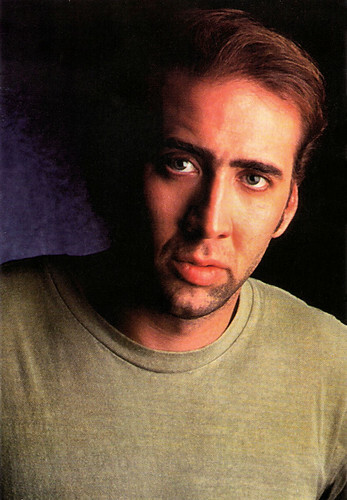
British postcard by Pyramid, no. PC 8340.
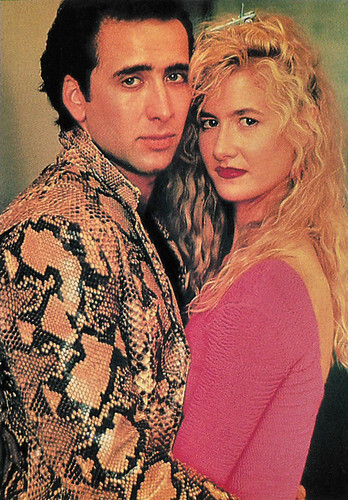
French postcard by Sonis, no. C. 146. Photo: BAC Films. Nicolas Cage and Laura Dern in Wild at Heart (David Lynch, 1990).
A passion for method acting
Nicolas Kim Coppola was born in Long Beach, California, in 1964. He was the son of comparative literature professor August Coppola and dancer and choreographer Joy Vogelsang. His grandfather is the composer Carmine Coppola and his father is the brother of director Francis Ford Coppola and actress Talia Shire. His mother suffered from severe depression, which also led to hospitalisation. His parents divorced in 1976, but Nicolas always connected with his mother.
Nic was interested in the film business from an early age. He took professional acting lessons at the age of 15. Two years later, he dropped out of high school to concentrate on his career. Nicolas had a small role in his film debut Fast Times at Ridgemont High (Amy Heckerling, 1982), starring Sean Penn and Jennifer Jason Leigh. Most of his part was cut, dashing his hopes and leading to a job selling popcorn at the Fairfax Theater, thinking that would be the only route to a movie career.
A job reading lines with actors auditioning for Uncle Francis' Rumble Fish (Francis Ford Coppola, 1983) landed him a role in that film. He changed his name to avoid taking advantage of his uncle's success and being accused of nepotism. He chose the name 'Cage' after comic book hero Luke Cage and the avant-garde artist John Cage.
The same year, he broke through with a lead role as a punk rocker in the comedy Valley Girl (Martha Coolidge, 1983). Many films followed. For his role in Birdy (Alan Parker, 1984) with Matthew Modine, he had a tooth extracted without anaesthetic to immerse himself in his role. His passion for method acting reached a personal limit when he smashed a street vendor's remote-control car to achieve the sense of rage needed for his gangster character in The Cotton Club (Francis Ford Coppola, 1984).
In 1987, he starred in two of the most successful films of that year, proving his status as a major actor. In the Coen Brothers' Raising Arizona (Joel Coen, 1987), he played a dim-witted crook with a heart of gold who wants to start a family with police agent Holly Hunter. In Moonstruck (Norman Jewison, 1987), he plays the man Cher falls in love with. The latter film earned him many female admirers and a Golden Globe nomination.
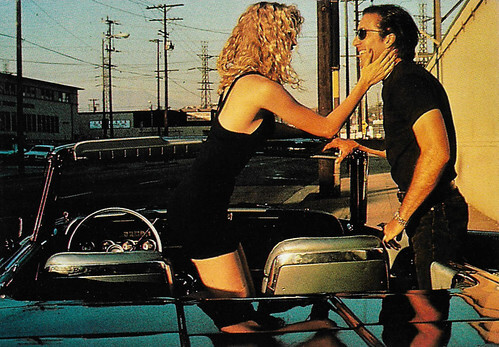
French postcard by Sonis, no. C. 146. Photo: BAC Films. Nicolas Cage and Laura Dern in Wild at Heart (David Lynch, 1990).
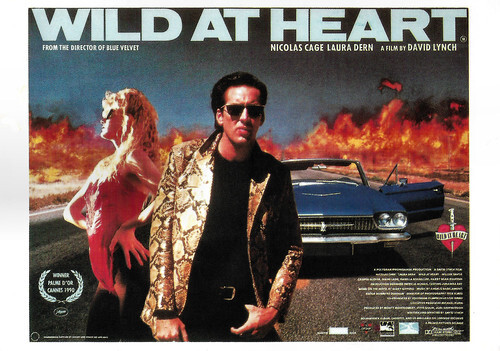
Vintage postcard, no. Z 1064. Image: British poster for Wild at Heart (David Lynch, 1990) with Nicolas Cage and Laura Dern. Caption: From the director of Blue Velvet.
A suicidal alcoholic who falls in love with a prostitute
In 1990, Nicolas Cage played a violent Elvis fan in David Lynch's Wild at Heart. Another important role was Leaving Las Vegas (1995), in which he plays a suicidal alcoholic who falls in love with a prostitute (played by Elisabeth Shue) in Las Vegas. For his role in Leaving Las Vegas, Nicolas Cage received the Academy Award for Best Actor.
After proving himself as a serious actor in 1995, a series of big-budget action films followed, such as The Rock (Michael Bay, 1996), Con Air (Simon West, 1996) and Face/Off (John Woo, 1997) with John Travolta . He played an angel who fell in love with Meg Ryan in City of Angels (Brad Silberling, 1998) and returned to action films with Gone in 60 Seconds (Dominic Sena, 2000).
In the 21st century, he also started a new career, as a film producer. Among others, he produced The Life of David Gale (Alan Parker, 2003), with Kate Winslet and Kevin Spacey. He played a heavy double role in Spike Jonze's Adaptation (2002) - both scriptwriter Charlie Kaufman and his (fictional) brother Donald. For this role, he received his second Oscar nomination.
In World Trade Center (Oliver Stone, 2006), he played Brigadier John McLoughlin who became trapped under the collapsed WTC for three days. Ghost Rider: Spirit of Vengeance (Mark Neveldine, Brian Taylor, 2012) was the sequel to the Marvel comic adaptation Ghost Rider (Mark Steven Johnson, 2007). In recent years, Cage has been facing major financial problems. Despite receiving over $150 million in total fees throughout his career, he had run out of funds and owed $14 million in taxes due to his lavish lifestyle (including buying exotic properties) after the housing bubble burst. In 2009, he had to sell two of his houses and several cars and boats. In 2022, Cage stated that he had paid off his debts. He also pointed out in a '60 Minutes' interview that he never went bankrupt to avoid having to pay off the debt.
He earned renewed critical recognition for his starring roles in the action Horror film Mandy (Panos Cosmatos, 2018), the drama Pig (Michael Sarnoski, 2021), the action comedy The Unbearable Weight of Massive Talent (Tom Gormican, 2022) and the comedy fantasy Dream Scenario (Kristoffer Borgli, 2023). Cage was married to actress Patricia Arquette (1995-2001), Lisa Marie Presley (2002-2004), Alice Kim (2004-2016) and make-up artist Erika Koike (2019), but this marriage was annulled the same year. Cage married Riko Shibata in 2021. He has three sons. His eldest son, with Christina Fulton, Weston Coppola Cage a.k.a. Wes Cage, is the singer and guitarist of the oriental metal band Arsh Anubis. In 2014, Nicolas became a grandfather at age 50 when Weston welcomed a son, Lucian Augustus Coppola Cage. Alice Kim gave birth to Cage's second son Kal-El (2005), named after the Kryptonian name of Superman. Cage is a confessed comic book fan.
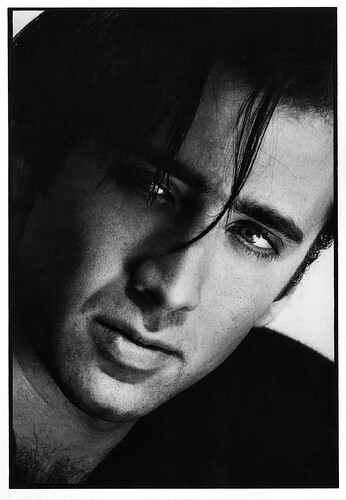
American postcard by Fotofolio, no. F 528. Photo: Greg Gorman. Caption: Nicolas Cage, Los Angeles, 1990. Proceeds from the sale of this card benefitted Make Love, Not Aids.
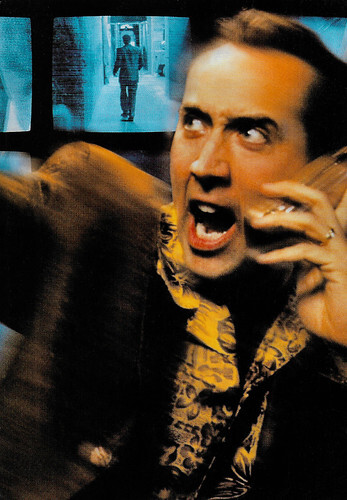
French postcard by Cart.com for Centre Pompidou for the 'Rétrospective intégrale Brian de Palma, 2002. Photo: Gaumont Buena Vista International. Nicolas Cage in Snake Eyes (Brian De Palma, 1998).
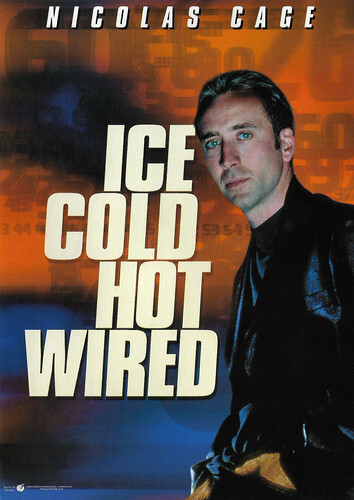
British postcard by Boomerang Media. Photo: Touchstone Pictures. Nicolas Cage in Gone in Sixty Seconds (Brian De Palma, 2000). Caption: Ice cold hot wired.
Sources: (IMDb), Wikipedia (Dutch, German and English) and .

British postcard by Pyramid, no. PC 8340.

French postcard by Sonis, no. C. 146. Photo: BAC Films. Nicolas Cage and Laura Dern in Wild at Heart (David Lynch, 1990).
A passion for method acting
Nicolas Kim Coppola was born in Long Beach, California, in 1964. He was the son of comparative literature professor August Coppola and dancer and choreographer Joy Vogelsang. His grandfather is the composer Carmine Coppola and his father is the brother of director Francis Ford Coppola and actress Talia Shire. His mother suffered from severe depression, which also led to hospitalisation. His parents divorced in 1976, but Nicolas always connected with his mother.
Nic was interested in the film business from an early age. He took professional acting lessons at the age of 15. Two years later, he dropped out of high school to concentrate on his career. Nicolas had a small role in his film debut Fast Times at Ridgemont High (Amy Heckerling, 1982), starring Sean Penn and Jennifer Jason Leigh. Most of his part was cut, dashing his hopes and leading to a job selling popcorn at the Fairfax Theater, thinking that would be the only route to a movie career.
A job reading lines with actors auditioning for Uncle Francis' Rumble Fish (Francis Ford Coppola, 1983) landed him a role in that film. He changed his name to avoid taking advantage of his uncle's success and being accused of nepotism. He chose the name 'Cage' after comic book hero Luke Cage and the avant-garde artist John Cage.
The same year, he broke through with a lead role as a punk rocker in the comedy Valley Girl (Martha Coolidge, 1983). Many films followed. For his role in Birdy (Alan Parker, 1984) with Matthew Modine, he had a tooth extracted without anaesthetic to immerse himself in his role. His passion for method acting reached a personal limit when he smashed a street vendor's remote-control car to achieve the sense of rage needed for his gangster character in The Cotton Club (Francis Ford Coppola, 1984).
In 1987, he starred in two of the most successful films of that year, proving his status as a major actor. In the Coen Brothers' Raising Arizona (Joel Coen, 1987), he played a dim-witted crook with a heart of gold who wants to start a family with police agent Holly Hunter. In Moonstruck (Norman Jewison, 1987), he plays the man Cher falls in love with. The latter film earned him many female admirers and a Golden Globe nomination.

French postcard by Sonis, no. C. 146. Photo: BAC Films. Nicolas Cage and Laura Dern in Wild at Heart (David Lynch, 1990).

Vintage postcard, no. Z 1064. Image: British poster for Wild at Heart (David Lynch, 1990) with Nicolas Cage and Laura Dern. Caption: From the director of Blue Velvet.
A suicidal alcoholic who falls in love with a prostitute
In 1990, Nicolas Cage played a violent Elvis fan in David Lynch's Wild at Heart. Another important role was Leaving Las Vegas (1995), in which he plays a suicidal alcoholic who falls in love with a prostitute (played by Elisabeth Shue) in Las Vegas. For his role in Leaving Las Vegas, Nicolas Cage received the Academy Award for Best Actor.
After proving himself as a serious actor in 1995, a series of big-budget action films followed, such as The Rock (Michael Bay, 1996), Con Air (Simon West, 1996) and Face/Off (John Woo, 1997) with John Travolta . He played an angel who fell in love with Meg Ryan in City of Angels (Brad Silberling, 1998) and returned to action films with Gone in 60 Seconds (Dominic Sena, 2000).
In the 21st century, he also started a new career, as a film producer. Among others, he produced The Life of David Gale (Alan Parker, 2003), with Kate Winslet and Kevin Spacey. He played a heavy double role in Spike Jonze's Adaptation (2002) - both scriptwriter Charlie Kaufman and his (fictional) brother Donald. For this role, he received his second Oscar nomination.
In World Trade Center (Oliver Stone, 2006), he played Brigadier John McLoughlin who became trapped under the collapsed WTC for three days. Ghost Rider: Spirit of Vengeance (Mark Neveldine, Brian Taylor, 2012) was the sequel to the Marvel comic adaptation Ghost Rider (Mark Steven Johnson, 2007). In recent years, Cage has been facing major financial problems. Despite receiving over $150 million in total fees throughout his career, he had run out of funds and owed $14 million in taxes due to his lavish lifestyle (including buying exotic properties) after the housing bubble burst. In 2009, he had to sell two of his houses and several cars and boats. In 2022, Cage stated that he had paid off his debts. He also pointed out in a '60 Minutes' interview that he never went bankrupt to avoid having to pay off the debt.
He earned renewed critical recognition for his starring roles in the action Horror film Mandy (Panos Cosmatos, 2018), the drama Pig (Michael Sarnoski, 2021), the action comedy The Unbearable Weight of Massive Talent (Tom Gormican, 2022) and the comedy fantasy Dream Scenario (Kristoffer Borgli, 2023). Cage was married to actress Patricia Arquette (1995-2001), Lisa Marie Presley (2002-2004), Alice Kim (2004-2016) and make-up artist Erika Koike (2019), but this marriage was annulled the same year. Cage married Riko Shibata in 2021. He has three sons. His eldest son, with Christina Fulton, Weston Coppola Cage a.k.a. Wes Cage, is the singer and guitarist of the oriental metal band Arsh Anubis. In 2014, Nicolas became a grandfather at age 50 when Weston welcomed a son, Lucian Augustus Coppola Cage. Alice Kim gave birth to Cage's second son Kal-El (2005), named after the Kryptonian name of Superman. Cage is a confessed comic book fan.

American postcard by Fotofolio, no. F 528. Photo: Greg Gorman. Caption: Nicolas Cage, Los Angeles, 1990. Proceeds from the sale of this card benefitted Make Love, Not Aids.

French postcard by Cart.com for Centre Pompidou for the 'Rétrospective intégrale Brian de Palma, 2002. Photo: Gaumont Buena Vista International. Nicolas Cage in Snake Eyes (Brian De Palma, 1998).

British postcard by Boomerang Media. Photo: Touchstone Pictures. Nicolas Cage in Gone in Sixty Seconds (Brian De Palma, 2000). Caption: Ice cold hot wired.
Sources: (IMDb), Wikipedia (Dutch, German and English) and .
Published on March 04, 2024 22:00
March 3, 2024
Directed by James Whale
In March, EFSP will focus on one of our favourite filmmakers, British director James Whale (1889-1957). Although he also made films for other genres, he is best known for his four Horror films, Frankenstein (1931), The Old Dark House (1932), The Invisible Man (1933) and Bride of Frankenstein (1935). Whale is considered the father of the classic Hollywood Horror film and he developed a style characterised by the influence of German Expressionism and a highly mobile camera. EFSP will present three film specials later this month, Frankenstein (1931), the mystery The Kiss Before the Mirror (1932) and Bride of Frankenstein (1935).
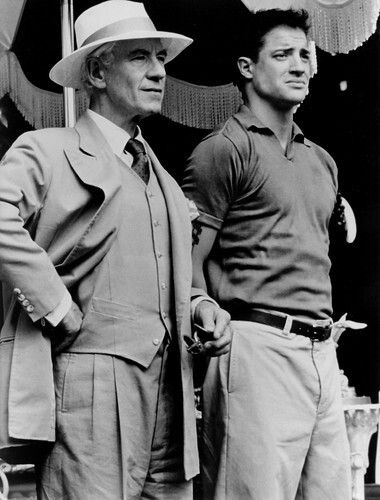
Vintage press photo. Ian McKellen as James Whale and Brendan Fraser in Gods and Monsters (Bill Condon, 1998).

American postcard by Classico San Francisco, no. 233/01. Photo: Universal Pictures. Boris Karloff in Frankenstein (James Whale, 1931).
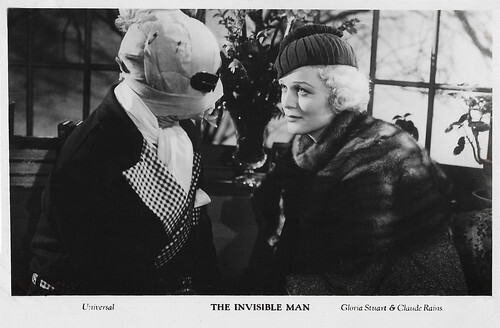
British postcard in the Filmshots series by Film Weekly. Photo: Universal. Gloria Stuart and Claude Rains in The Invisible Man (James Whale, 1933).
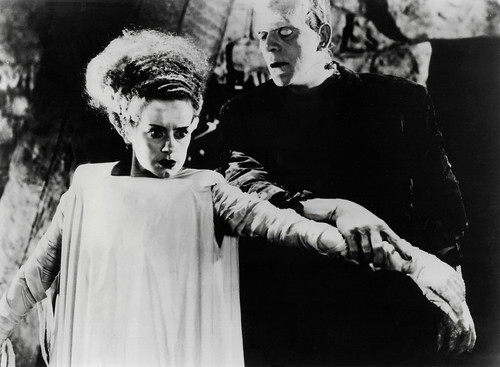
Dutch press photo. Elsa Lanchester and Boris Karloff in Bride of Frankenstein (James Whale, 1935).
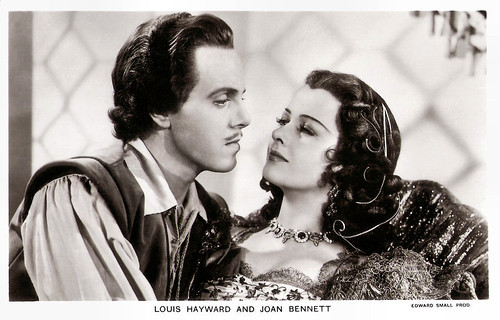
British postcard in the Film Partners Series, London, no. P. 306. Photo: Edward Small Prod. Louis Hayward and Joan Bennett in The Man in the Iron Mask (James Whale, 1939).
Journey's End
James Whale was born in Dudley, England in 1889. He was the sixth of seven children of blast furnace worker William Whale and his wife Sarah, a nurse. While his childhood in the West Midlands was characterised by the family's poverty, he decided not to become a worker in the local heavy industry like his brothers. He had to leave school at the age of thirteen to work. Juggling odd jobs, he gradually discovered a passion for drawing and painting and found work as a cartoonist for The Bystander magazine.
The First World War broke out when he was not yet 25. He joined the army and was taken prisoner of war as a non-commissioned officer in 1917. Imprisoned in a camp, he discovered his passion for theatre. This experience was a revelation for him. After a few attempts as an actor, he began a career as a set designer for the theatre. However, it was not until he was 40 that he had his first opportunity to direct a play.
In 1928 Whale was offered the opportunity to direct two private performances of R. C. Sherriff's then-unknown anti-war play 'Journey's End' for the Incorporated Stage Society, a theatre society that mounted private Sunday performances of plays. Set over four days in March 1918 in the trenches at Saint-Quentin, France, 'Journey's End' gives a glimpse into the experiences of the officers of a British infantry company in World War I. The key conflict is between Capt. Stanhope, the company commander, and Lt. Raleigh, the brother of Stanhope's fiancée. Whale offered the part of Stanhope to the then-barely-known Laurence Olivier . Olivier initially declined the role, but after meeting the playwright agreed to take it on. Maurice Evans was cast as Raleigh.
The play was well received and transferred to the Savoy Theatre in London's West End, opening on 21 January 1929. Colin Clive was now in the lead role, Olivier having accepted an offer to take the lead in a production of 'Beau Geste'. 'Journey's End' was a tremendous success, with critics uniform and effusive in their praise and with audiences sometimes sitting in stunned silence following its conclusion only to burst into thunderous ovations. The play had more than 500 performances. In the same year, Whale directed and designed the set for the plays 'Fortunato and the Lady from Alfaqueque' and 'The Dreamers' with John Gielgud , before being invited to stage 'Journey's End' on Broadway in 1929. The play was also successful in the USA and Whale made the leap to film as dialogue director for The Love Doctor (Melville W. Brown, 1929) starring Richard Dix . He went on to direct the stage productions of R. C. Sherriff's ‘Badger's Green’ and the two one-act plays ‘The Violet’ and ‘One Two Three’ by Ferenc Molnár.
Whale was also responsible as dialogue director for some of the interior shots of independent film producer and aviation pioneer Howard Hughes' World War I aerial drama Hell's Angels (1930) with Jean Harlow , which cost 3.95 million US dollars at the time. Having purchased the film rights to 'Journey's End', British producers Michael Balcon and Thomas Welsh agreed that Whale's experience directing the London and Broadway productions of the play made him the best choice to direct the film. The two partnered with a small American studio, Tiffany-Stahl, to shoot it in New York. Colin Clive reprised his role as Stanhope, and David Manners was cast as Raleigh. On both sides of the Atlantic Journey’s End (James Whale, 1930) was a tremendous critical and commercial success. As Whale biographer James Curtis wrote, Journey’s End "managed to coalesce, at the right time and in the right manner, the impressions of a whole generation of men who were in the war and who had found it impossible, through words or deeds, to adequately express to their friends and families what the trenches had been like."

American postcard by American Postcard, no. 38. Boris Karloff and Mae Clarke in Frankenstein (James Whale, 1931).

American postcard by Classico San Francisco, no. 233/06. Photo: Roman Freulich / Universal Pictures. Boris Karloff in Frankenstein (James Whale, 1931).

American postcard by Zoetrope Images Ltd., Boston, no 432. Photo: Boris Karloff in Frankenstein (James Whale, 1931).

British postcard in the Film Weekly series. Photo: Universal. Nancy Carroll and Frank Morgan in The Kiss Before the Mirror (James Whale, 1932).
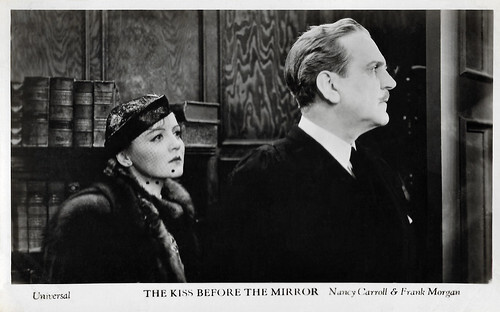
British postcard in the Film Weekly series. Photo: Universal. Nancy Carroll and Frank Morgan in The Kiss Before the Mirror (James Whale, 1932).
Frankenstein
In 1931 Universal Pictures signed James Whale to a five-year contract and his first project was Waterloo Bridge (1931) starring Mae Clarke and Douglass Montgomery. It is the first film adaptation of Robert E. Sherwood's play of the same name. The film tells the story of a tragic romance between a Canadian soldier who falls in love with an English woman during his stay in London, unaware that she is a prostitute. It too was a critical and popular success.
Universal chief Carl Laemmle Jr. then offered Whale his choice of any property the studio owned. Whale chose Frankenstein (1931). Following the success of Dracula (Todd Browning, 1930), Universal commissioned French director Robert Florey to write a screenplay for Mary Shelley's novel 'Frankenstein or the Modern Prometheus'. However, the sequences directed by Florey were not to the studio’s liking and Universal decided that James Whale was to direct. Whale insisted that Colin Clive be given the part of Dr Frankenstein and he cast Mae Clarke as his fiancée Elizabeth. Whale gave the role of the monster, for which the Dracula actor Bela Lugosi had originally been in discussion, to the little-known 42-year-old British theatre and film actor Boris Karloff , who had wide-ranging experience in supporting roles.
The production, estimated at 291,000 US dollars, made a huge profit and is still considered one of the most important Horror films to this day. Frankenstein (1931) made Boris Karloff a star overnight and James Whale one of Universal Studios' leading directors. Universal insisted on entrusting Whale with further Horror films. After the drama Impatient Maiden (1931), Whale directed the Horror film The Old Dark (1932), based on a novel by John Boynton Priestley. Boris Karloff once again played the lead role of a bestial servant who terrifies a group of travellers in a Welsh country house.
The mystery The Kiss Before the Mirror (1932), starring Nancy Carroll , Frank Morgan, Paul Lukas and Gloria Stuart , was a critical success but a box-office failure and was followed by The Invisible Man (1933). In this film adaptation of a novel by H. G. Wells, Claude Rains plays a scientist who mutates into an invisible, insane murderer thanks to a formula he has developed. Shot from a script approved by Wells, the film blended horror with humour and confounding visual effects. It was critically acclaimed, with The New York Times listing it as one of the ten best films of the year, and it broke box-office records in cities across America. That same year, Whale directed the delicious romantic comedy By Candlelight (1933) with Elissa Landi and Paul Lukas . In 1934 he directed One More River, an adaptation of the novel of the same name by John Galsworthy. The film tells the story of a woman desperate to escape her abusive marriage to a member of the British aristocracy.
With the sequel Bride of Frankenstein (1935), in which Elsa Lanchester plays the title role alongside Boris Karloff , Whale maintained his reputation as one of the most important directors of the Horror genre. Bride is frequently hailed as Whale's masterpiece and one of the best Gothic Horror films ever. Whale then adapted the novel 'The Hangover Murders', a comedy mystery in the style of 'The Thin Man', about a group of friends who were so drunk the night one of them was murdered that none can remember anything. Retitled Remember Last Night? (1935), the film was one of Whale's personal favourites. Then followed another of the director’s favourites, Show Boat (1936), a graceful adaptation of Oscar Hammerstein's musical of the same name with Irene Dunne and Paul Robeson . It was the last of Whale's films to be produced under the Laemmle family.
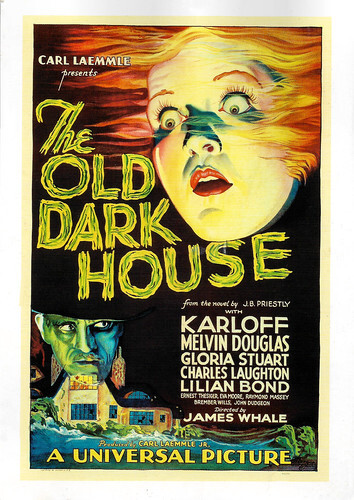
American postcard by The Museum of Modern Art, New York, N.Y., 2001. American poster by Universal for The Old Dark House (James Whale, 1932).
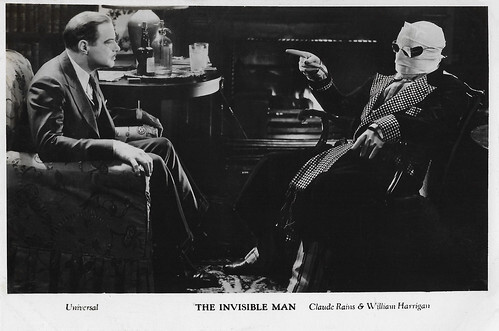
British postcard in the Filmshots series by Film Weekly. Photo: Universal. Claude Rains and William Harrigan in The Invisible Man (James Whale, 1933).
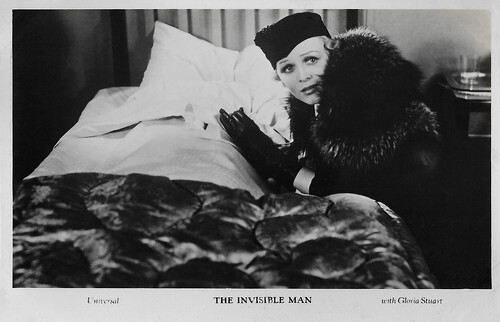
British postcard in the Filmshots series by Film Weekly. Photo: Universal. Gloria Stuart (and Claude Rains ) in The Invisible Man (James Whale, 1933).
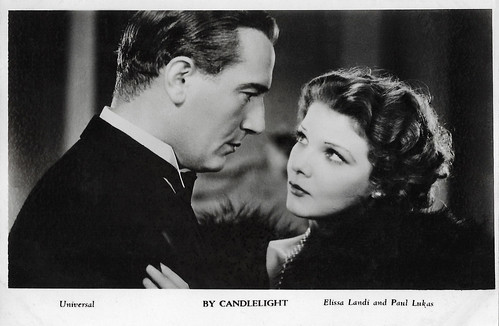
British postcard in the Film Shots series by Film Weekly. Photo: Universal. Paul Lukas and Elissa Landi in By Candlelight (James Whale, 1933).
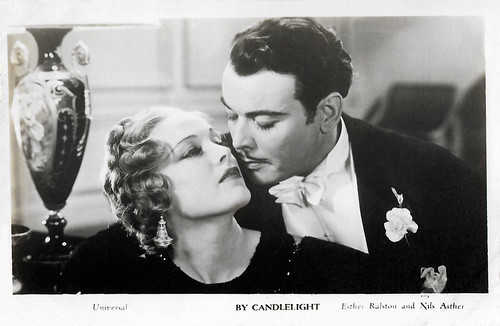
British postcard in the Film Shots series by Film Weekly. Photo: Universal. Nils Asther and Esther Ralston in By Candlelight (James Whale, 1933).
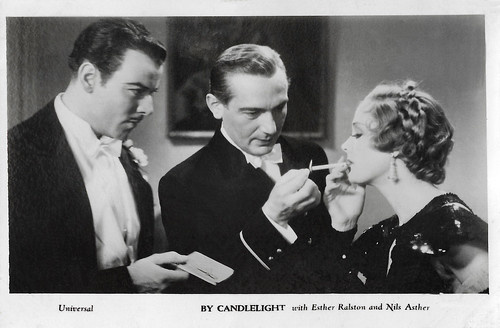
British postcard in the Film Shots series by Film Weekly. Photo: Universal. Nils Asther , Paul Lukas and Esther Ralston in By Candlelight (James Whale, 1933).
The Road Back
The management at Universal Pictures changed due to financial problems. Although the film studio managed to stave off bankruptcy, the director and founder of Universal, Carl Laemmle and his son, Carl Laemmle, Jr., who had always given James Whale a free hand with his films, were forced to resign and the Standard Capital Company took over the company. In production was the war drama The Road Back, a sequel to its successful predecessor All Quiet on the Western Front (Lewis Milestone, 1930) and based on Erich Maria Remarque's follow-up novel ‘Der Weg zurück’. Combining a strong anti-war message with prescient warnings about the rising dangers of the dictatorship of Nazi Germany, it was intended to be a powerful and controversial picture, and Universal had entrusted it to their finest director, James Whale.
The film was already heavily criticised during production by the Los Angeles consul for Nazi Germany, Georg Gyssling, for its anti-German tendencies. In fact, Whale had adopted the strong anti-Nazi tone of the novel for the adaptation. Whale's original cut of the film was given generally positive reviews, but sometime between preview screenings and the film's general release, the new studio boss Charles Rogers capitulated to the Germans, ordering that cuts be made. He ordered writer Charles Kenyon to interject the script with comedy scenes between Andy Devine and Slim Summerville. Whale was furious about the result, and the altered film was banned in Germany anyway. The Germans were successful in persuading China, Greece, Italy and Switzerland to ban the film as well.
For James Whale, The Road Back (1937) was the last major production he directed. Charles Rogers tried to get out of his contract with Whale, but Whale refused. Disgusted with the studio's cowardice under its new management, Whale only completed Wives Under Suspicion, an unsuccessful remake of his own film The Kiss Before the Mirror (1932). Whale was loaned out to rival film studios Warner Bros. and MGM, for whom he made the romantic comedy The Great Garrick (1937) with Olivia de Havilland and Brian Aherne and the drama Port of Seven Seas (1938) a screen adaptation of Marcel Pagnol's French classic play ‘Fanny’ with Wallace Beery and Frank Morgan.
Whale's career and reputation had declined considerably by the end of the 1930s, but he was still more than enough of a highly skilled craftsman to helm the independent production The Man in the Iron Mask (1939). Bruce Eder at AllMovie : "Producer Edward Small didn't have the kind of money that MGM would have been able to put into a swashbuckler of this sort, but Whale had enough talent to make it look like he did. His clever and graceful camera moves (especially those dolly-shots) make the sets look twice as big and lavish as they ought to have, and his eye for characters and close-ups lends this movie a good level of emotional intensity, helped not a little bit by Louis Hayward 's successful portrayal of a pair of identical (but emotionally and morally very different) twins. Joan Bennett 's Infanta of Spain is not quite as central to the action as one would expect of the leading lady, but she makes the most of her scenes."
Whale's last film for Universal was the adventure film Green Hell (1940) with Douglas Fairbanks Jr. and Joan Bennett . Whale never completed his twentieth and final feature film, They Dare Not Love (1941), about an Austrian prince who flees into exile from the National Socialists and decides to fight against the regime. The film studio Columbia Pictures replaced him with Charles Vidor and only contractual clauses preserved the filmmaker's name in the credits. With the outbreak of World War II, Whale volunteered his services to make a training film for the United States Army. He shot the film, called Personnel Placement in the Army, in February 1942.
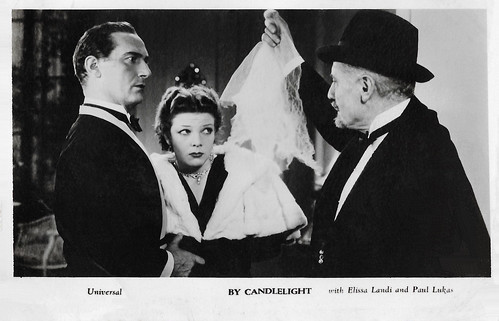
British postcard in the Film Shots series by Film Weekly. Photo: Universal. Paul Lukas and Elissa Landi in By Candlelight (James Whale, 1933).
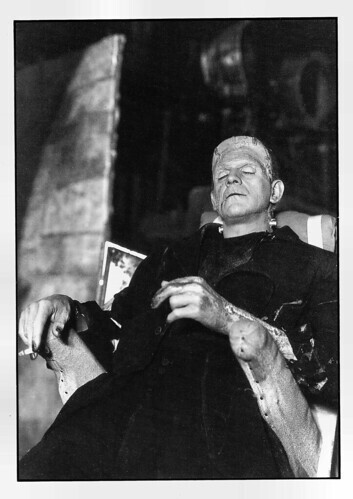
French postcard in the Entr'acte series by Editions aphodèle mâcon, no 001/09. Photo: Boris Karloff relaxing with a cigarette during an interval of the shooting of The Bride of Frankenstein (James Whale, 1935).
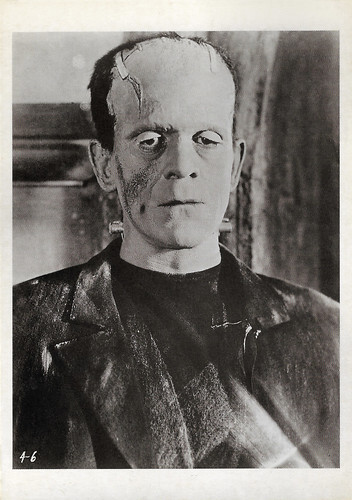
American postcard by American Postcard, no. 36. Boris Karloff in Bride of Frankenstein (James Whale, 1935).
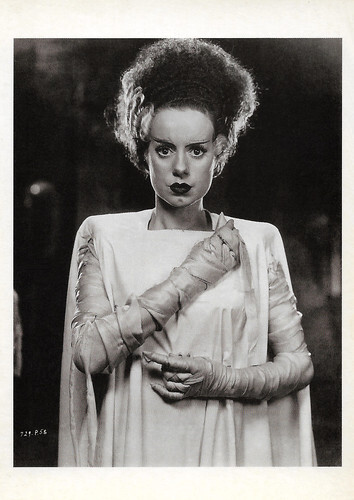
American postcard by American Postcard, no. 41. Elsa Lanchester in Bride of Frankenstein (James Whale, 1935).
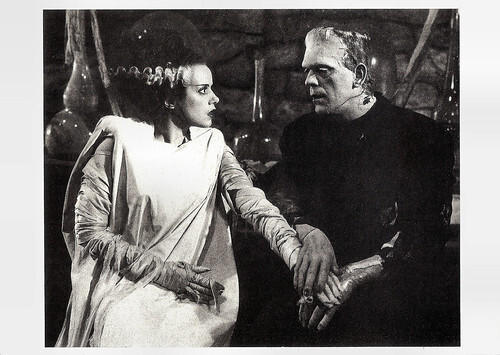
French postcard in the Collection Cinéma by Editions La Malibran, Paris, no. CA 53, 1989. Photo: Boris Karloff and Elsa Lanchester in Bride of Frankenstein (James Whale, 1935).
Gods and Monsters
After the end of his film career, James Whale returned to Broadway in 1944, where he directed the psychological thriller 'Hand in Glove' for the Playhouse Theatre. It was not a success.
In 1949, he took his last seat in the director's chair and made the 41-minute short film Hello Out There, based on a William Saroyan one-act play. It was the story of a man in a Texas jail falsely accused of rape and the woman who cleans the jail. The short was intended to be part of an anthology film for RKO along the lines of Quartet. The film was produced by the American supermarket heir Huntington Hartford to make his then-wife, the actress Marjorie Steele, better known. However, Hartford was unhappy with the result and Hello Out There (1949), made for 41,000 US dollars on a single set at KTTV Studios in Los Angeles, was never commercially released.
Whale's last work as a theatre director was the production of the play 'Pagan in the Parlour' at the Pasadena Playhouse. The play, a farce about two New England spinster sisters who are visited by a Polynesian whom their father, when shipwrecked years earlier, had married, was also performed briefly in England. In Europe, Whale rediscovered his love for painting and travel. His investments had made him wealthy and he lived a comfortable retirement until suffering strokes in 1956 that robbed him of his vigour and left him in pain.
Rumours of homosexuality had always accompanied the formerly celebrated film director. He actually lived openly with his partner David Lewis, an American film producer. After the strokes, Whale suffered from loneliness and depression and drowned in his swimming pool in Santa Monica in 1957 at the age of 67. The circumstances of his death remained a mystery until David Lewis confirmed the rumours of suicide years later. Lewis had found Whale dead, as well as a farewell note that was first printed in James Curtis' biography in 1982. It read "The future is just old age and illness and pain... I must have peace and this is the only way." Whale was buried in the Forest Lawn Memorial Park Cemetery in Glendale, California.
In 1997, the last phase of James Whale's life was made into a film based on the novel 'Father of Frankenstein' (1995) by Christopher Bram. Film and theatre actor Ian McKellen starred as Whale in Gods and Monsters (Bill Condon, 1997) with Brendan Fraser as the fictional gardener Clayton Boone, whom he hired and fell in love with. McKellen was nominated for an Oscar and a Golden Globe for Best Actor in a Leading Role in 1999. In 2002, a memorial statue in the form of a film reel was erected in front of a new multiplex cinema in James Whale's birthplace Dudley.

American postcard by American Postcard, no. 37. Boris Karloff and Mae Clarke in Frankenstein (James Whale, 1931).
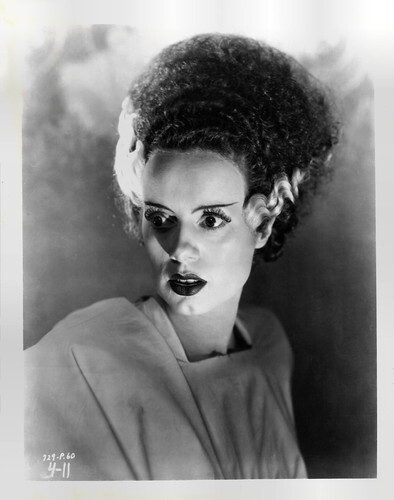
Vintage press photo. Elsa Lanchester in Bride of Frankenstein (James Whale, 1935).
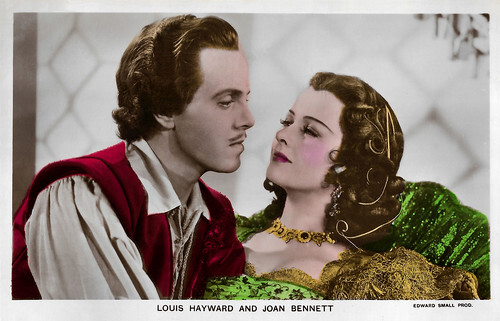
British postcard in the Film Partners Series, London, no. P. 306. Photo: Edward Small Prod. Louis Hayward and Joan Bennett in The Man in the Iron Mask (James Whale, 1939).
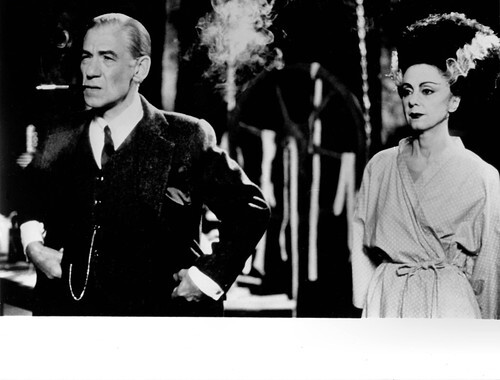
Vintage press photo. Ian McKellen and Rosalind Ayres in Gods and Monsters (Bill Condon, 1998).
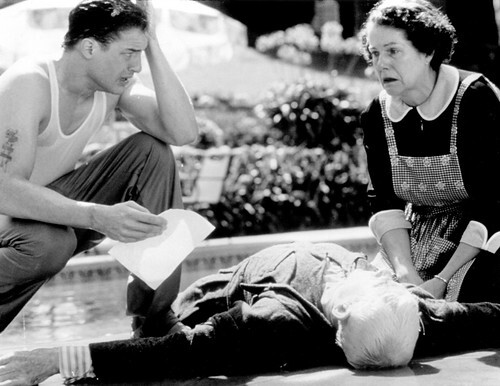
Vintage press photo. Brendan Fraser, Ian McKellen and Lynn Redgrave in Gods and Monsters (Bill Condon, 1998).
Sources: James Curtis (James Whale), Bruce Eder (AllMovie), (IMDb), AllMovie, Wikipedia (Dutch, German, French and English) and .

Vintage press photo. Ian McKellen as James Whale and Brendan Fraser in Gods and Monsters (Bill Condon, 1998).

American postcard by Classico San Francisco, no. 233/01. Photo: Universal Pictures. Boris Karloff in Frankenstein (James Whale, 1931).

British postcard in the Filmshots series by Film Weekly. Photo: Universal. Gloria Stuart and Claude Rains in The Invisible Man (James Whale, 1933).

Dutch press photo. Elsa Lanchester and Boris Karloff in Bride of Frankenstein (James Whale, 1935).

British postcard in the Film Partners Series, London, no. P. 306. Photo: Edward Small Prod. Louis Hayward and Joan Bennett in The Man in the Iron Mask (James Whale, 1939).
Journey's End
James Whale was born in Dudley, England in 1889. He was the sixth of seven children of blast furnace worker William Whale and his wife Sarah, a nurse. While his childhood in the West Midlands was characterised by the family's poverty, he decided not to become a worker in the local heavy industry like his brothers. He had to leave school at the age of thirteen to work. Juggling odd jobs, he gradually discovered a passion for drawing and painting and found work as a cartoonist for The Bystander magazine.
The First World War broke out when he was not yet 25. He joined the army and was taken prisoner of war as a non-commissioned officer in 1917. Imprisoned in a camp, he discovered his passion for theatre. This experience was a revelation for him. After a few attempts as an actor, he began a career as a set designer for the theatre. However, it was not until he was 40 that he had his first opportunity to direct a play.
In 1928 Whale was offered the opportunity to direct two private performances of R. C. Sherriff's then-unknown anti-war play 'Journey's End' for the Incorporated Stage Society, a theatre society that mounted private Sunday performances of plays. Set over four days in March 1918 in the trenches at Saint-Quentin, France, 'Journey's End' gives a glimpse into the experiences of the officers of a British infantry company in World War I. The key conflict is between Capt. Stanhope, the company commander, and Lt. Raleigh, the brother of Stanhope's fiancée. Whale offered the part of Stanhope to the then-barely-known Laurence Olivier . Olivier initially declined the role, but after meeting the playwright agreed to take it on. Maurice Evans was cast as Raleigh.
The play was well received and transferred to the Savoy Theatre in London's West End, opening on 21 January 1929. Colin Clive was now in the lead role, Olivier having accepted an offer to take the lead in a production of 'Beau Geste'. 'Journey's End' was a tremendous success, with critics uniform and effusive in their praise and with audiences sometimes sitting in stunned silence following its conclusion only to burst into thunderous ovations. The play had more than 500 performances. In the same year, Whale directed and designed the set for the plays 'Fortunato and the Lady from Alfaqueque' and 'The Dreamers' with John Gielgud , before being invited to stage 'Journey's End' on Broadway in 1929. The play was also successful in the USA and Whale made the leap to film as dialogue director for The Love Doctor (Melville W. Brown, 1929) starring Richard Dix . He went on to direct the stage productions of R. C. Sherriff's ‘Badger's Green’ and the two one-act plays ‘The Violet’ and ‘One Two Three’ by Ferenc Molnár.
Whale was also responsible as dialogue director for some of the interior shots of independent film producer and aviation pioneer Howard Hughes' World War I aerial drama Hell's Angels (1930) with Jean Harlow , which cost 3.95 million US dollars at the time. Having purchased the film rights to 'Journey's End', British producers Michael Balcon and Thomas Welsh agreed that Whale's experience directing the London and Broadway productions of the play made him the best choice to direct the film. The two partnered with a small American studio, Tiffany-Stahl, to shoot it in New York. Colin Clive reprised his role as Stanhope, and David Manners was cast as Raleigh. On both sides of the Atlantic Journey’s End (James Whale, 1930) was a tremendous critical and commercial success. As Whale biographer James Curtis wrote, Journey’s End "managed to coalesce, at the right time and in the right manner, the impressions of a whole generation of men who were in the war and who had found it impossible, through words or deeds, to adequately express to their friends and families what the trenches had been like."

American postcard by American Postcard, no. 38. Boris Karloff and Mae Clarke in Frankenstein (James Whale, 1931).

American postcard by Classico San Francisco, no. 233/06. Photo: Roman Freulich / Universal Pictures. Boris Karloff in Frankenstein (James Whale, 1931).

American postcard by Zoetrope Images Ltd., Boston, no 432. Photo: Boris Karloff in Frankenstein (James Whale, 1931).

British postcard in the Film Weekly series. Photo: Universal. Nancy Carroll and Frank Morgan in The Kiss Before the Mirror (James Whale, 1932).

British postcard in the Film Weekly series. Photo: Universal. Nancy Carroll and Frank Morgan in The Kiss Before the Mirror (James Whale, 1932).
Frankenstein
In 1931 Universal Pictures signed James Whale to a five-year contract and his first project was Waterloo Bridge (1931) starring Mae Clarke and Douglass Montgomery. It is the first film adaptation of Robert E. Sherwood's play of the same name. The film tells the story of a tragic romance between a Canadian soldier who falls in love with an English woman during his stay in London, unaware that she is a prostitute. It too was a critical and popular success.
Universal chief Carl Laemmle Jr. then offered Whale his choice of any property the studio owned. Whale chose Frankenstein (1931). Following the success of Dracula (Todd Browning, 1930), Universal commissioned French director Robert Florey to write a screenplay for Mary Shelley's novel 'Frankenstein or the Modern Prometheus'. However, the sequences directed by Florey were not to the studio’s liking and Universal decided that James Whale was to direct. Whale insisted that Colin Clive be given the part of Dr Frankenstein and he cast Mae Clarke as his fiancée Elizabeth. Whale gave the role of the monster, for which the Dracula actor Bela Lugosi had originally been in discussion, to the little-known 42-year-old British theatre and film actor Boris Karloff , who had wide-ranging experience in supporting roles.
The production, estimated at 291,000 US dollars, made a huge profit and is still considered one of the most important Horror films to this day. Frankenstein (1931) made Boris Karloff a star overnight and James Whale one of Universal Studios' leading directors. Universal insisted on entrusting Whale with further Horror films. After the drama Impatient Maiden (1931), Whale directed the Horror film The Old Dark (1932), based on a novel by John Boynton Priestley. Boris Karloff once again played the lead role of a bestial servant who terrifies a group of travellers in a Welsh country house.
The mystery The Kiss Before the Mirror (1932), starring Nancy Carroll , Frank Morgan, Paul Lukas and Gloria Stuart , was a critical success but a box-office failure and was followed by The Invisible Man (1933). In this film adaptation of a novel by H. G. Wells, Claude Rains plays a scientist who mutates into an invisible, insane murderer thanks to a formula he has developed. Shot from a script approved by Wells, the film blended horror with humour and confounding visual effects. It was critically acclaimed, with The New York Times listing it as one of the ten best films of the year, and it broke box-office records in cities across America. That same year, Whale directed the delicious romantic comedy By Candlelight (1933) with Elissa Landi and Paul Lukas . In 1934 he directed One More River, an adaptation of the novel of the same name by John Galsworthy. The film tells the story of a woman desperate to escape her abusive marriage to a member of the British aristocracy.
With the sequel Bride of Frankenstein (1935), in which Elsa Lanchester plays the title role alongside Boris Karloff , Whale maintained his reputation as one of the most important directors of the Horror genre. Bride is frequently hailed as Whale's masterpiece and one of the best Gothic Horror films ever. Whale then adapted the novel 'The Hangover Murders', a comedy mystery in the style of 'The Thin Man', about a group of friends who were so drunk the night one of them was murdered that none can remember anything. Retitled Remember Last Night? (1935), the film was one of Whale's personal favourites. Then followed another of the director’s favourites, Show Boat (1936), a graceful adaptation of Oscar Hammerstein's musical of the same name with Irene Dunne and Paul Robeson . It was the last of Whale's films to be produced under the Laemmle family.

American postcard by The Museum of Modern Art, New York, N.Y., 2001. American poster by Universal for The Old Dark House (James Whale, 1932).

British postcard in the Filmshots series by Film Weekly. Photo: Universal. Claude Rains and William Harrigan in The Invisible Man (James Whale, 1933).

British postcard in the Filmshots series by Film Weekly. Photo: Universal. Gloria Stuart (and Claude Rains ) in The Invisible Man (James Whale, 1933).

British postcard in the Film Shots series by Film Weekly. Photo: Universal. Paul Lukas and Elissa Landi in By Candlelight (James Whale, 1933).

British postcard in the Film Shots series by Film Weekly. Photo: Universal. Nils Asther and Esther Ralston in By Candlelight (James Whale, 1933).

British postcard in the Film Shots series by Film Weekly. Photo: Universal. Nils Asther , Paul Lukas and Esther Ralston in By Candlelight (James Whale, 1933).
The Road Back
The management at Universal Pictures changed due to financial problems. Although the film studio managed to stave off bankruptcy, the director and founder of Universal, Carl Laemmle and his son, Carl Laemmle, Jr., who had always given James Whale a free hand with his films, were forced to resign and the Standard Capital Company took over the company. In production was the war drama The Road Back, a sequel to its successful predecessor All Quiet on the Western Front (Lewis Milestone, 1930) and based on Erich Maria Remarque's follow-up novel ‘Der Weg zurück’. Combining a strong anti-war message with prescient warnings about the rising dangers of the dictatorship of Nazi Germany, it was intended to be a powerful and controversial picture, and Universal had entrusted it to their finest director, James Whale.
The film was already heavily criticised during production by the Los Angeles consul for Nazi Germany, Georg Gyssling, for its anti-German tendencies. In fact, Whale had adopted the strong anti-Nazi tone of the novel for the adaptation. Whale's original cut of the film was given generally positive reviews, but sometime between preview screenings and the film's general release, the new studio boss Charles Rogers capitulated to the Germans, ordering that cuts be made. He ordered writer Charles Kenyon to interject the script with comedy scenes between Andy Devine and Slim Summerville. Whale was furious about the result, and the altered film was banned in Germany anyway. The Germans were successful in persuading China, Greece, Italy and Switzerland to ban the film as well.
For James Whale, The Road Back (1937) was the last major production he directed. Charles Rogers tried to get out of his contract with Whale, but Whale refused. Disgusted with the studio's cowardice under its new management, Whale only completed Wives Under Suspicion, an unsuccessful remake of his own film The Kiss Before the Mirror (1932). Whale was loaned out to rival film studios Warner Bros. and MGM, for whom he made the romantic comedy The Great Garrick (1937) with Olivia de Havilland and Brian Aherne and the drama Port of Seven Seas (1938) a screen adaptation of Marcel Pagnol's French classic play ‘Fanny’ with Wallace Beery and Frank Morgan.
Whale's career and reputation had declined considerably by the end of the 1930s, but he was still more than enough of a highly skilled craftsman to helm the independent production The Man in the Iron Mask (1939). Bruce Eder at AllMovie : "Producer Edward Small didn't have the kind of money that MGM would have been able to put into a swashbuckler of this sort, but Whale had enough talent to make it look like he did. His clever and graceful camera moves (especially those dolly-shots) make the sets look twice as big and lavish as they ought to have, and his eye for characters and close-ups lends this movie a good level of emotional intensity, helped not a little bit by Louis Hayward 's successful portrayal of a pair of identical (but emotionally and morally very different) twins. Joan Bennett 's Infanta of Spain is not quite as central to the action as one would expect of the leading lady, but she makes the most of her scenes."
Whale's last film for Universal was the adventure film Green Hell (1940) with Douglas Fairbanks Jr. and Joan Bennett . Whale never completed his twentieth and final feature film, They Dare Not Love (1941), about an Austrian prince who flees into exile from the National Socialists and decides to fight against the regime. The film studio Columbia Pictures replaced him with Charles Vidor and only contractual clauses preserved the filmmaker's name in the credits. With the outbreak of World War II, Whale volunteered his services to make a training film for the United States Army. He shot the film, called Personnel Placement in the Army, in February 1942.

British postcard in the Film Shots series by Film Weekly. Photo: Universal. Paul Lukas and Elissa Landi in By Candlelight (James Whale, 1933).

French postcard in the Entr'acte series by Editions aphodèle mâcon, no 001/09. Photo: Boris Karloff relaxing with a cigarette during an interval of the shooting of The Bride of Frankenstein (James Whale, 1935).

American postcard by American Postcard, no. 36. Boris Karloff in Bride of Frankenstein (James Whale, 1935).

American postcard by American Postcard, no. 41. Elsa Lanchester in Bride of Frankenstein (James Whale, 1935).

French postcard in the Collection Cinéma by Editions La Malibran, Paris, no. CA 53, 1989. Photo: Boris Karloff and Elsa Lanchester in Bride of Frankenstein (James Whale, 1935).
Gods and Monsters
After the end of his film career, James Whale returned to Broadway in 1944, where he directed the psychological thriller 'Hand in Glove' for the Playhouse Theatre. It was not a success.
In 1949, he took his last seat in the director's chair and made the 41-minute short film Hello Out There, based on a William Saroyan one-act play. It was the story of a man in a Texas jail falsely accused of rape and the woman who cleans the jail. The short was intended to be part of an anthology film for RKO along the lines of Quartet. The film was produced by the American supermarket heir Huntington Hartford to make his then-wife, the actress Marjorie Steele, better known. However, Hartford was unhappy with the result and Hello Out There (1949), made for 41,000 US dollars on a single set at KTTV Studios in Los Angeles, was never commercially released.
Whale's last work as a theatre director was the production of the play 'Pagan in the Parlour' at the Pasadena Playhouse. The play, a farce about two New England spinster sisters who are visited by a Polynesian whom their father, when shipwrecked years earlier, had married, was also performed briefly in England. In Europe, Whale rediscovered his love for painting and travel. His investments had made him wealthy and he lived a comfortable retirement until suffering strokes in 1956 that robbed him of his vigour and left him in pain.
Rumours of homosexuality had always accompanied the formerly celebrated film director. He actually lived openly with his partner David Lewis, an American film producer. After the strokes, Whale suffered from loneliness and depression and drowned in his swimming pool in Santa Monica in 1957 at the age of 67. The circumstances of his death remained a mystery until David Lewis confirmed the rumours of suicide years later. Lewis had found Whale dead, as well as a farewell note that was first printed in James Curtis' biography in 1982. It read "The future is just old age and illness and pain... I must have peace and this is the only way." Whale was buried in the Forest Lawn Memorial Park Cemetery in Glendale, California.
In 1997, the last phase of James Whale's life was made into a film based on the novel 'Father of Frankenstein' (1995) by Christopher Bram. Film and theatre actor Ian McKellen starred as Whale in Gods and Monsters (Bill Condon, 1997) with Brendan Fraser as the fictional gardener Clayton Boone, whom he hired and fell in love with. McKellen was nominated for an Oscar and a Golden Globe for Best Actor in a Leading Role in 1999. In 2002, a memorial statue in the form of a film reel was erected in front of a new multiplex cinema in James Whale's birthplace Dudley.

American postcard by American Postcard, no. 37. Boris Karloff and Mae Clarke in Frankenstein (James Whale, 1931).

Vintage press photo. Elsa Lanchester in Bride of Frankenstein (James Whale, 1935).

British postcard in the Film Partners Series, London, no. P. 306. Photo: Edward Small Prod. Louis Hayward and Joan Bennett in The Man in the Iron Mask (James Whale, 1939).

Vintage press photo. Ian McKellen and Rosalind Ayres in Gods and Monsters (Bill Condon, 1998).

Vintage press photo. Brendan Fraser, Ian McKellen and Lynn Redgrave in Gods and Monsters (Bill Condon, 1998).
Sources: James Curtis (James Whale), Bruce Eder (AllMovie), (IMDb), AllMovie, Wikipedia (Dutch, German, French and English) and .
Published on March 03, 2024 22:00
March 2, 2024
Fernand Charpin
Fernand Charpin, better known by his nickname Charpin, (1887-1944) was a heavy-set French character actor and singer. He is best known for his interpretation of wealthy widower Honoré Panisse in Marcel Pagnol's Marseille trilogy, beginning with Marius (1931). He developed a very busy but short film career till he died all too soon at the age of 57.
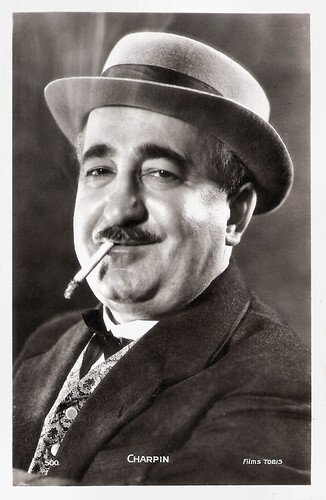
French postcard by Editions Chantal, Paris, no. 500. Photo: Films Tobis. Charpin as Jollivet in Michel Strogoff (Jacques de Baroncelli, Richard Eichberg, 1936).
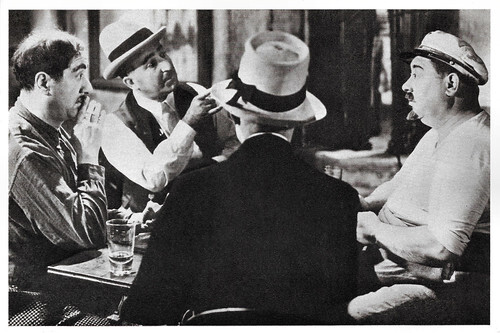
French postcard by Editions La Malibran, Paris / Saint-Dié, no. CF 22. Raimu , Fernand Charpin, Paul Dullac and Robert Vattier in Marius (Alexander Korda, 1931), written by Marcel Pagnol. Caption: The card game.
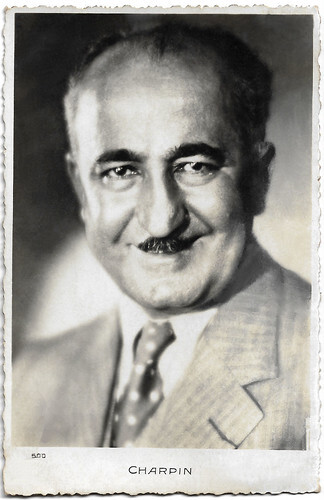
French postcard.
Marcel Pagnol's Marseille trilogy
Fernand Charpin was born in 1887 in Marseille as the son of a gendarme. He grew up in Venelles, a village near Aix-en-Provence where his father was employed. Charpin fought in the First World War as a sergeant in the infantry. Taken prisoner of war in the Argonne in June 1916 and interned in Germany, he was repatriated in January 1919.
He was attracted to acting from a very early age. He went to Paris to take classes at the Conservatoire National Supérieur d'Art Dramatique (CNSAD). After his schooling, he became one of the stalwarts of the Théâtre de l'Odéon.
In 1928, he starred in the comedy 'Chotard et Cie'. One day, Marcel Pagnol went to see Charpin's acting on the advice of his regional colleague Raimu . After all, he was looking for a second actor like Raimu with a somewhat stocky build, a candid natural way of acting and the 'accent du Midi' for his new play 'Marius'. In 'Marius', Charpin played Honoré Panisse, the wealthy middle-aged sailmaker and widower who marries the pregnant Fanny ( Orane Demazis ) when she's deserted by the irresponsible Marius ( Pierre Fresnay ). Charpin was well-liked and 'Marius' achieved a resounding success. It was followed by 'Fanny', the second part of what would become the Marseille trilogy.
When Pagnol announced in 1931 that he would film his trilogy, Charpin also portrayed his role of the sailmaker on the big screen, both in the melodramas Marius (Alexander Korda, 1931) with Raimu and Pierre Fresnay , Fanny (Marc Allégret, 1932) starring Raimu and Orane Démazis , and in César (Marcel Pagnol, 1936), the third part which was first filmed and only later staged as a play.
During the same period, Jean Renoir signed on with Chotard et Cie/Chotard and Company (Jean Renoir, 1933) to film the comedy that had led to Charpin's film debut. Finally, the film career of Fernand Charpin was launched.
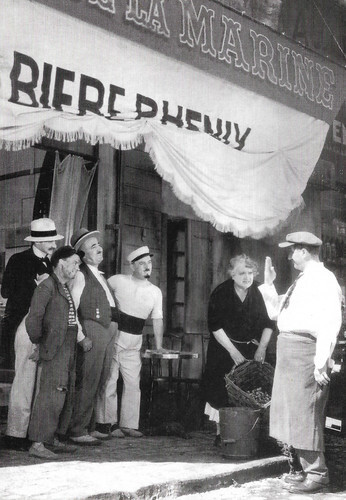
French postcard in the Raimu series by MPC (Marcel Pagnol Com), no. 2. Photo: Roger Foster. Robert Vattier, Marcel Maupi, Raimu , Paul Dullac, Alida Rouffe and Fernand Charpin in Fanny (Marc Allégret, 1932). Caption: A scene in front of the bar La Marine.
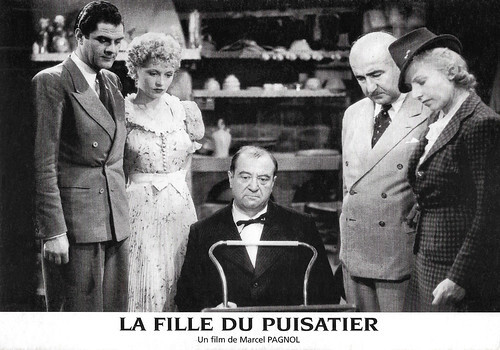
French postcard in the Raimu series by MPC (Marcel Pagnol Com), no. 13. Raimu , Georges Grey , Josette Day , Line Noro and Fernand Charpin in La fille du Puisatier (Marcel Pagnol, 1940), written by Marcel Pagnol.
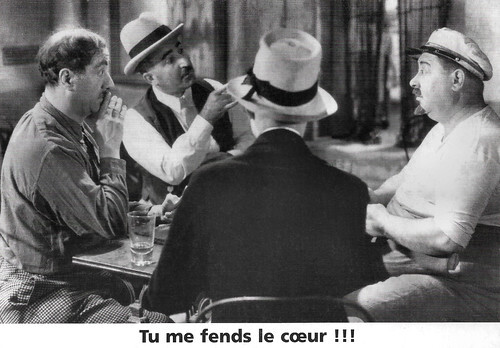
French postcard in the Raimu series by MPC (Marcel Pagnol Com), no. 15. Raimu , Fernand Charpin, Paul Dullac and Robert Vattier in Marius (Alexander Korda, 1931), written by Marcel Pagnol. Caption: You break my heart!!!
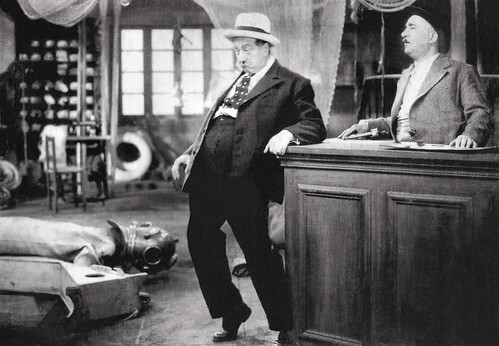
French postcard in the Raimu series by MPC (Marcel Pagnol Com), no. 27. Raimu and Fernand Charpin in Fanny (Marc Allégret, 1932).
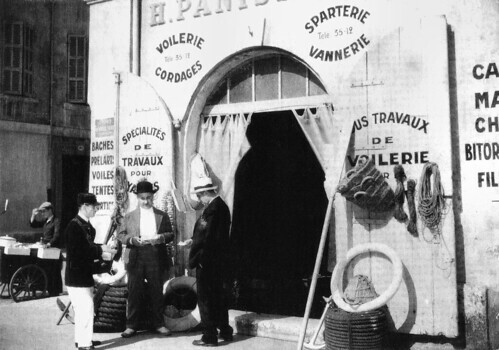
French postcard in the Raimu series by MPC (Marcel Pagnol Com), no. 29. Photo: Roger Foster. Raimu and Fernand Charpin in Fanny (Marc Allégret, 1932).
Raimu and Fernandel
Marcel Pagnol, who by now had become great friends with Fernand Charpin, also directed him in the comedies Le Gendre de monsieur Poirier (Marcel Pagnol, 1933) and Le Schpountz/Heartbeat (Marcel Pagnol, 1938), and the tragicomedies La Femme du boulanger/The Baker's Wife (Marcel Pagnol, 1938) and La Fille du puisatier/The Well-Digger's Daughter (Marcel Pagnol, 1940) in which he co-starred with Raimu .
Charpin and Raimu co-starred seven times, but Charpin also appeared alongside the young Fernandel in eight comedies: Le Train de 8 heures 47 (Henri Wulschleger, 1934), Ignace (Pierre Colombier, 1937), Le Schpountz/Heartbeat (Marcel Pagnol, 1938), Berlingot et Compagnie (Fernand Rivers, 1939), La Fille du puisatier/The Well-Digger's Daughter (Marcel Pagnol, 1940), La Nuit merveilleuse/The Marvelous Night (Jean-Paul Paulin, 1940), Un chapeau de paille d'Italie (Maurice Cammage, 1941) and La Cavalcade des heures (1943).
Besides his film work for Marcel Pagnol, Charpin also featured in several film adaptations of works by Alphonse Daudet: the drama Sapho (Léonce Perret, 1934) starring Mary Marquet , the comedy Tartarin de Tarascon/Tartarin of Tarascon (Raymond Bernard, 1934) where he again starred alongside Raimu , who took the title role, and the dramas Le Petit Chose/The Little Thing (Maurice Cloche, 1938) and L'Arlésienne (1942) with Raimu . Charpin portrayed military and police officers of all ranks (colonel, commander, captains, commissioner, gendarme, brigadiers). He was also seen in civilian authority roles such as investigating judge, mayor (three times), school headmaster, and parish priest.
He additionally acted in some dramas. Julien Duvivier cast him twice. In the drama La Belle Équipe/They Were Five (Julien Duvivier, 1936), Charpin is a gendarme and in the crime film Pépé le Moko (Julien Duvivier, 1937), he is a snitch, a very atypical role for him. The film adaptations of novels he starred in were also mostly dramas: the family dramas Les Anges noirs/The Dark Angels (Willy Rozier, 1937), after François Mauriac, and Les Roquevillard (1943) after Henry Bordeaux, and the crime film Les Caves du Majestic/Majestic Hotel Cellars (Richard Pottier, 1945) after Georges Simenon.
Charpin married the actress Gabrielle Doulcet in 1913. Their marriage remained childless. In 1944, a few months after the Liberation, he suddenly died of heart failure at the age of 57. Charpin was suffering from a heart condition and when the lift in his building had stopped working due to electricity restrictions he had to climb the stairs to the seventh floor of his building, 3 rue Émile-Allez in Paris. It was too much. Fernand Charpin is buried in the Batignolles cemetery.
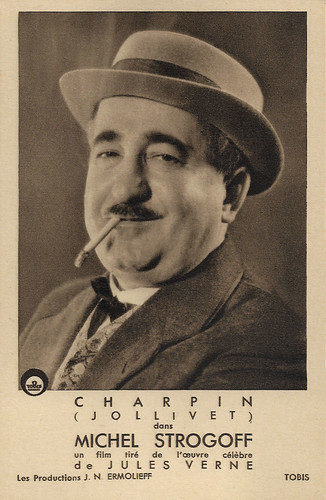
French postcard. Photo: Les productions J.N. Ermoliev / Tobis. Charpin as Jolivet in Michel Strogoff (Jacques de Baroncelli, Richard Eichberg, 1936). Caption: A film based on the famous novel by Jules Verne.
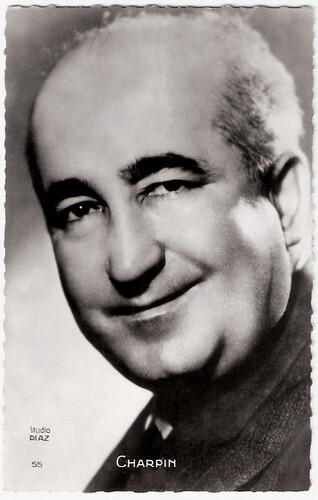
French postcard by Editions P.I., Paris, no. 55. Photo: Studio Piaz.
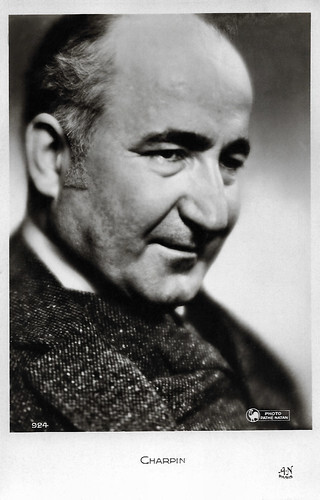
French postcard by A.N, Paris, no. 924. Photo: Pathé Natan.
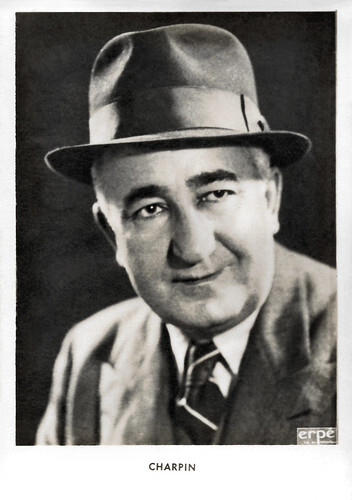
French postcard by Edition Erpé, Paris.
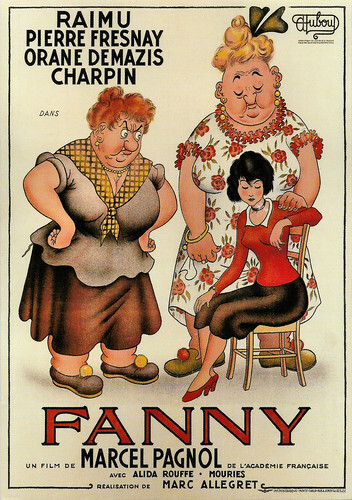
French postcard by Jean Dubout, Paris, 2009, D 49. Poster design by Albert Dubout (1950) for a re-issue of Fanny (Marc Allegret, 1932), written by Marcel Pagnol.
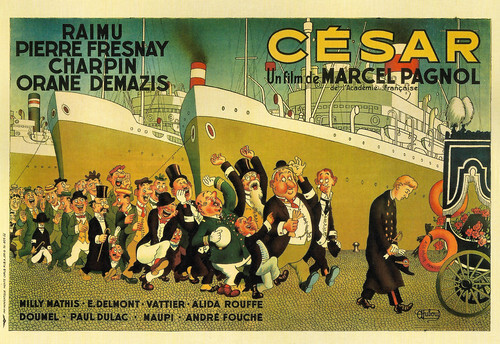
French postcard by Jean Dubout, Paris, 2006, D 3. Poster design by Albert Dubout (1950) for a re-issue of César (Marcel Pagnol, 1936), written by Marcel Pagnol.
Sources: AllMovie, Wikipedia (Dutch, English and French) and .

French postcard by Editions Chantal, Paris, no. 500. Photo: Films Tobis. Charpin as Jollivet in Michel Strogoff (Jacques de Baroncelli, Richard Eichberg, 1936).

French postcard by Editions La Malibran, Paris / Saint-Dié, no. CF 22. Raimu , Fernand Charpin, Paul Dullac and Robert Vattier in Marius (Alexander Korda, 1931), written by Marcel Pagnol. Caption: The card game.

French postcard.
Marcel Pagnol's Marseille trilogy
Fernand Charpin was born in 1887 in Marseille as the son of a gendarme. He grew up in Venelles, a village near Aix-en-Provence where his father was employed. Charpin fought in the First World War as a sergeant in the infantry. Taken prisoner of war in the Argonne in June 1916 and interned in Germany, he was repatriated in January 1919.
He was attracted to acting from a very early age. He went to Paris to take classes at the Conservatoire National Supérieur d'Art Dramatique (CNSAD). After his schooling, he became one of the stalwarts of the Théâtre de l'Odéon.
In 1928, he starred in the comedy 'Chotard et Cie'. One day, Marcel Pagnol went to see Charpin's acting on the advice of his regional colleague Raimu . After all, he was looking for a second actor like Raimu with a somewhat stocky build, a candid natural way of acting and the 'accent du Midi' for his new play 'Marius'. In 'Marius', Charpin played Honoré Panisse, the wealthy middle-aged sailmaker and widower who marries the pregnant Fanny ( Orane Demazis ) when she's deserted by the irresponsible Marius ( Pierre Fresnay ). Charpin was well-liked and 'Marius' achieved a resounding success. It was followed by 'Fanny', the second part of what would become the Marseille trilogy.
When Pagnol announced in 1931 that he would film his trilogy, Charpin also portrayed his role of the sailmaker on the big screen, both in the melodramas Marius (Alexander Korda, 1931) with Raimu and Pierre Fresnay , Fanny (Marc Allégret, 1932) starring Raimu and Orane Démazis , and in César (Marcel Pagnol, 1936), the third part which was first filmed and only later staged as a play.
During the same period, Jean Renoir signed on with Chotard et Cie/Chotard and Company (Jean Renoir, 1933) to film the comedy that had led to Charpin's film debut. Finally, the film career of Fernand Charpin was launched.

French postcard in the Raimu series by MPC (Marcel Pagnol Com), no. 2. Photo: Roger Foster. Robert Vattier, Marcel Maupi, Raimu , Paul Dullac, Alida Rouffe and Fernand Charpin in Fanny (Marc Allégret, 1932). Caption: A scene in front of the bar La Marine.

French postcard in the Raimu series by MPC (Marcel Pagnol Com), no. 13. Raimu , Georges Grey , Josette Day , Line Noro and Fernand Charpin in La fille du Puisatier (Marcel Pagnol, 1940), written by Marcel Pagnol.

French postcard in the Raimu series by MPC (Marcel Pagnol Com), no. 15. Raimu , Fernand Charpin, Paul Dullac and Robert Vattier in Marius (Alexander Korda, 1931), written by Marcel Pagnol. Caption: You break my heart!!!

French postcard in the Raimu series by MPC (Marcel Pagnol Com), no. 27. Raimu and Fernand Charpin in Fanny (Marc Allégret, 1932).

French postcard in the Raimu series by MPC (Marcel Pagnol Com), no. 29. Photo: Roger Foster. Raimu and Fernand Charpin in Fanny (Marc Allégret, 1932).
Raimu and Fernandel
Marcel Pagnol, who by now had become great friends with Fernand Charpin, also directed him in the comedies Le Gendre de monsieur Poirier (Marcel Pagnol, 1933) and Le Schpountz/Heartbeat (Marcel Pagnol, 1938), and the tragicomedies La Femme du boulanger/The Baker's Wife (Marcel Pagnol, 1938) and La Fille du puisatier/The Well-Digger's Daughter (Marcel Pagnol, 1940) in which he co-starred with Raimu .
Charpin and Raimu co-starred seven times, but Charpin also appeared alongside the young Fernandel in eight comedies: Le Train de 8 heures 47 (Henri Wulschleger, 1934), Ignace (Pierre Colombier, 1937), Le Schpountz/Heartbeat (Marcel Pagnol, 1938), Berlingot et Compagnie (Fernand Rivers, 1939), La Fille du puisatier/The Well-Digger's Daughter (Marcel Pagnol, 1940), La Nuit merveilleuse/The Marvelous Night (Jean-Paul Paulin, 1940), Un chapeau de paille d'Italie (Maurice Cammage, 1941) and La Cavalcade des heures (1943).
Besides his film work for Marcel Pagnol, Charpin also featured in several film adaptations of works by Alphonse Daudet: the drama Sapho (Léonce Perret, 1934) starring Mary Marquet , the comedy Tartarin de Tarascon/Tartarin of Tarascon (Raymond Bernard, 1934) where he again starred alongside Raimu , who took the title role, and the dramas Le Petit Chose/The Little Thing (Maurice Cloche, 1938) and L'Arlésienne (1942) with Raimu . Charpin portrayed military and police officers of all ranks (colonel, commander, captains, commissioner, gendarme, brigadiers). He was also seen in civilian authority roles such as investigating judge, mayor (three times), school headmaster, and parish priest.
He additionally acted in some dramas. Julien Duvivier cast him twice. In the drama La Belle Équipe/They Were Five (Julien Duvivier, 1936), Charpin is a gendarme and in the crime film Pépé le Moko (Julien Duvivier, 1937), he is a snitch, a very atypical role for him. The film adaptations of novels he starred in were also mostly dramas: the family dramas Les Anges noirs/The Dark Angels (Willy Rozier, 1937), after François Mauriac, and Les Roquevillard (1943) after Henry Bordeaux, and the crime film Les Caves du Majestic/Majestic Hotel Cellars (Richard Pottier, 1945) after Georges Simenon.
Charpin married the actress Gabrielle Doulcet in 1913. Their marriage remained childless. In 1944, a few months after the Liberation, he suddenly died of heart failure at the age of 57. Charpin was suffering from a heart condition and when the lift in his building had stopped working due to electricity restrictions he had to climb the stairs to the seventh floor of his building, 3 rue Émile-Allez in Paris. It was too much. Fernand Charpin is buried in the Batignolles cemetery.

French postcard. Photo: Les productions J.N. Ermoliev / Tobis. Charpin as Jolivet in Michel Strogoff (Jacques de Baroncelli, Richard Eichberg, 1936). Caption: A film based on the famous novel by Jules Verne.

French postcard by Editions P.I., Paris, no. 55. Photo: Studio Piaz.

French postcard by A.N, Paris, no. 924. Photo: Pathé Natan.

French postcard by Edition Erpé, Paris.

French postcard by Jean Dubout, Paris, 2009, D 49. Poster design by Albert Dubout (1950) for a re-issue of Fanny (Marc Allegret, 1932), written by Marcel Pagnol.

French postcard by Jean Dubout, Paris, 2006, D 3. Poster design by Albert Dubout (1950) for a re-issue of César (Marcel Pagnol, 1936), written by Marcel Pagnol.
Sources: AllMovie, Wikipedia (Dutch, English and French) and .
Published on March 02, 2024 22:00
March 1, 2024
Peter Lawford
English-American actor Peter Lawford (1923-1984) is mainly known as a member of the Rat Pack from which he was later banned due to an argument with Frank Sinatra and as the husband of Patricia Kennedy. Although he was never considered a very important actor, he has played in many famous films. He also appeared frequently on television. He was the first one to kiss Elizabeth Taylor and, according to him, the last one to speak to Marilyn Monroe before she died.
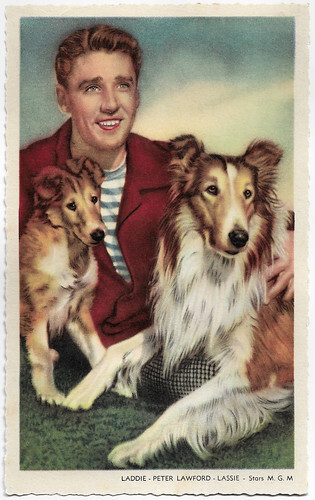
Vintage card. Photo: Metro-Goldwyn-Mayer. Peter Lawford, Laddie and Lassie.
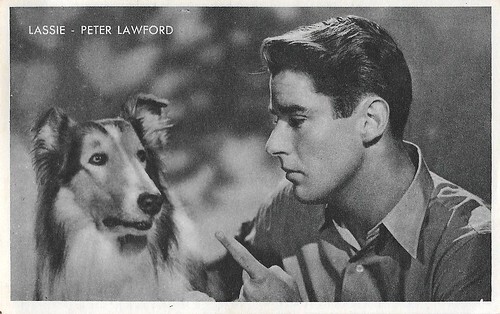
Belgian collectors card by Kwatta, no. C. 190, part of Kwatta collector cards' album C series, numberrs 99-196. Photo: MGM. Lassie and Peter Lawford in Son of Lassie (S. Sylvan Simon, 1945).
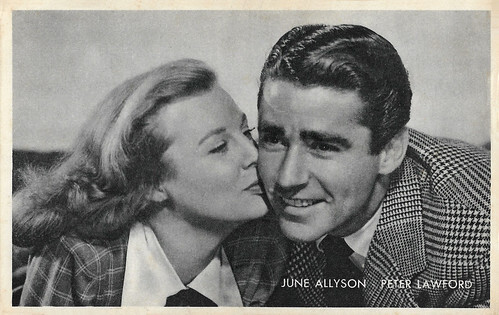
Belgian card by Kwatta, Bois-d'Haine, no. C. 161. Photo: M.G.M. June Allyson and Peter Lawford in Good News (Charles Walters, 1947).
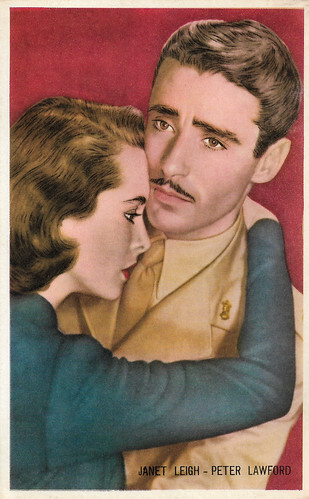
Belgian card by Kwatta, Bois-d'Haine, no. C. 310. Photo: M.G.M. Peter Lawford and Janet Leigh in The Red Danube (George Sidney, 1949).
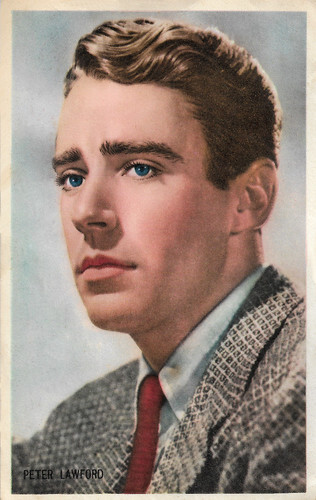
Belgian card by Kwatta, Bois-d'Haine, no. C. 297. Photo: M.G.M. Peter Lawford in Please Believe Me (Norman Taurog, 1950).
Son of Lassie
Peter Lawford was born Peter Sydney Vaughn Aylen in London in 1923. He was the son of Lieutenant General Sir Sidney Lawford and his wife May. His parents married when he was one year old, which is why his mother's surname appears on his birth certificate.
He spent his childhood with his parents in France and therefore learnt French rather than English. Lawford later also became fluent in Spanish and Italian. He first appeared in front of the camera at the age of seven in the British film Poor Old Bill (Monty Banks, 1931).
In 1938, he played a supporting role in the drama Lord Jeff (Sam Wood, 1938) alongside child stars Freddie Bartholomew and Mickey Rooney , his first film in America. At the beginning of the 1940s, Lawford signed his first studio contract with Metro-Goldwyn-Mayer, where he was only given small roles in the early years.
A serious arm injury that Lawford suffered when he ran into a glass door at the age of 14 prevented him from serving in the Second World War. His breakthrough came with his roles in the Irene Dunne drama The White Cliffs of Dover (Clarence Brown, 1944) and the literary adaptation The Picture of Dorian Gray (Albert Lewin, 1945) as David Stone.
Lawford had his first leading role in the Lassie film Son of Lassie (S. Sylvan Simon, 1945). In 1946, he appeared in Ernst Lubitsch 's comedy Cluny Brown and Henry Koster's musical Two Sisters from Boston in major roles. He played alongside Fred Astaire in the films Easter Parade (Charles Walters, 1948) and Royal Wedding (Stanley Donen, 1951).
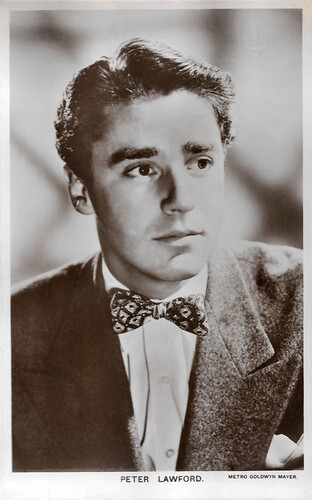
British postcard in the Picturegoer Series, no. W 225. Photo: Metro Goldwyn Mayer.
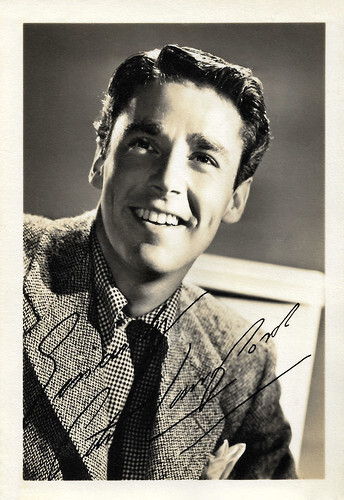
Vintage autograph card.
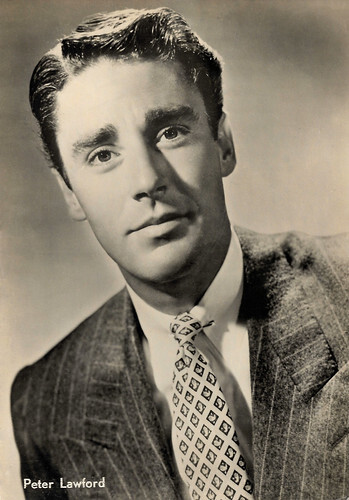
Vintage postcard by PEB.
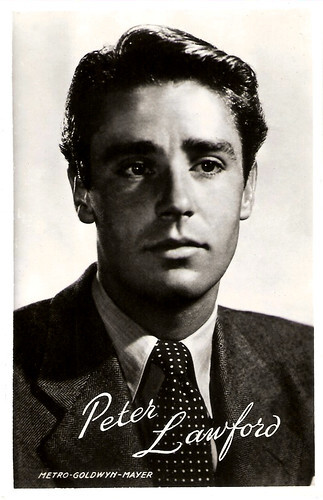
Dutch postcard by Takken 't Sticht, no. AX 337. Photo: Metro-Goldwyn-Mayer.
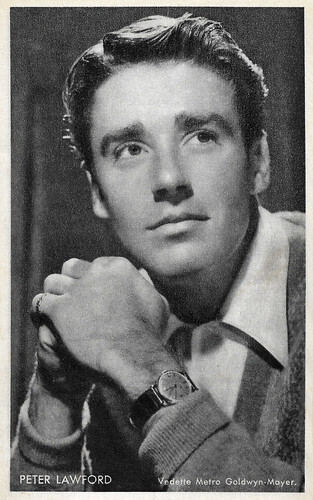
Belgian collectors card by Kwatta, Bois-d'Haine. Photo: Metro-Goldwyn-Mayer.
Young lovers from good families
Peter Lawford usually played young lovers at MGM, often from good families, for example as Theodore Laurence in Little Women (Mervyn LeRoy, 1949), the film version of the novel by Louisa May Alcott. He was known in particular for his light-hearted and romantic roles.
As a result, Lawford became a household name, but never one of Hollywood's biggest stars. After the end of his contract with MGM, he turned to other roles and played more on television, including the leading role in the television series The Thin Man between 1957 and 1959.
At the end of the 1950s, he became a member of Frank Sinatra's Rat Pack, which led to more roles. He played the playboy Jimmy Foster in Ocean's Eleven (Lewis Milestone, 1960).
In his later career, he turned to character roles and appeared in several television productions, including a recurring supporting role in the television series The Doris Day Show (1971-1973) with Doris Day .
His later films include The April Fools (Stuart Rosenberg, 1969) with Jack Lemmon and Catherine Deneuve , and Rosebud (Otto Preminger, 1975), although he also made a few third-rate films. His last role was in the British comedy Where Is Parsifal? (Henry Helman, 1984) alongside Tony Curtis .
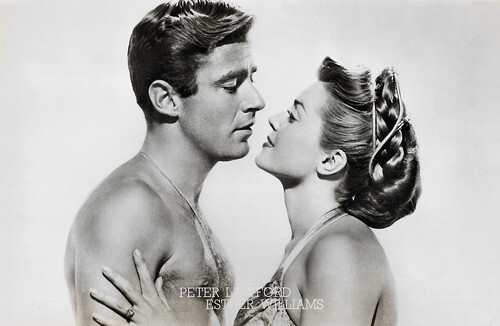
Belgian postcard, no. 1151. Photo: Metro Goldwyn Mayer. Peter Lawford and Esther Williams in On an Island with You (Richard Thorpe, 1948).

Belgian postcard. Photo: M.G.M. Jimmy Durante, Peter Lawford, Esther Williams , Cyd Charisse , Ricardo Montalban and Xavier Cugat in On an Island with You (Richard Thorpe, 1948).
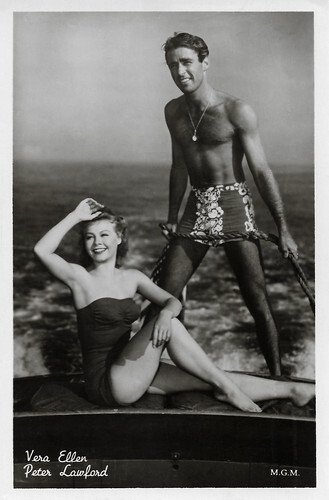
Belgian postcard by Nieuwe Merksemsche Chocolaterie S.P.R.I., Merksem (Anvers / Antwerpen). Photo: M.G.M., 1950. With Vera Ellen .
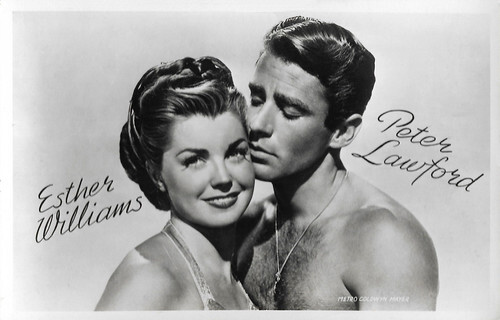
Dutch postcard by Fotoarchief Film en Toneel, no. 3528. Photo: Metro Goldwyn Mayer. Esther Williams and Peter Lawford in On an Island with You (Richard Thorpe, 1948).
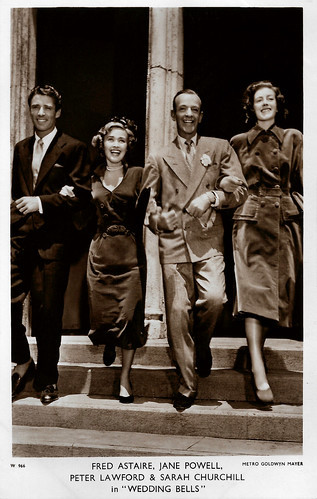
British postcard in the Picturegoer Series, London, no. W 966. Photo: Metro Goldwyn Mayer. Fred Astaire , Jane Powell , Peter Lawford, and Sarah Churchill in Royal Wedding (Stanley Donen, 1951).
Marilyn Monroe's last words
Peter Lawford was known for his colourful, sometimes turbulent private life. He married Patricia Kennedy, John F. Kennedy's sister, in 1954 and thus became a member of the Kennedy family. They had four children together, including the actor Christopher Lawford (1955-2018). The marriage ended in divorce in 1966.
Lawford and the Rat Pack around Frank Sinatra also supported Kennedy in his election campaigns. Lawford is said to have significantly supported the close personal relationship between the two Kennedy brothers John F. and Robert Kennedy and Marilyn Monroe , whom he had known well since the early 1950s. Marilyn Monroe exchanged her last words with Lawford during a telephone call on the night of 4 August 1962, when she died.
After divorcing the Kennedy daughter, Lawford married Mary Rowan, 27 years his junior and daughter of comedian Dan Rowan, in 1971. The marriage lasted until 1975, after which he went down the aisle twice more, once with Debora Gould (1977-1978, divorced) and a few months before his death with Patricia Seaton.
The friendship between him and Sinatra suffered for years because he had an affair with Sinatra's wife Ava Gardner and Sinatra considered this to be the reason for his separation from Gardner. Lawford had various more or less serious affairs with stars such as June Allyson, Lana Turner and Kim Novak . Before his marriage to Patricia Kennedy, he had a relationship with the African-American actress Dorothy Dandridge .
Peter Lawford was addicted to alcohol for many years, which affected both his health and his professional career from the 1970s onwards. In 1984, Lawford died from kidney and liver failure in Los Angeles. He was 61. In 2018, his 63-year-old son Christopher Lawford also died of a heart attack.
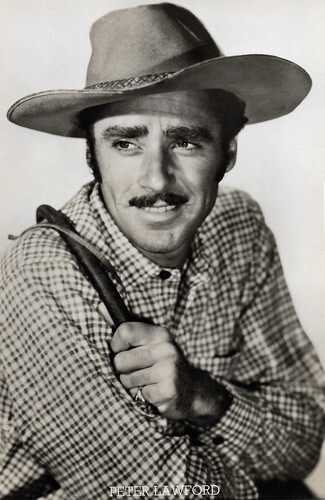
Belgian postcard, no. 152. Photo: 20th Century Fox. Peter Lawford in Kangaroo (Lewis Milestone, 1952).
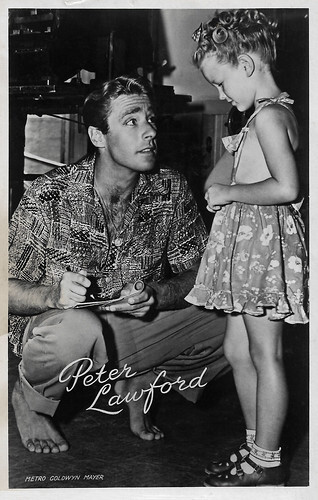
Swedish postcard by Forlag Torsten G. Ericson, Hälsingborg, no. AX 408. Photo: Metro Goldwyn Mayer.
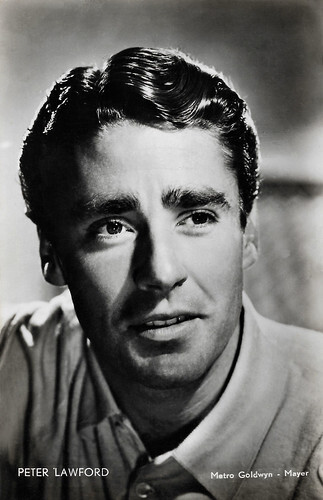
Vintage postcard, no. AX 119. Photo: Metro Goldwyn Mayer.
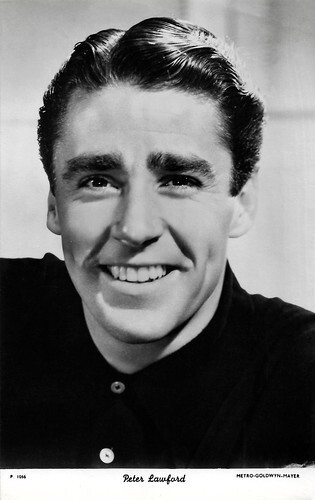
British postcard in the The People series by Show Parade Picture Service, London, no. P. 1066. Photo: Metro-Goldwyn-Mayer.
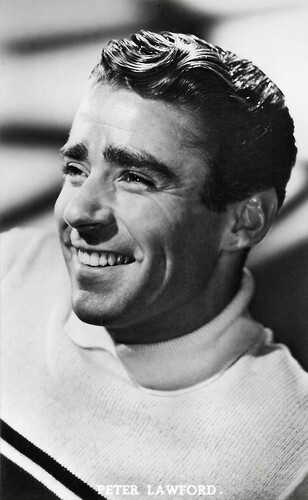
Dutch postcard by van Leer's Fotodrukindustrie N.V., Amsterdam, no. 31. Photo: Metro Goldwyn Mayer.
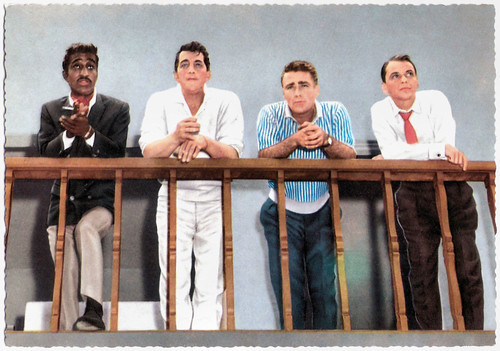
German postcard by Krüger, no. 902/193. Photo: Terb Agency. Sammy Davis Jr., Dean Martin , Peter Lawford and Frank Sinatra .
Sources: Wikipedia (Dutch, German and English) and .

Vintage card. Photo: Metro-Goldwyn-Mayer. Peter Lawford, Laddie and Lassie.

Belgian collectors card by Kwatta, no. C. 190, part of Kwatta collector cards' album C series, numberrs 99-196. Photo: MGM. Lassie and Peter Lawford in Son of Lassie (S. Sylvan Simon, 1945).

Belgian card by Kwatta, Bois-d'Haine, no. C. 161. Photo: M.G.M. June Allyson and Peter Lawford in Good News (Charles Walters, 1947).

Belgian card by Kwatta, Bois-d'Haine, no. C. 310. Photo: M.G.M. Peter Lawford and Janet Leigh in The Red Danube (George Sidney, 1949).

Belgian card by Kwatta, Bois-d'Haine, no. C. 297. Photo: M.G.M. Peter Lawford in Please Believe Me (Norman Taurog, 1950).
Son of Lassie
Peter Lawford was born Peter Sydney Vaughn Aylen in London in 1923. He was the son of Lieutenant General Sir Sidney Lawford and his wife May. His parents married when he was one year old, which is why his mother's surname appears on his birth certificate.
He spent his childhood with his parents in France and therefore learnt French rather than English. Lawford later also became fluent in Spanish and Italian. He first appeared in front of the camera at the age of seven in the British film Poor Old Bill (Monty Banks, 1931).
In 1938, he played a supporting role in the drama Lord Jeff (Sam Wood, 1938) alongside child stars Freddie Bartholomew and Mickey Rooney , his first film in America. At the beginning of the 1940s, Lawford signed his first studio contract with Metro-Goldwyn-Mayer, where he was only given small roles in the early years.
A serious arm injury that Lawford suffered when he ran into a glass door at the age of 14 prevented him from serving in the Second World War. His breakthrough came with his roles in the Irene Dunne drama The White Cliffs of Dover (Clarence Brown, 1944) and the literary adaptation The Picture of Dorian Gray (Albert Lewin, 1945) as David Stone.
Lawford had his first leading role in the Lassie film Son of Lassie (S. Sylvan Simon, 1945). In 1946, he appeared in Ernst Lubitsch 's comedy Cluny Brown and Henry Koster's musical Two Sisters from Boston in major roles. He played alongside Fred Astaire in the films Easter Parade (Charles Walters, 1948) and Royal Wedding (Stanley Donen, 1951).

British postcard in the Picturegoer Series, no. W 225. Photo: Metro Goldwyn Mayer.

Vintage autograph card.

Vintage postcard by PEB.

Dutch postcard by Takken 't Sticht, no. AX 337. Photo: Metro-Goldwyn-Mayer.

Belgian collectors card by Kwatta, Bois-d'Haine. Photo: Metro-Goldwyn-Mayer.
Young lovers from good families
Peter Lawford usually played young lovers at MGM, often from good families, for example as Theodore Laurence in Little Women (Mervyn LeRoy, 1949), the film version of the novel by Louisa May Alcott. He was known in particular for his light-hearted and romantic roles.
As a result, Lawford became a household name, but never one of Hollywood's biggest stars. After the end of his contract with MGM, he turned to other roles and played more on television, including the leading role in the television series The Thin Man between 1957 and 1959.
At the end of the 1950s, he became a member of Frank Sinatra's Rat Pack, which led to more roles. He played the playboy Jimmy Foster in Ocean's Eleven (Lewis Milestone, 1960).
In his later career, he turned to character roles and appeared in several television productions, including a recurring supporting role in the television series The Doris Day Show (1971-1973) with Doris Day .
His later films include The April Fools (Stuart Rosenberg, 1969) with Jack Lemmon and Catherine Deneuve , and Rosebud (Otto Preminger, 1975), although he also made a few third-rate films. His last role was in the British comedy Where Is Parsifal? (Henry Helman, 1984) alongside Tony Curtis .

Belgian postcard, no. 1151. Photo: Metro Goldwyn Mayer. Peter Lawford and Esther Williams in On an Island with You (Richard Thorpe, 1948).

Belgian postcard. Photo: M.G.M. Jimmy Durante, Peter Lawford, Esther Williams , Cyd Charisse , Ricardo Montalban and Xavier Cugat in On an Island with You (Richard Thorpe, 1948).

Belgian postcard by Nieuwe Merksemsche Chocolaterie S.P.R.I., Merksem (Anvers / Antwerpen). Photo: M.G.M., 1950. With Vera Ellen .

Dutch postcard by Fotoarchief Film en Toneel, no. 3528. Photo: Metro Goldwyn Mayer. Esther Williams and Peter Lawford in On an Island with You (Richard Thorpe, 1948).

British postcard in the Picturegoer Series, London, no. W 966. Photo: Metro Goldwyn Mayer. Fred Astaire , Jane Powell , Peter Lawford, and Sarah Churchill in Royal Wedding (Stanley Donen, 1951).
Marilyn Monroe's last words
Peter Lawford was known for his colourful, sometimes turbulent private life. He married Patricia Kennedy, John F. Kennedy's sister, in 1954 and thus became a member of the Kennedy family. They had four children together, including the actor Christopher Lawford (1955-2018). The marriage ended in divorce in 1966.
Lawford and the Rat Pack around Frank Sinatra also supported Kennedy in his election campaigns. Lawford is said to have significantly supported the close personal relationship between the two Kennedy brothers John F. and Robert Kennedy and Marilyn Monroe , whom he had known well since the early 1950s. Marilyn Monroe exchanged her last words with Lawford during a telephone call on the night of 4 August 1962, when she died.
After divorcing the Kennedy daughter, Lawford married Mary Rowan, 27 years his junior and daughter of comedian Dan Rowan, in 1971. The marriage lasted until 1975, after which he went down the aisle twice more, once with Debora Gould (1977-1978, divorced) and a few months before his death with Patricia Seaton.
The friendship between him and Sinatra suffered for years because he had an affair with Sinatra's wife Ava Gardner and Sinatra considered this to be the reason for his separation from Gardner. Lawford had various more or less serious affairs with stars such as June Allyson, Lana Turner and Kim Novak . Before his marriage to Patricia Kennedy, he had a relationship with the African-American actress Dorothy Dandridge .
Peter Lawford was addicted to alcohol for many years, which affected both his health and his professional career from the 1970s onwards. In 1984, Lawford died from kidney and liver failure in Los Angeles. He was 61. In 2018, his 63-year-old son Christopher Lawford also died of a heart attack.

Belgian postcard, no. 152. Photo: 20th Century Fox. Peter Lawford in Kangaroo (Lewis Milestone, 1952).

Swedish postcard by Forlag Torsten G. Ericson, Hälsingborg, no. AX 408. Photo: Metro Goldwyn Mayer.

Vintage postcard, no. AX 119. Photo: Metro Goldwyn Mayer.

British postcard in the The People series by Show Parade Picture Service, London, no. P. 1066. Photo: Metro-Goldwyn-Mayer.

Dutch postcard by van Leer's Fotodrukindustrie N.V., Amsterdam, no. 31. Photo: Metro Goldwyn Mayer.

German postcard by Krüger, no. 902/193. Photo: Terb Agency. Sammy Davis Jr., Dean Martin , Peter Lawford and Frank Sinatra .
Sources: Wikipedia (Dutch, German and English) and .
Published on March 01, 2024 22:00
February 29, 2024
Mamie van Doren
Voluptuous American actress Mamie Van Doren (1931) was a sex symbol of the 1950s and 1960s. Van Doren starred in several exploitation films such as Untamed Youth (1957), loaded with rock 'n' roll and juvenile delinquency. Her onscreen wardrobe usually consisted of tight sweaters, torpedo bras, skin-tight capri pants, and daring swimsuits. Mamie and her colleague blond bombshells Marilyn Monroe and Jayne Mansfield were known as 'The Three M's.' In the 1960s, she appeared in some European films.
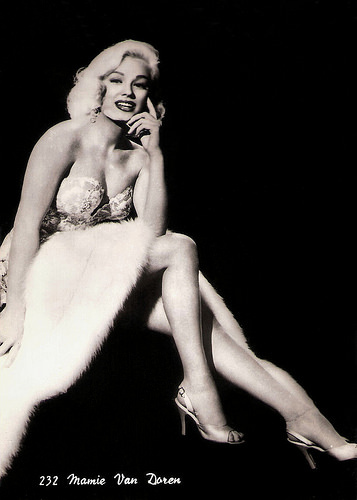
Italian postcard in the series Divi del Cinema by Vetta Traldi, Milano, no 232.
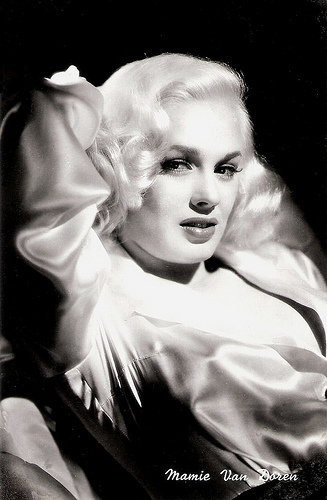
Italian postcard by Bromofoto, Milano (Milan). Sent by mail in the Netherlands in 1958.
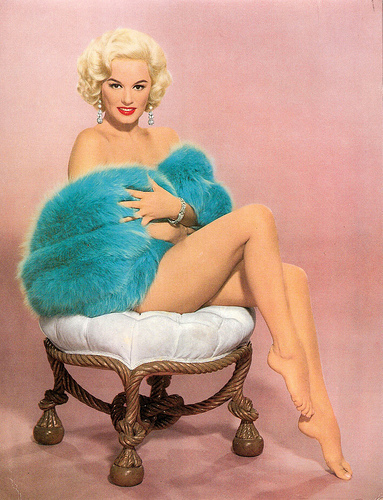
Big German card by ISV, no. PX 3.
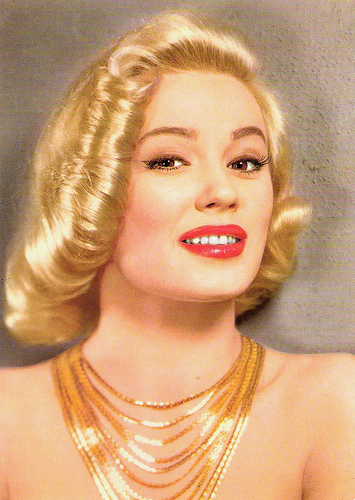
Italian postcard by Rotalfoto, Milano, no. 39.
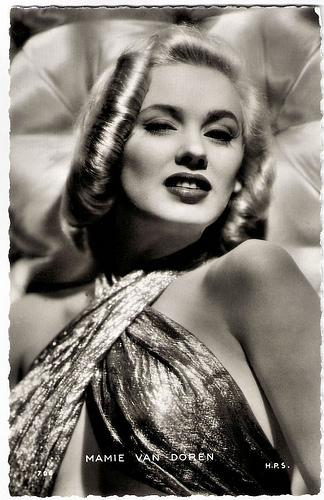
French postcard by P.I., Paris, no. 706, offered by Les Carbones Korès 'Carboplane'. Photo: H.P.S.
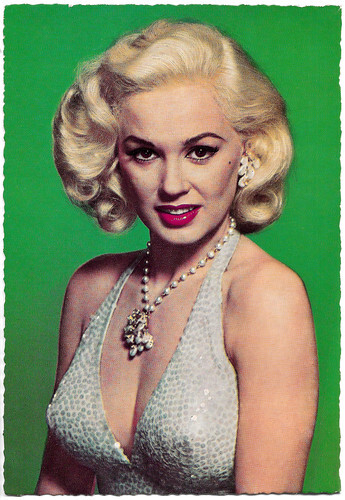
German postcard by WS-Druck, Wanne-Eickel, no. F 107. Photo: Metro-Goldwyn-Mayer / Filmpress Zürich.
Condemned by the Catholic Legion of Decency
Mamie Van Doren was born Joan Lucille Olander in Rowena, South Dakota, in 1931. She was the daughter of Warner Carl Olander and Lucille Harriet Bennett. In 1942 the family moved to Los Angeles. In early 1946, Van Doren began working as an usher at the Pantages Theatre in Hollywood. The following year, she had a bit part on an early television show. She also sang with Ted Fio Rito's band and entered several beauty contests. She was married for a brief time at seventeen when Van Doren and her first husband, Jack Newman, eloped to Santa Barbara. The marriage was dissolved quickly, upon her discovery of his abusive nature.
In the summer of 1949, at age 18, she won the titles Miss Eight Ball and Miss Palm Springs. Van Doren was discovered by producer Howard Hughes the night she was crowned Miss Palm Springs. The pair dated for five years. Hughes provided her with a bit role in Jet Pilot at RKO Radio Pictures. Her line of dialogue consisted of one word, "Look!". The following year, 1951, she posed for famous pin-up girl artist Alberto Vargas, the painter of the glamorous Vargas Girls. His painting of Van Doren was on the July 1951 cover of Esquire magazine. Van Doren did a few more bit parts in RKO films, including His Kind of Woman (John Farrow, 1951) starring Robert Mitchum and Jane Russell .
Van Doren then began working on the stage. She was a showgirl in New York in Monte Proser's nightclub version of 'Billion Dollar Baby'. Songwriter Jimmy McHugh discovered her for his musicals, then decided she was too good for the chorus line and should have dramatic training. She studied with Ben Bard and Bliss-Hayden. While appearing in the role of Marie in a showcase production of 'Come Back, Little Sheba', Van Doren was seen by Phil Benjamin, a casting director at Universal International. In 1953, Van Doren signed a contract with Universal Studios. They had big plans for her, hoping she would bring the same kind of success that 20th Century Fox had with Marilyn Monroe . Van Doren, whose signing day coincided with the inauguration of President Eisenhower, was given the first name Mamie for Ike's wife, Mamie Eisenhower. Universal first cast Van Doren in a minor role as a singer in Forbidden (Rudolph Maté, 1953), starring Tony Curtis .
Interested in Van Doren's allure, Universal then cast her again opposite Curtis in The All American (Jesse Hibbs, 1953), playing her first major role as Susie Ward, a wayward girl who is the man-trap at a campus beer joint. In Yankee Pasha (Joseph Pevney, 1954), starring Jeff Chandler and Rhonda Fleming , she played a slave girl, Lilith. In 1955, she had a supporting role in the musical Ain't Misbehavin' (Edward Buzzell, 1955) and starred in the crime-drama, Running Wild (Abner Biberman, 1955). Soon thereafter, Van Doren turned down a Broadway role in the play 'Will Success Spoil Rock Hunter?' and was replaced by newcomer Jayne Mansfield. In 1956, Van Doren appeared in the Western Star in the Dust (Charles F. Haas, 1956). Though Van Doren garnered prominent billing alongside John Agar and Richard Boone, she appears rather briefly, as the daughter of a ranch owner. By this time, Van Doren had grown tired of Universal, which was only casting her in non-breakthrough roles. Therefore, Van Doren began accepting bigger roles in better movies from other studios, such as Teacher's Pet (George Seaton, 1958) with Doris Day and Clark Gable .
She appeared in some of the first movies to feature rock 'n' roll music, such as Untamed Youth (Howard W. Koch, 1957). Hal Erickson at AllMovie : "Delivering a superb performance under the circumstances, Russ Tamblyn heads the cast as 'typical' high schooler Tony Baker. Usually seen in the company of his voluptuous "aunt" Gwen Dulaine (the truly impressive Mamie Van Doren), Tony convinces one and all that he's looking for kicks of the controlled-substance kind. In truth, however, our hero is really an undercover narcotics agent named Mike Wilson, bound and determined to smash the operation of drug lord Mr. A. ( Jackie Coogan ). The once-in-a-lifetime cast includes such worthies as John Drew Barrymore ( Drew Barrymore 's daddy), Ray Anthony (then married to Mamie Van Doren), Charles Chaplin Jr., Michael Landon, and Jerry Lee Lewis as 'himself'." The film was originally condemned by the Catholic Legion of Decency, but that only served to enhance the curiosity factor, resulting in it being a big moneymaker for the studio. Van Doren became identified with this rebellious style and made some rock records. She went on to star in several bad girl movies that later became cult films. These include Born Reckless (Howard W. Koch, 1958), High School Confidential (Jack Arnold, 1958), and The Beat Generation (Charles F. Haas, 1959). After Universal Studios chose not to renew her contract in 1959, Van Doren was now a free agent and had to struggle to find work.
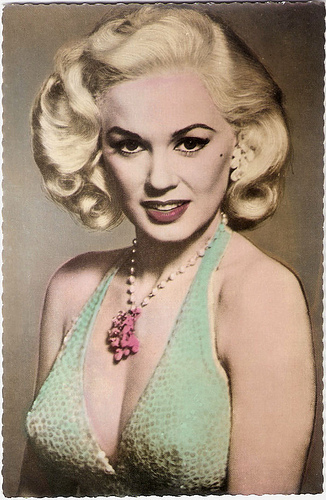
Yugoslavian postcard by Ifis-glas, Smederevo.
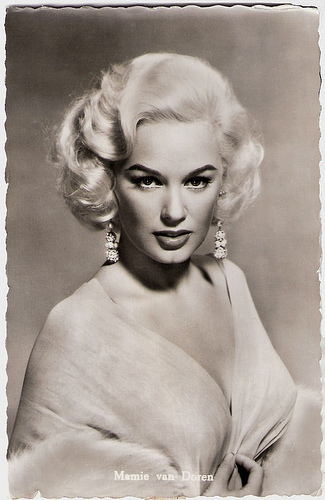
Dutch postcard by 'Emdeeha' de Hond, Oosterbeek, no. 15. Photo: MGM.
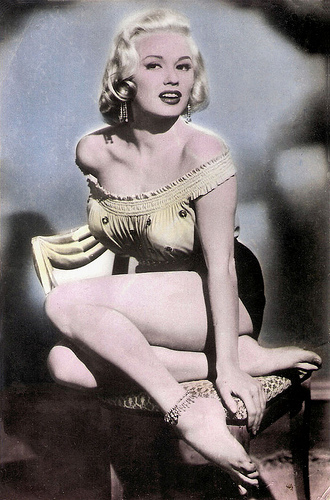
Yugoslavian postcard by Studio Sombor.
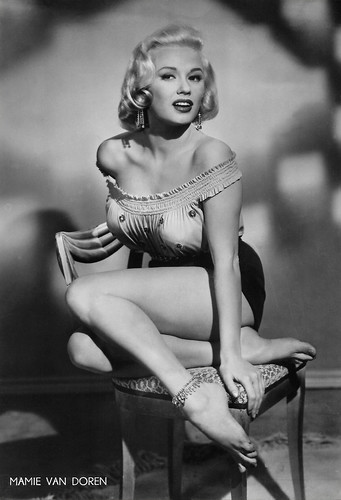
Italian postcard by Bromostampa, Milano, no. 380.
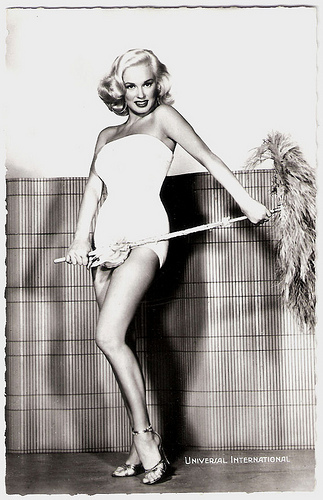
French postcard by Editions du Globe, no. 475. Photo: Universal International / International Press.
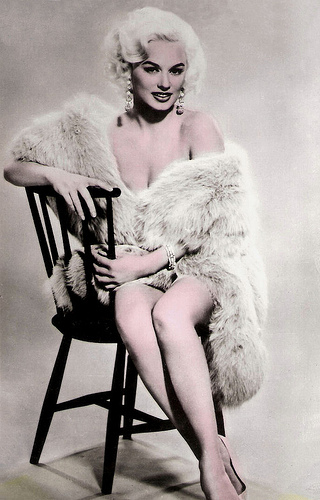
Yugoslavian postcard.
Hip-hugging skin-tight pants and seashell brassieres
Mamie Van Doren became known for her provocative roles. She was in prison for Girls Town (Charles F. Haas, 1959), which provoked censors with a shower scene where audiences could see Van Doren's naked back. As Eve in The Private Lives of Adam and Eve (Mickey Rooney, Albert Zugsmith, 1960) she wore only fig leaves, and in other films, like Vice Raid (Edward L. Cahn, 1960) audiences were clued in as to the nature of the films from the titles. Many of these productions were low-budget B-movies which sometimes gained a cult following for their high camp value. An example is Sex Kittens Go to College (Albert Zugsmith, 1960), which co-starred Tuesday Weld and Mijanou Bardot - Brigitte's sister.
Mamie also appeared in foreign productions, such as the Italian crime comedy Le bellissime gambe di Sabrina/The Beautiful Legs of Sabrina (Camillo Mastrocinque, 1959) with Antonio Cifariello , and the Argentine film Una americana en Buenos Aires/The Blonde from Buenos Aires (George Cahan, 1961) with Jean-Pierre Aumont . Van Doren took some time off from her career and came back to the screen in 1964. That year she played in the German Western musical Freddy und das Lied der Prärie/In the Wild West (Sobey Martin, 1964), starring Freddy Quinn and Rik Battaglia . Tommy Noonan convinced Van Doren to appear as a neurotic striptease artist in 3 Nuts in Search of a Bolt (Tommy Noonan, 1964). Van Doren had turned down Noonan's previous offer to star in Promises! Promises!, in which she would have to do nude scenes. She was replaced by Jayne Mansfield . In 3 Nuts in Search of a Bolt, Mamie did a beer-bath scene but is not seen nude. She posed for Playboy to promote the film.
Van Doren next appeared in The Las Vegas Hillbillys (Arthur C. Pierce, 1966) which co-starred Jayne Mansfield . It was the only time two of 'The Three M's' appeared together in a film. A sequel was titled Hillbillys in a Haunted House, but Van Doren turned this role down and was replaced by Joi Lansing. She appeared in You've Got to Be Smart (Ellis Kadison, 1967), and the Sci-Fi film, Voyage to the Planet of Prehistoric Women (1968), directed by the young Peter Bogdanovich (a.k.a. Derek Thomas). In this film astronauts land on Venus and encounter dangerous creatures and meet sexy Venusian women who like to sunbathe in hip-hugging skin-tight pants and seashell brassieres. In 1968, she was offered the role of a murder victim in the independent horror film The Ice House as a replacement for Mansfield, who died the previous year. She turned the offer down, however, and was replaced by Sabrina . During the Vietnam War, she did tours for U.S. troops in Vietnam for three months in 1968, and again in 1970. Van Doren also developed a nightclub act and did live theatre. She performed in stage productions of 'Gentlemen Prefer Blondes' and 'Dames at Sea' at the Drury Lane Theater, Chicago, and appeared in 'Will Success Spoil Rock Hunter?' and 'The Tender Trap' at the Arlington Park Theater.
After a supporting role in the Western The Arizona Kid (Luciano B. Carlos, 1970), Van Doren disappeared from films. In the 1970s, she performed a nightclub act in Las Vegas. Hal Erickson at AllMovie : "Van Doren continued popping up at important Hollywood social functions and awards presentations, as zaftig and exhibitionist as ever, much to the delight of her ever-growing fan club. In 1987 Mamie Van Doren wrote her memoirs, 'Playing the Field', in which she claimed she slept with practically every male star in the entertainment industry." Playing the Field (1987) brought much new attention and proved to be her biggest media splash in over 25 years. Since the book's publication, she has often been interviewed and profiled and has occasionally returned to acting. Van Doren's guest appearances on television include Fantasy Island, Burke's Law, Vega$, and L.A. Law. Van Doren's last film appearance was a cameo role in the comedy Slackers (Dewey Nicks, 2002).
Mamie Van Doren has been married five times. Her first marriage was to sportswear manufacturer Jack Newman whom she married and divorced in 1950. Her second marriage was to bandleader, composer and actor Ray Anthony whom she married in 1955. They had one son, Perry Ray Anthony (1956). The couple later divorced in 1961. When Van Doren's early 1960s, highly publicised, on-again off-again engagement to baseball player Bo Belinsky ended in 1964, she married baseball player Lee Meyers in 1966. They were divorced in 1967. Her fourth marriage was to businessman Ross McClintock in 1972. They met while working on President Nixon's reelection campaign; the marriage was annulled in 1973. Since 1979 she has been married to Thomas Dixon, an actor and dentist.
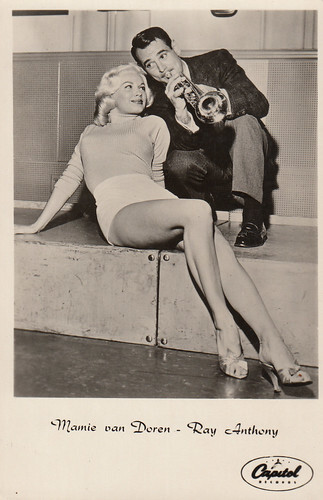
Dutch postcard by Editions Altona, no. 5155. Photo: Capitol. Collection: Marlene Pilaete.
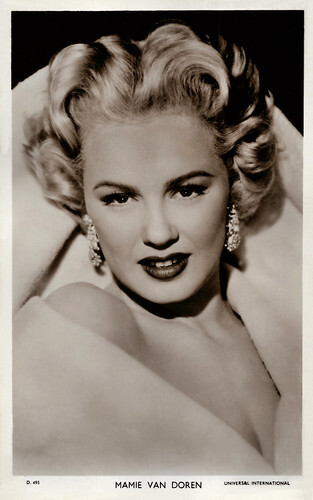
British postcard in the Picturegoer Series, London, no. D. 495. Photo: Universal International.
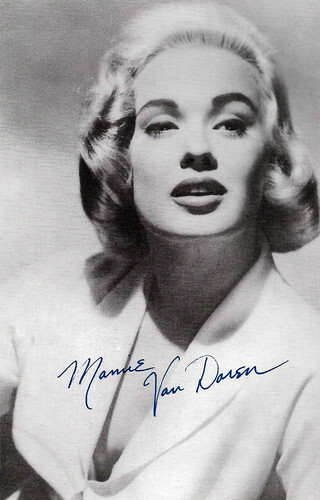
British postcard in the Celebrity Autograph Series, no. 167. Photo: Universal International. Publicity still for Francis Joins the WACS (Arthur Lubin, 1954).
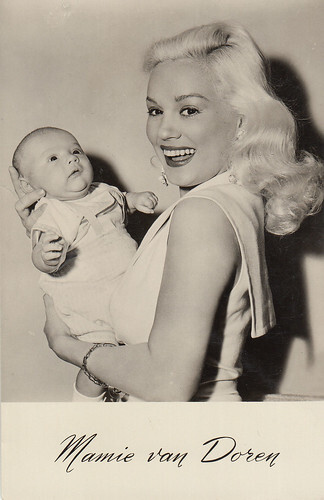
Dutch postcard by Takken, Utrecht, no. 3151. Mamie Van Doren and her son Perry Ray. Collection: Marlene Pilaete.
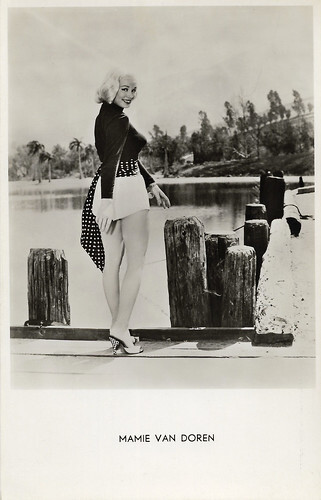
Belgian postcard, no. 96.
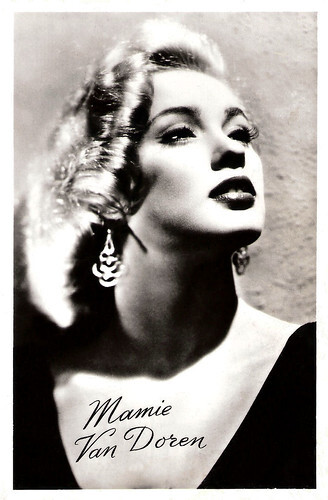
Dutch postcard by Takken / 't Sticht., no. 1633.
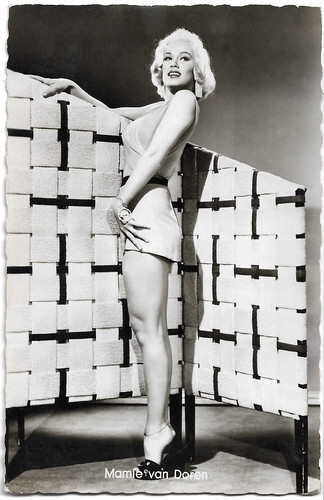
German postcard by Kolibri-Verlag G.m.b.H., Minden-Westf., no. 2330. Photo: Keystone.
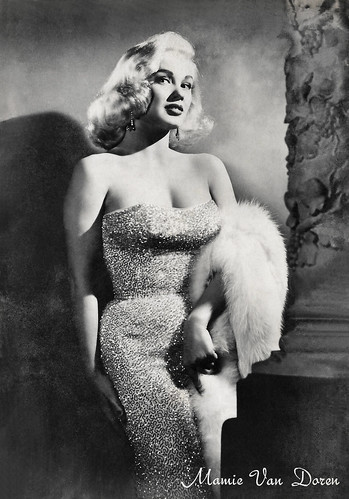
Italian postcard by Rotalfoto, Milano, no. 612.
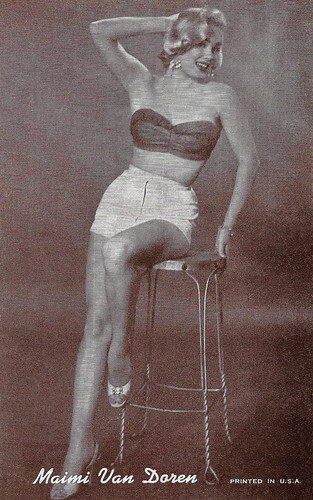
American Arcade card.
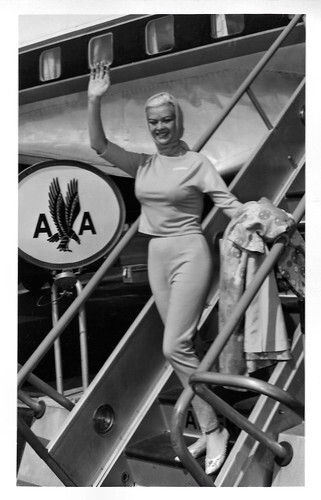
American postcard.
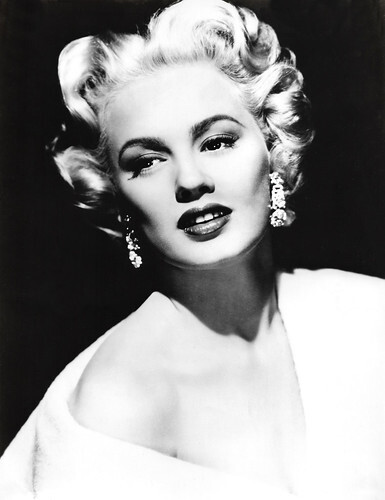
Vintage photo.
Trailer Untamed Youth (Howard W. Koch, 1957). Source: Horror Movie Shows (YouTube).
Trailer for Sex Kittens Go to College (Albert Zugsmith, 1960). Source: Horrormovieshows (YouTube).
Sources: Hal Erickson (AllMovie). Wikipedia and .

Italian postcard in the series Divi del Cinema by Vetta Traldi, Milano, no 232.

Italian postcard by Bromofoto, Milano (Milan). Sent by mail in the Netherlands in 1958.

Big German card by ISV, no. PX 3.

Italian postcard by Rotalfoto, Milano, no. 39.

French postcard by P.I., Paris, no. 706, offered by Les Carbones Korès 'Carboplane'. Photo: H.P.S.

German postcard by WS-Druck, Wanne-Eickel, no. F 107. Photo: Metro-Goldwyn-Mayer / Filmpress Zürich.
Condemned by the Catholic Legion of Decency
Mamie Van Doren was born Joan Lucille Olander in Rowena, South Dakota, in 1931. She was the daughter of Warner Carl Olander and Lucille Harriet Bennett. In 1942 the family moved to Los Angeles. In early 1946, Van Doren began working as an usher at the Pantages Theatre in Hollywood. The following year, she had a bit part on an early television show. She also sang with Ted Fio Rito's band and entered several beauty contests. She was married for a brief time at seventeen when Van Doren and her first husband, Jack Newman, eloped to Santa Barbara. The marriage was dissolved quickly, upon her discovery of his abusive nature.
In the summer of 1949, at age 18, she won the titles Miss Eight Ball and Miss Palm Springs. Van Doren was discovered by producer Howard Hughes the night she was crowned Miss Palm Springs. The pair dated for five years. Hughes provided her with a bit role in Jet Pilot at RKO Radio Pictures. Her line of dialogue consisted of one word, "Look!". The following year, 1951, she posed for famous pin-up girl artist Alberto Vargas, the painter of the glamorous Vargas Girls. His painting of Van Doren was on the July 1951 cover of Esquire magazine. Van Doren did a few more bit parts in RKO films, including His Kind of Woman (John Farrow, 1951) starring Robert Mitchum and Jane Russell .
Van Doren then began working on the stage. She was a showgirl in New York in Monte Proser's nightclub version of 'Billion Dollar Baby'. Songwriter Jimmy McHugh discovered her for his musicals, then decided she was too good for the chorus line and should have dramatic training. She studied with Ben Bard and Bliss-Hayden. While appearing in the role of Marie in a showcase production of 'Come Back, Little Sheba', Van Doren was seen by Phil Benjamin, a casting director at Universal International. In 1953, Van Doren signed a contract with Universal Studios. They had big plans for her, hoping she would bring the same kind of success that 20th Century Fox had with Marilyn Monroe . Van Doren, whose signing day coincided with the inauguration of President Eisenhower, was given the first name Mamie for Ike's wife, Mamie Eisenhower. Universal first cast Van Doren in a minor role as a singer in Forbidden (Rudolph Maté, 1953), starring Tony Curtis .
Interested in Van Doren's allure, Universal then cast her again opposite Curtis in The All American (Jesse Hibbs, 1953), playing her first major role as Susie Ward, a wayward girl who is the man-trap at a campus beer joint. In Yankee Pasha (Joseph Pevney, 1954), starring Jeff Chandler and Rhonda Fleming , she played a slave girl, Lilith. In 1955, she had a supporting role in the musical Ain't Misbehavin' (Edward Buzzell, 1955) and starred in the crime-drama, Running Wild (Abner Biberman, 1955). Soon thereafter, Van Doren turned down a Broadway role in the play 'Will Success Spoil Rock Hunter?' and was replaced by newcomer Jayne Mansfield. In 1956, Van Doren appeared in the Western Star in the Dust (Charles F. Haas, 1956). Though Van Doren garnered prominent billing alongside John Agar and Richard Boone, she appears rather briefly, as the daughter of a ranch owner. By this time, Van Doren had grown tired of Universal, which was only casting her in non-breakthrough roles. Therefore, Van Doren began accepting bigger roles in better movies from other studios, such as Teacher's Pet (George Seaton, 1958) with Doris Day and Clark Gable .
She appeared in some of the first movies to feature rock 'n' roll music, such as Untamed Youth (Howard W. Koch, 1957). Hal Erickson at AllMovie : "Delivering a superb performance under the circumstances, Russ Tamblyn heads the cast as 'typical' high schooler Tony Baker. Usually seen in the company of his voluptuous "aunt" Gwen Dulaine (the truly impressive Mamie Van Doren), Tony convinces one and all that he's looking for kicks of the controlled-substance kind. In truth, however, our hero is really an undercover narcotics agent named Mike Wilson, bound and determined to smash the operation of drug lord Mr. A. ( Jackie Coogan ). The once-in-a-lifetime cast includes such worthies as John Drew Barrymore ( Drew Barrymore 's daddy), Ray Anthony (then married to Mamie Van Doren), Charles Chaplin Jr., Michael Landon, and Jerry Lee Lewis as 'himself'." The film was originally condemned by the Catholic Legion of Decency, but that only served to enhance the curiosity factor, resulting in it being a big moneymaker for the studio. Van Doren became identified with this rebellious style and made some rock records. She went on to star in several bad girl movies that later became cult films. These include Born Reckless (Howard W. Koch, 1958), High School Confidential (Jack Arnold, 1958), and The Beat Generation (Charles F. Haas, 1959). After Universal Studios chose not to renew her contract in 1959, Van Doren was now a free agent and had to struggle to find work.

Yugoslavian postcard by Ifis-glas, Smederevo.

Dutch postcard by 'Emdeeha' de Hond, Oosterbeek, no. 15. Photo: MGM.

Yugoslavian postcard by Studio Sombor.

Italian postcard by Bromostampa, Milano, no. 380.

French postcard by Editions du Globe, no. 475. Photo: Universal International / International Press.

Yugoslavian postcard.
Hip-hugging skin-tight pants and seashell brassieres
Mamie Van Doren became known for her provocative roles. She was in prison for Girls Town (Charles F. Haas, 1959), which provoked censors with a shower scene where audiences could see Van Doren's naked back. As Eve in The Private Lives of Adam and Eve (Mickey Rooney, Albert Zugsmith, 1960) she wore only fig leaves, and in other films, like Vice Raid (Edward L. Cahn, 1960) audiences were clued in as to the nature of the films from the titles. Many of these productions were low-budget B-movies which sometimes gained a cult following for their high camp value. An example is Sex Kittens Go to College (Albert Zugsmith, 1960), which co-starred Tuesday Weld and Mijanou Bardot - Brigitte's sister.
Mamie also appeared in foreign productions, such as the Italian crime comedy Le bellissime gambe di Sabrina/The Beautiful Legs of Sabrina (Camillo Mastrocinque, 1959) with Antonio Cifariello , and the Argentine film Una americana en Buenos Aires/The Blonde from Buenos Aires (George Cahan, 1961) with Jean-Pierre Aumont . Van Doren took some time off from her career and came back to the screen in 1964. That year she played in the German Western musical Freddy und das Lied der Prärie/In the Wild West (Sobey Martin, 1964), starring Freddy Quinn and Rik Battaglia . Tommy Noonan convinced Van Doren to appear as a neurotic striptease artist in 3 Nuts in Search of a Bolt (Tommy Noonan, 1964). Van Doren had turned down Noonan's previous offer to star in Promises! Promises!, in which she would have to do nude scenes. She was replaced by Jayne Mansfield . In 3 Nuts in Search of a Bolt, Mamie did a beer-bath scene but is not seen nude. She posed for Playboy to promote the film.
Van Doren next appeared in The Las Vegas Hillbillys (Arthur C. Pierce, 1966) which co-starred Jayne Mansfield . It was the only time two of 'The Three M's' appeared together in a film. A sequel was titled Hillbillys in a Haunted House, but Van Doren turned this role down and was replaced by Joi Lansing. She appeared in You've Got to Be Smart (Ellis Kadison, 1967), and the Sci-Fi film, Voyage to the Planet of Prehistoric Women (1968), directed by the young Peter Bogdanovich (a.k.a. Derek Thomas). In this film astronauts land on Venus and encounter dangerous creatures and meet sexy Venusian women who like to sunbathe in hip-hugging skin-tight pants and seashell brassieres. In 1968, she was offered the role of a murder victim in the independent horror film The Ice House as a replacement for Mansfield, who died the previous year. She turned the offer down, however, and was replaced by Sabrina . During the Vietnam War, she did tours for U.S. troops in Vietnam for three months in 1968, and again in 1970. Van Doren also developed a nightclub act and did live theatre. She performed in stage productions of 'Gentlemen Prefer Blondes' and 'Dames at Sea' at the Drury Lane Theater, Chicago, and appeared in 'Will Success Spoil Rock Hunter?' and 'The Tender Trap' at the Arlington Park Theater.
After a supporting role in the Western The Arizona Kid (Luciano B. Carlos, 1970), Van Doren disappeared from films. In the 1970s, she performed a nightclub act in Las Vegas. Hal Erickson at AllMovie : "Van Doren continued popping up at important Hollywood social functions and awards presentations, as zaftig and exhibitionist as ever, much to the delight of her ever-growing fan club. In 1987 Mamie Van Doren wrote her memoirs, 'Playing the Field', in which she claimed she slept with practically every male star in the entertainment industry." Playing the Field (1987) brought much new attention and proved to be her biggest media splash in over 25 years. Since the book's publication, she has often been interviewed and profiled and has occasionally returned to acting. Van Doren's guest appearances on television include Fantasy Island, Burke's Law, Vega$, and L.A. Law. Van Doren's last film appearance was a cameo role in the comedy Slackers (Dewey Nicks, 2002).
Mamie Van Doren has been married five times. Her first marriage was to sportswear manufacturer Jack Newman whom she married and divorced in 1950. Her second marriage was to bandleader, composer and actor Ray Anthony whom she married in 1955. They had one son, Perry Ray Anthony (1956). The couple later divorced in 1961. When Van Doren's early 1960s, highly publicised, on-again off-again engagement to baseball player Bo Belinsky ended in 1964, she married baseball player Lee Meyers in 1966. They were divorced in 1967. Her fourth marriage was to businessman Ross McClintock in 1972. They met while working on President Nixon's reelection campaign; the marriage was annulled in 1973. Since 1979 she has been married to Thomas Dixon, an actor and dentist.

Dutch postcard by Editions Altona, no. 5155. Photo: Capitol. Collection: Marlene Pilaete.

British postcard in the Picturegoer Series, London, no. D. 495. Photo: Universal International.

British postcard in the Celebrity Autograph Series, no. 167. Photo: Universal International. Publicity still for Francis Joins the WACS (Arthur Lubin, 1954).

Dutch postcard by Takken, Utrecht, no. 3151. Mamie Van Doren and her son Perry Ray. Collection: Marlene Pilaete.

Belgian postcard, no. 96.

Dutch postcard by Takken / 't Sticht., no. 1633.

German postcard by Kolibri-Verlag G.m.b.H., Minden-Westf., no. 2330. Photo: Keystone.

Italian postcard by Rotalfoto, Milano, no. 612.

American Arcade card.

American postcard.

Vintage photo.
Trailer Untamed Youth (Howard W. Koch, 1957). Source: Horror Movie Shows (YouTube).
Trailer for Sex Kittens Go to College (Albert Zugsmith, 1960). Source: Horrormovieshows (YouTube).
Sources: Hal Erickson (AllMovie). Wikipedia and .
Published on February 29, 2024 22:00
February 28, 2024
Romeo + Juliet (1996)
Romeo + Juliet (Baz Luhrmann, 1996) is the tenth American film adaptation of William Shakespeare's 1596 tragedy. The title roles were played by Leonardo DiCaprio and Claire Danes. The film is a modern version of 'Romeo and Juliet'. Chases on foot have been replaced by car chases and swords by pistols, but the Shakespeare dialogues are authentic. Romeo + Juliet was nominated for an Oscar for Best Art Direction. More than 10 other film awards were given to the production, including the BAFTA Awards for Best Directing, Best Script and Best Production Design, the Silver Bear for Leonardo DiCaprio, and the award for Best Directing at the Berlin Film Festival.
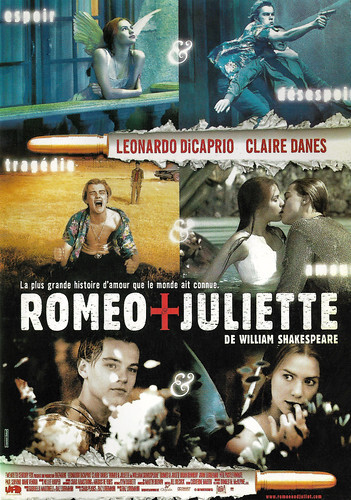
French postcard by Sonis, no. C. 731. Photo: 20th Century Fox Film Corporation. French film affiche with Leonardo DiCaprio and Claire Danes in Romeo + Juliet (Baz Luhrmann, 1996). Caption: Hope despair tragedy love. The world's greatest love story.
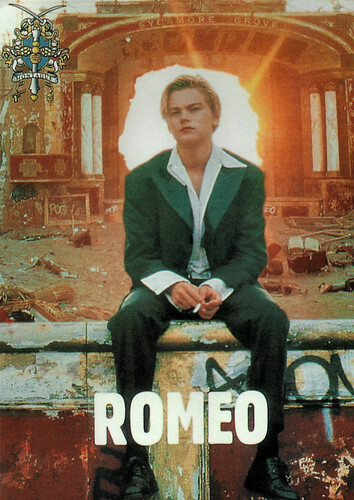
Vintage postcard, no. 012. Leonardo DiCaprio in Romeo + Juliet (Baz Luhrmann, 1996). Caption: Romeo.
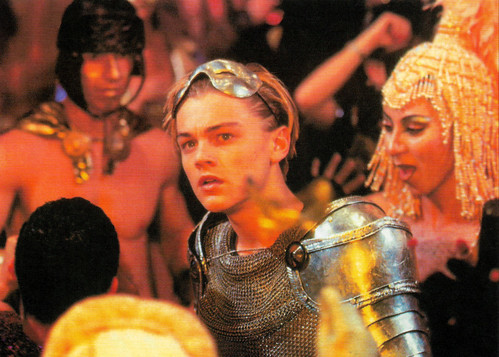
Vintage postcard. Leonardo DiCaprio in Romeo + Juliet (Baz Luhrmann, 1996).
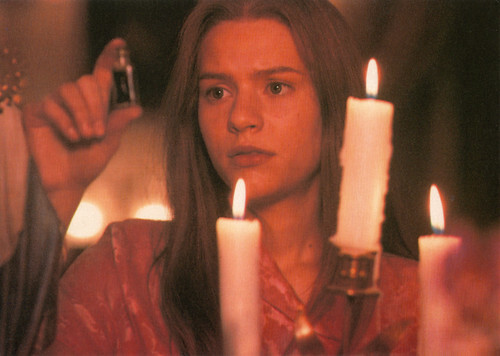
Vintage promotion card. Photo: 20th Century Fox Film Corporation. Claire Danes in Romeo + Juliet (Baz Luhrmann, 1996).
They immediately fall in love
Romeo + Juliet (Baz Luhrmann, 1996) is set in Los Angeles, in the fictional Verona Beach. Two great families, the Montagues, and the Capulets, are warring mafia empires with legitimate business fronts.
The young men of the two feuding Montague and Capulet families get into fights at every opportunity, although the heads of the families urge moderation. After a petrol station goes up in flames during a shootout, the police give the families the ultimate warning to keep the peace from now on.
Romeo ( Leonardo DiCaprio ), son of the Montague family, initially attends a costume party at the Capulet house without being recognised and meets the Capulet's daughter Juliet (Claire Danes). They immediately fall in love, although they don't even know each other's names at first. After talking to each other during a secret dip in the pool, they decide to get married the next day, settling the long dispute between the two families.
They find support from Juliet's nurse (Miriam Margolyes) and Father Laurence (Pete Postlethwaite), who marries them. Shortly afterwards, Romeo's friend Mercutio (Harold Perrineau) is killed by Juliet's cousin Tybalt (John Leguizamo) in a quarrel. Romeo, who initially tried to de-escalate the situation, is furious. He pursues Tybalt and shoots him. He then seeks help from Father Laurence, who advises him to spend the night with Juliet, flee to Mantua in the early morning, and stay there until he receives news.
Juliet's parents, who still know nothing about Romeo, have now arranged their daughter's wedding to the heartthrob Count Paris (Paul Rudd). When she resists, she is accused of ingratitude. Desperate, she also seeks advice from Father Laurence and receives a drug from him that will put her into a 24-hour death-like sleep to escape a forced marriage to Count Paris. Father Laurence immediately sends Romeo an express letter to Mantua to inform him of this plan. However, the letter cannot be delivered after two attempts.
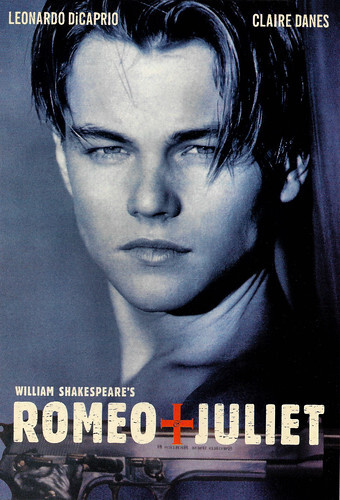
Vintage postcard by Promode, no. PR 090. Photo: 20th Century Fox. Leonardo DiCaprio in Romeo + Juliet (Baz Luhrmann, 1996).
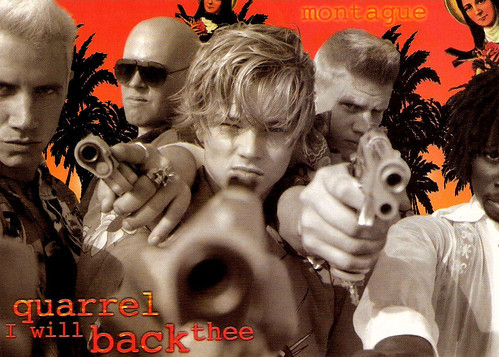
Vintage postcard. Photo: 20th Century Fox. Jamie Kennedy, Zak Orth, Leonardo DiCaprio , Dash Mihok, and Harold Perrineau in Romeo + Juliet (Baz Luhrmann, 1996). Caption: Montague. Quarrel I Will Back Thee.
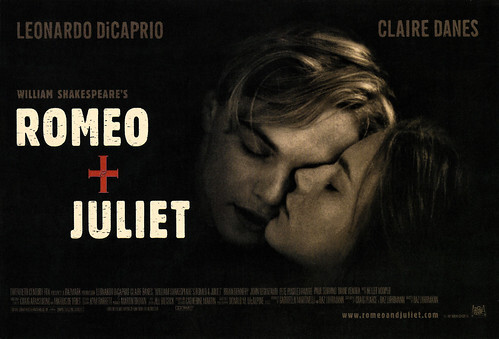
Vintage postcard by Promode, no. PR 094. Photo: 20th Century Fox Film Corporation. Leonardo DiCaprio and Claire Danes in Romeo + Juliet (Baz Luhrmann, 1996).
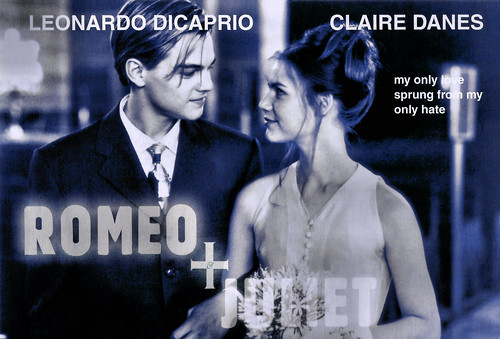
Vintage postcard by Promode, no. PR 094. Photo: 20th Century Fox Film Corporation. Leonardo DiCaprio and Claire Danes in Romeo + Juliet (Baz Luhrmann, 1996). Caption: My only love sprung from my only hate.
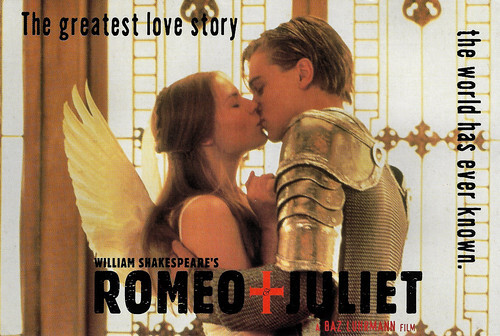
Australian postcard by Avant Card, 1996, no. 1205. Photo: 20th Century Fox Film Corporation.Claire Danes and Leonardo DiCaprio in Romeo + Juliet (Baz Luhrmann, 1996). Caption: The greatest love story the world has ever known.
Firearms called Dagger, Sword, or Rapier
Romeo + Juliet is the second film in Baz Luhrmann's Red Curtain trilogy. The other two are Strictly Ballroom (1992) and Moulin Rouge! (2001). The film was an international co-production involving principals from the United States, Mexico, Australia, and Canada.
Kate Winslet auditioned for the role of Juliet. A year later, she appeared alongside Leonardo DiCaprio in Titanic (James Cameron, 1997). Natalie Portman, then 14, had been cast as Juliet but, during rehearsals, it was thought that she looked too young for the part, and the footage looked as though DiCaprio (21) was "molesting" her. After Sarah Michelle Gellar turned down the role due to scheduling conflicts, DiCaprio proclaimed that Claire Danes should be cast, as he felt she was genuine in her line delivery and did not try to impress him by acting flirtatious.
Both Christian Bale and Ewan McGregor auditioned for the role of Mercutio, which eventually went to African-American actor Harold Perrineau. Romeo + Juliet was filmed in Mexico from January to April 1996. Mercutio's murder was filmed during a hurricane. The element of water has a special significance in this film. It symbolizes the purity of love between Romeo and Juliet. Both are seen underwater in various scenes, they see each other for the first time through an aquarium and kiss in the pool. The purity of this love is destroyed by Tybalt's death in a fountain.
One of the reasons the film has become famous is because of the specially modified vehicles and weapons. The modified automatic pistols are based on the Beretta 92FS model and its licensed version Taurus PT92 or PT96 and the Colt Combat Commander, a variant of the Colt 1911. The engraved names were then adapted to the original of William Shakespeare 's version. Thus, the firearms are called Dagger, Sword, or Rapier, each with the corresponding calibre information.
Romeo + Juliet is the third major film version of the play, following adaptations by George Cukor in 1936 and Franco Zeffirelli in 1968. The film, produced by 20th Century Fox, was met with generally positive reviews from critics. However, Roger Ebert gave the film a mixed review of only two stars out of four, saying, "I've seen King Lear as a samurai drama and Macbeth as a Mafia story, and two different Romeo and Juliets about ethnic difficulties in Manhattan ( West Side Story and China Girl), but I have never seen anything remotely approaching the mess that the new punk version of Romeo & Juliet makes of Shakespeare's tragedy.". The film grossed over $147 million against its $14.5 million budget.
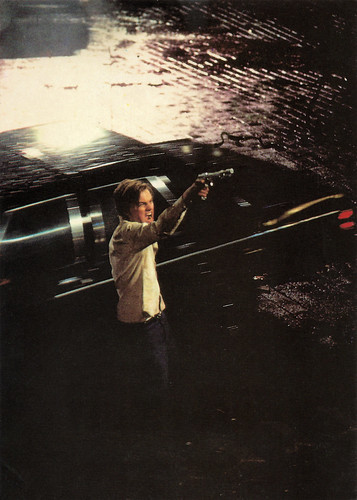
Vintage postcard. Leonardo DiCaprio in Romeo + Juliet (Baz Luhrmann, 1996).
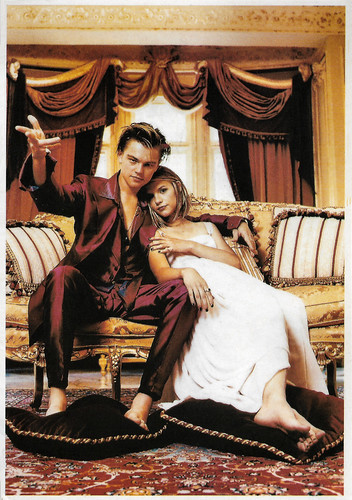
Spanish postcard by Memory Card, no. 434. Leonardo DiCaprio and Claire Danes in Romeo + Juliet (Baz Luhrmann, 1996).
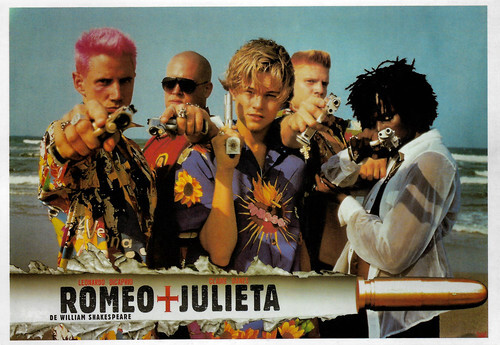
Spanish postcard by Editions Mercuri, no. 399. Jamie Kennedy, Zak Orth, Leonardo DiCaprio , Dash Minok and Harold Perrineau in Romeo + Juliet (Baz Luhrmann, 1996).
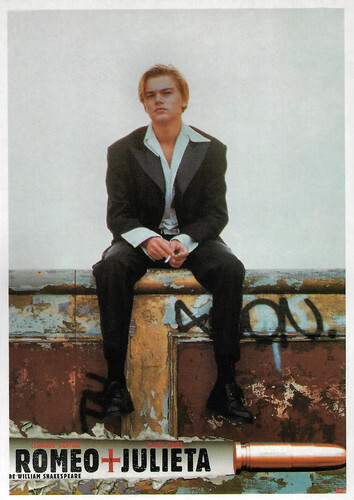
Spanish postcard by Memory Card, no. 406. Leonardo DiCaprio in Romeo + Juliet (Baz Luhrmann, 1996).
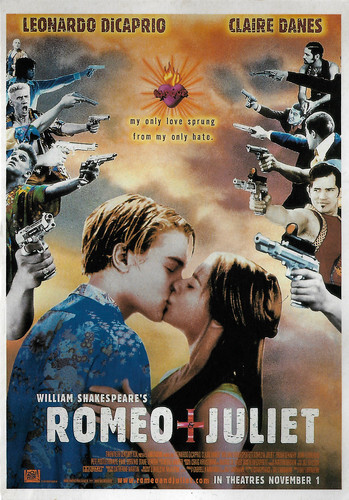
Vintage postcard in the Cinemascope Collection, no. 24. Poster by: 20th Century Fox Film Corporation. Leonardo DiCaprio and Claire Danes in Romeo + Juliet (Baz Luhrmann, 1996). Caption: My only love sprung from my only hate.
Sources: Roger Ebert (RogerEbert.com), Wikipedia (Dutch, German and English) and IMDb.

French postcard by Sonis, no. C. 731. Photo: 20th Century Fox Film Corporation. French film affiche with Leonardo DiCaprio and Claire Danes in Romeo + Juliet (Baz Luhrmann, 1996). Caption: Hope despair tragedy love. The world's greatest love story.

Vintage postcard, no. 012. Leonardo DiCaprio in Romeo + Juliet (Baz Luhrmann, 1996). Caption: Romeo.

Vintage postcard. Leonardo DiCaprio in Romeo + Juliet (Baz Luhrmann, 1996).

Vintage promotion card. Photo: 20th Century Fox Film Corporation. Claire Danes in Romeo + Juliet (Baz Luhrmann, 1996).
They immediately fall in love
Romeo + Juliet (Baz Luhrmann, 1996) is set in Los Angeles, in the fictional Verona Beach. Two great families, the Montagues, and the Capulets, are warring mafia empires with legitimate business fronts.
The young men of the two feuding Montague and Capulet families get into fights at every opportunity, although the heads of the families urge moderation. After a petrol station goes up in flames during a shootout, the police give the families the ultimate warning to keep the peace from now on.
Romeo ( Leonardo DiCaprio ), son of the Montague family, initially attends a costume party at the Capulet house without being recognised and meets the Capulet's daughter Juliet (Claire Danes). They immediately fall in love, although they don't even know each other's names at first. After talking to each other during a secret dip in the pool, they decide to get married the next day, settling the long dispute between the two families.
They find support from Juliet's nurse (Miriam Margolyes) and Father Laurence (Pete Postlethwaite), who marries them. Shortly afterwards, Romeo's friend Mercutio (Harold Perrineau) is killed by Juliet's cousin Tybalt (John Leguizamo) in a quarrel. Romeo, who initially tried to de-escalate the situation, is furious. He pursues Tybalt and shoots him. He then seeks help from Father Laurence, who advises him to spend the night with Juliet, flee to Mantua in the early morning, and stay there until he receives news.
Juliet's parents, who still know nothing about Romeo, have now arranged their daughter's wedding to the heartthrob Count Paris (Paul Rudd). When she resists, she is accused of ingratitude. Desperate, she also seeks advice from Father Laurence and receives a drug from him that will put her into a 24-hour death-like sleep to escape a forced marriage to Count Paris. Father Laurence immediately sends Romeo an express letter to Mantua to inform him of this plan. However, the letter cannot be delivered after two attempts.

Vintage postcard by Promode, no. PR 090. Photo: 20th Century Fox. Leonardo DiCaprio in Romeo + Juliet (Baz Luhrmann, 1996).

Vintage postcard. Photo: 20th Century Fox. Jamie Kennedy, Zak Orth, Leonardo DiCaprio , Dash Mihok, and Harold Perrineau in Romeo + Juliet (Baz Luhrmann, 1996). Caption: Montague. Quarrel I Will Back Thee.

Vintage postcard by Promode, no. PR 094. Photo: 20th Century Fox Film Corporation. Leonardo DiCaprio and Claire Danes in Romeo + Juliet (Baz Luhrmann, 1996).

Vintage postcard by Promode, no. PR 094. Photo: 20th Century Fox Film Corporation. Leonardo DiCaprio and Claire Danes in Romeo + Juliet (Baz Luhrmann, 1996). Caption: My only love sprung from my only hate.

Australian postcard by Avant Card, 1996, no. 1205. Photo: 20th Century Fox Film Corporation.Claire Danes and Leonardo DiCaprio in Romeo + Juliet (Baz Luhrmann, 1996). Caption: The greatest love story the world has ever known.
Firearms called Dagger, Sword, or Rapier
Romeo + Juliet is the second film in Baz Luhrmann's Red Curtain trilogy. The other two are Strictly Ballroom (1992) and Moulin Rouge! (2001). The film was an international co-production involving principals from the United States, Mexico, Australia, and Canada.
Kate Winslet auditioned for the role of Juliet. A year later, she appeared alongside Leonardo DiCaprio in Titanic (James Cameron, 1997). Natalie Portman, then 14, had been cast as Juliet but, during rehearsals, it was thought that she looked too young for the part, and the footage looked as though DiCaprio (21) was "molesting" her. After Sarah Michelle Gellar turned down the role due to scheduling conflicts, DiCaprio proclaimed that Claire Danes should be cast, as he felt she was genuine in her line delivery and did not try to impress him by acting flirtatious.
Both Christian Bale and Ewan McGregor auditioned for the role of Mercutio, which eventually went to African-American actor Harold Perrineau. Romeo + Juliet was filmed in Mexico from January to April 1996. Mercutio's murder was filmed during a hurricane. The element of water has a special significance in this film. It symbolizes the purity of love between Romeo and Juliet. Both are seen underwater in various scenes, they see each other for the first time through an aquarium and kiss in the pool. The purity of this love is destroyed by Tybalt's death in a fountain.
One of the reasons the film has become famous is because of the specially modified vehicles and weapons. The modified automatic pistols are based on the Beretta 92FS model and its licensed version Taurus PT92 or PT96 and the Colt Combat Commander, a variant of the Colt 1911. The engraved names were then adapted to the original of William Shakespeare 's version. Thus, the firearms are called Dagger, Sword, or Rapier, each with the corresponding calibre information.
Romeo + Juliet is the third major film version of the play, following adaptations by George Cukor in 1936 and Franco Zeffirelli in 1968. The film, produced by 20th Century Fox, was met with generally positive reviews from critics. However, Roger Ebert gave the film a mixed review of only two stars out of four, saying, "I've seen King Lear as a samurai drama and Macbeth as a Mafia story, and two different Romeo and Juliets about ethnic difficulties in Manhattan ( West Side Story and China Girl), but I have never seen anything remotely approaching the mess that the new punk version of Romeo & Juliet makes of Shakespeare's tragedy.". The film grossed over $147 million against its $14.5 million budget.

Vintage postcard. Leonardo DiCaprio in Romeo + Juliet (Baz Luhrmann, 1996).

Spanish postcard by Memory Card, no. 434. Leonardo DiCaprio and Claire Danes in Romeo + Juliet (Baz Luhrmann, 1996).

Spanish postcard by Editions Mercuri, no. 399. Jamie Kennedy, Zak Orth, Leonardo DiCaprio , Dash Minok and Harold Perrineau in Romeo + Juliet (Baz Luhrmann, 1996).

Spanish postcard by Memory Card, no. 406. Leonardo DiCaprio in Romeo + Juliet (Baz Luhrmann, 1996).

Vintage postcard in the Cinemascope Collection, no. 24. Poster by: 20th Century Fox Film Corporation. Leonardo DiCaprio and Claire Danes in Romeo + Juliet (Baz Luhrmann, 1996). Caption: My only love sprung from my only hate.
Sources: Roger Ebert (RogerEbert.com), Wikipedia (Dutch, German and English) and IMDb.
Published on February 28, 2024 22:00
February 27, 2024
Conway Tearle
American actor Conway Tearle (1878-1938) was at the end of the 1910s and early 1920s one of the highest-paid leading men in Hollywood.
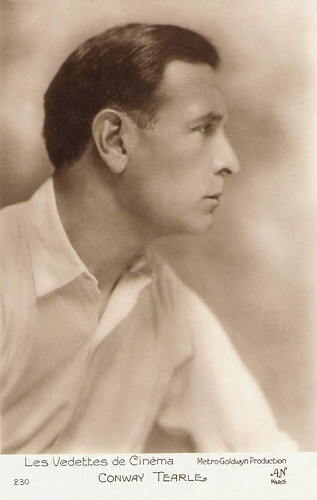
French postcard in the Les vedettes de cinéma series by A.N. Paris, no. 230. Photo: Metro-Goldwyn.

American Arcade card. Photo: Witzel, L.A. Conway Tearle in Marooned Hearts (George Archainbaud, 1920).
The dashing hero or ardent lover
Conway Tearle was born Frederick Conway Levy in 1878 in New York, New York. His parents were Jules Levy, a well-known cornetist and actress Marianne "Minnie" Conway. After Tearle's parents separated, his mother married Osmond Tearle, a British Shakespearean actor popular in 'the provinces'. His maternal half-brother was British actor Godfrey Tearle.
Conway Levy was educated in England and America and took to the stage at an early age. By the age of ten, he could recite twelve Shakespearean plays from memory. Levy took over the stage name Conway Tearle. His big break came at the age of twenty-one when in Manchester, England, without any preparation, he was called upon to play Hamlet after the lead actor took ill just before the first act.
Tearle's performance that night led to his first appearance on the London stage playing the Viscomte de Chauvin, the lead role in 'The Queen's Double' (1901), at the Garrick Theatre. At the beginning of the 1900s, Tearle was on numerous tours in Australia, Ireland and Britain before he made his debut on Broadway in 1905. The great success was denied him, so in 1914, he turned to cinema.
He made his debut alongside Ethel Barrymore in the silent movie drama The Nightingale (1914), written and directed by Augustus Thomas. Over the next few years, Tearle performed in 93 films and for some years he was the highest paid actor in Hollywood. He was often cast as the dashing hero or ardent lover. Tearle made his breakthrough in 1918 alongside Mary Pickford in the drama Stella Maris (Marshall Neilan, 1918).
In 1923, he appeared alongside Pola Negri in her US debut, the romance Bella Donna (George Fitzmaurice, 1923), and in the same year, he appeared alongside Corinne Griffith in Frank Lloyd's fantasy drama Black Oxen (Frank Lloyd, 1923), in which Clara Bow played one of her first roles.
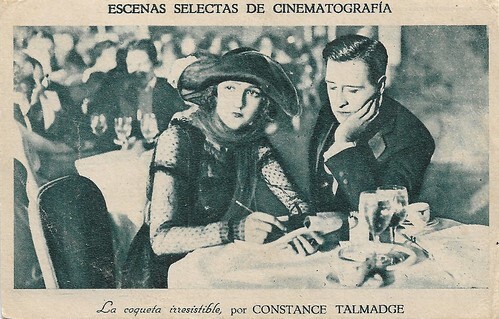
Spanish minicard, series B, no. 19 in the Escenas selectas de cinematografia series by Chocolates Piera y Brugueras, Tarrasa (Barcelona). Constance Talmadge and Conway Tearle in A Virtuous Vamp (David Kirkland, 1919). The Spanish title is La coqueta irresistibile.
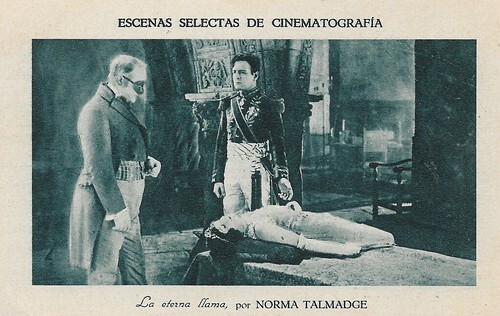
Spanish minicard, series A, no. 10 in the Escenas selectas de cinematografia series by Chocolates Piera y Brugueras, Tarrasa (Barcelona). Norma Talmadge and Conway Tearle in The Eternal Flame (Frank Lloyd, 1922).

Spanish minicard in the Escenas selectas de cinematografia series, series B, no. 16. Norma Talmadge and Conway Tearle in The Eternal Flame (Frank Lloyd, 1922).
Dinner at Eight
By that time, Conway Tearle had already passed the zenith of his popularity, but could still demand a $ 2,750 weekday wage. Other memorable titles are A Virtuous Vamp (David Kirkland, 1919) with Constance Talmadge , She Loves and Lies (Chester Withey, 1920) and The Eternal Flame (Frank Lloyd, 1922), both opposite Norma Talmadge .
Later followed such films as Lilies of the Field (John Francis Dillon, 1924) featuring Corinne Griffith , and Dancing Mothers (Herbert Brenon, 1926) starring Clara Bow . The actor easily made the leap into the sound film and played regular supporting roles until his death.
In 1932, Tearle finally had the hoped-for success on stage in the production of 'Dinner at Eight' by George S. Kaufman and Edna Ferber. In the 1933 film adaptation, Dinner at Eight (George Cukor, 1933) his role was taken over by John Barrymore . Both actors played together in Cukor's Shakespeare film adaptation Romeo and Juliet (George Cukor, 1936), starring Norma Shearer and Leslie Howard .
Conway Tearle was married four times. His third wife, Roberta Hill, filed for a divorce in 1916 after detectives she hired found him in a hotel room with Adele Rowland, a musical-comedy actress and singer. The two claimed they were just rehearsing a play. Tearle and Rowland wed in 1918 and remained together until his death.
Conway Tearle died in 1938 in Los Angeles at the age of 60 years of a heart attack, after he had already withdrawn from the acting business the year before because of health problems.
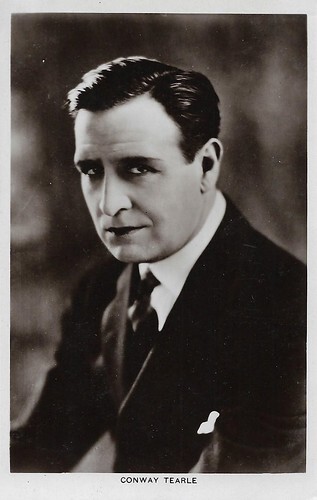
British postcard in the Picturegoer Series, London, no. 26a.
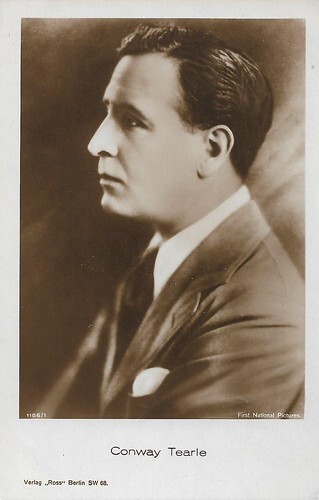
German postcard by Verlag Ross, Berlin, no. 1186/1, 1927-1928. Photo: First National.
Source: Wikipedia (German and English), and .

French postcard in the Les vedettes de cinéma series by A.N. Paris, no. 230. Photo: Metro-Goldwyn.

American Arcade card. Photo: Witzel, L.A. Conway Tearle in Marooned Hearts (George Archainbaud, 1920).
The dashing hero or ardent lover
Conway Tearle was born Frederick Conway Levy in 1878 in New York, New York. His parents were Jules Levy, a well-known cornetist and actress Marianne "Minnie" Conway. After Tearle's parents separated, his mother married Osmond Tearle, a British Shakespearean actor popular in 'the provinces'. His maternal half-brother was British actor Godfrey Tearle.
Conway Levy was educated in England and America and took to the stage at an early age. By the age of ten, he could recite twelve Shakespearean plays from memory. Levy took over the stage name Conway Tearle. His big break came at the age of twenty-one when in Manchester, England, without any preparation, he was called upon to play Hamlet after the lead actor took ill just before the first act.
Tearle's performance that night led to his first appearance on the London stage playing the Viscomte de Chauvin, the lead role in 'The Queen's Double' (1901), at the Garrick Theatre. At the beginning of the 1900s, Tearle was on numerous tours in Australia, Ireland and Britain before he made his debut on Broadway in 1905. The great success was denied him, so in 1914, he turned to cinema.
He made his debut alongside Ethel Barrymore in the silent movie drama The Nightingale (1914), written and directed by Augustus Thomas. Over the next few years, Tearle performed in 93 films and for some years he was the highest paid actor in Hollywood. He was often cast as the dashing hero or ardent lover. Tearle made his breakthrough in 1918 alongside Mary Pickford in the drama Stella Maris (Marshall Neilan, 1918).
In 1923, he appeared alongside Pola Negri in her US debut, the romance Bella Donna (George Fitzmaurice, 1923), and in the same year, he appeared alongside Corinne Griffith in Frank Lloyd's fantasy drama Black Oxen (Frank Lloyd, 1923), in which Clara Bow played one of her first roles.

Spanish minicard, series B, no. 19 in the Escenas selectas de cinematografia series by Chocolates Piera y Brugueras, Tarrasa (Barcelona). Constance Talmadge and Conway Tearle in A Virtuous Vamp (David Kirkland, 1919). The Spanish title is La coqueta irresistibile.

Spanish minicard, series A, no. 10 in the Escenas selectas de cinematografia series by Chocolates Piera y Brugueras, Tarrasa (Barcelona). Norma Talmadge and Conway Tearle in The Eternal Flame (Frank Lloyd, 1922).

Spanish minicard in the Escenas selectas de cinematografia series, series B, no. 16. Norma Talmadge and Conway Tearle in The Eternal Flame (Frank Lloyd, 1922).
Dinner at Eight
By that time, Conway Tearle had already passed the zenith of his popularity, but could still demand a $ 2,750 weekday wage. Other memorable titles are A Virtuous Vamp (David Kirkland, 1919) with Constance Talmadge , She Loves and Lies (Chester Withey, 1920) and The Eternal Flame (Frank Lloyd, 1922), both opposite Norma Talmadge .
Later followed such films as Lilies of the Field (John Francis Dillon, 1924) featuring Corinne Griffith , and Dancing Mothers (Herbert Brenon, 1926) starring Clara Bow . The actor easily made the leap into the sound film and played regular supporting roles until his death.
In 1932, Tearle finally had the hoped-for success on stage in the production of 'Dinner at Eight' by George S. Kaufman and Edna Ferber. In the 1933 film adaptation, Dinner at Eight (George Cukor, 1933) his role was taken over by John Barrymore . Both actors played together in Cukor's Shakespeare film adaptation Romeo and Juliet (George Cukor, 1936), starring Norma Shearer and Leslie Howard .
Conway Tearle was married four times. His third wife, Roberta Hill, filed for a divorce in 1916 after detectives she hired found him in a hotel room with Adele Rowland, a musical-comedy actress and singer. The two claimed they were just rehearsing a play. Tearle and Rowland wed in 1918 and remained together until his death.
Conway Tearle died in 1938 in Los Angeles at the age of 60 years of a heart attack, after he had already withdrawn from the acting business the year before because of health problems.

British postcard in the Picturegoer Series, London, no. 26a.

German postcard by Verlag Ross, Berlin, no. 1186/1, 1927-1928. Photo: First National.
Source: Wikipedia (German and English), and .
Published on February 27, 2024 22:00
February 26, 2024
Jean Lefebvre
French comedian Jean Lefebvre (1919-2004) appeared in about 150 films, mainly in supporting roles. He is best known for the film comedies about the gendarme of Saint-Tropez, in which he co-starred with Louis de Funès. The public loved his big, black, mournful spaniel's eyes and nervous, slightly rat-like smile.
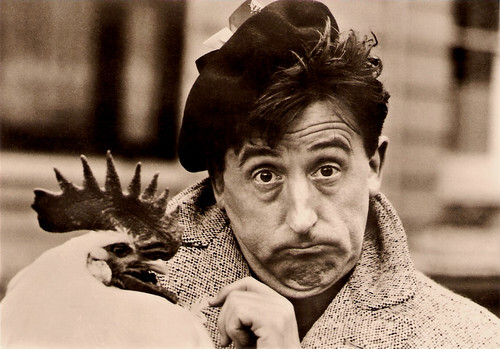
East-German postcard by VEB Progress Film Vertrieb, Berlin, no. 2.632, 1966. Retail price: 0,20 MDN.
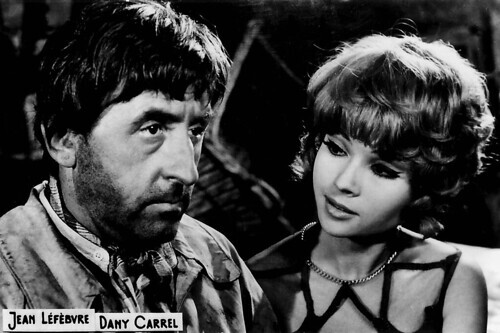
Romanian collector card. Jean Lefebvre and Dany Carrel in Un idiot à Paris/An Idiot in Paris (Serge Korber, 1967).
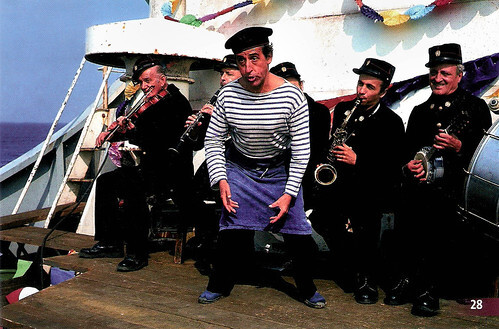
French postcard by Editions Atlas, Evreux, no. 28. Photo: INA. Jean Lefebvre in the TV series Chéri-Bibi (Jean Pignol, 1974-1975). IMDb: "Billy Bob Thornton appears to have lifted his Sling Blade (1996) performance - for which he lost the Best Actor Oscar, but won one for writing - entirely from Hervé Sand's Chéri-Bibi, down to his facial expressions, mannerisms and vocalizations (lower pitched voice and grunting). The French series being completely obscure and unheard of in the USA, no one was the wisest back in 1996." Hervé Sand was Lefebrvre's co-star.
Too big for his body
Jean Marcel Lefebvre (sometimes Lefevre) was born in Valenciennes, in the North of France in 1919 (some sources indicate he was born in 1922). He was the son of Georges Marcel Lefebvre and Zélia Louise Mathilde Masquelier.
As a boy, Jean made his first film appearance as the son of Judex in Judex 34 (Maurice Champreux, Roger de Trémeuse, 1933). After the war, he was an extra in films like Un flic/A Cop (Maurice de Canonge, 1947).
He went to the conservatory in Paris in 1948. He won second prize at the Opéra Comique, where he studied for a while. But his subsequent drama teacher, René Simon, took him down a few pegs when he informed Lefebvre that his stage acting voice was too big for his body. The effect was unintentionally ludicrous, so he was advised to stick to light comedy.
He made his stage debut in 'Vignes du Seigneur' at the Cabaret Amiral, then played a small part in Robert Dhéry's first great success, 'La Plume de ma tante' (The Pen of My Aunt), in the early fifties. He became a member of Dhéry’s company Les Branquignols.
He was to appear in numerous plays and in more than a hundred films, some of them total flops. In French, a flop is called a "navet" (turnip) which prompted him to remark that in his long career, he had planted a whole field of turnips. But he also appeared in some memorable comedies.
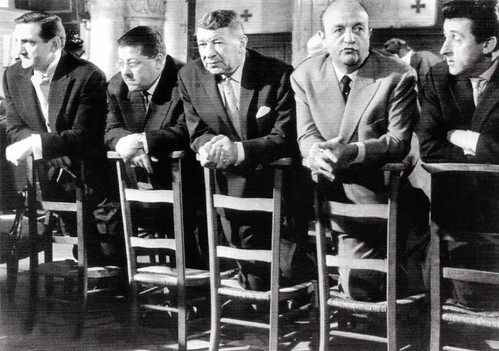
French postcard by Finart-Print (DR), no. 307. Lino Ventura , Francis Blanche, Robert Dalban, Bernard Blier and Jean Lefebvre in Les Tontons flingueurs/Crooks in Clover (Georges Lautner, 1963).
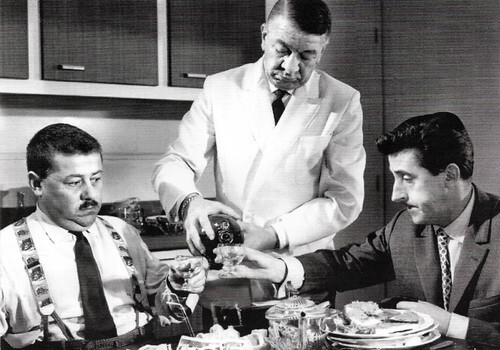
French postcard by Finart-Print (DR), no. 312. Francis Blanche, Robert Dalban and Jean Lefebvre in Les Tontons flingueurs/Crooks in Clover (Georges Lautner, 1963).
Les Gendarmes
Jean Lefebvre entered the film world in the early 1950s and played some minor roles. In 1954 he appeared as a drunken sailor in Les Diaboliques/Diabolique (Henri-Georges Clouzot, 1954) starring Simone Signoret .
Two years later he appeared as René in Et Dieu... créa la femme/And Woman… Was Created (Roger Vadim, 1956) with Brigitte Bardot , and again two years later in La Fille de Hamburg/The Girl From Hamburg (Yves Allégret, 1958) with Daniel Gélin and Hildegard Knef .
He also appeared in some comedies by his old buddy Robert Dhéry, La belle Américaine/The American Beauty (Robert Dhéry, Pierre Tchernia, 1961) and Allez France!/Up the French! (Robert Dhéry, Pierre Tchernia, 1964) with Diana Dors . He also appeared in the Hollywood production Gigot (Gene Kelly, 1964), an Oscar-nominated tribute to Charlie Chaplin and his film The Kid (1921) with Jackie Coogan .
Among his other successful films of the 1960s were the gangster comedy Les Tontons flingueurs/Crooks in Clover (Georges Lautner, 1963), and Ne nous fâchons pas/Let’s Not Get Angry (Georges Lautner, 1966), both with Lino Ventura .
Very popular was the comic series about the policemen of St. Tropez, starting with Le Gendarme de Saint-Tropez/The Gendarme of St. Tropez (Jean Girault, 1964). In these hilarious farces, he co-starred as the naïve Fougasse at the side of Louis de Funès and Michel Galabru . According to James Kirkup in The Independent , Lefebvre was called ‘le tendre pitre’ - the soft-hearted stooge. Audiences loved his randy adolescent's sidelong off-screen look of slightly panic-stricken bliss in the clutches of a statuesque but indulgently motherly hoofer.
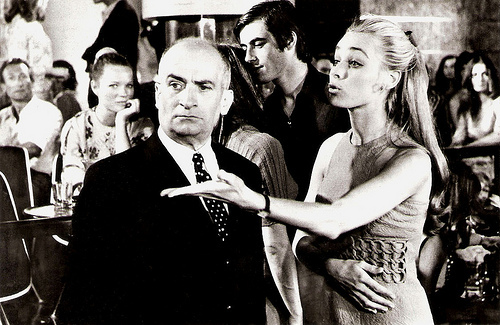
Louis de Funès . Romanian postcard by Casa Filmului Acin, no. 294. Retail price: 1,50 Lei. Photo: publicity shot for Le gendarme se marie/The Gendarme Gets Married (Jean Girault, 1968) with Geneviève Grad .
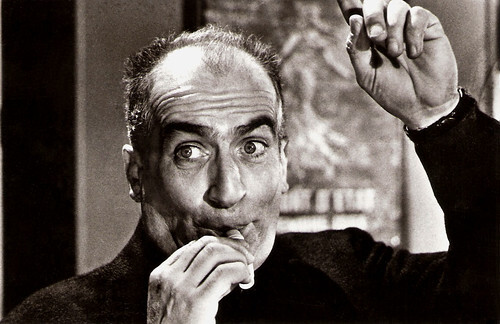
Louis de Funès . Romanian postcard by Casa Filmului Acin, no. 309. Retail price: 1,50 Lei.
The Seventh Company
Jean Lefebvre appeared in the 1970s in some international productions, such as Treasure Island (John Hough, 1972) with Orson Welles . Among his most successful films of this decade were Le Magnifique/The Magnificent Secret Agent (Philippe de Broca, 1973) starring Jean-Paul Belmondo , and Pas de problème!/No Problem (Georges Lautner, 1975) with Miou-Miou .
He also starred in the popular war comedies about the seventh company, On a retrouvé la 7eme compagnie !/The Seventh Company Has been Found (Robert Lamoureux, 1975) and La 7ème compagnie au clair de lune/The Seventh Company Oudoors (Robert Lamoureux, 1977).
In the 1980s he made far fewer films. He published a book, 'Pourquoi ça n'arrive qu'à moi?' in 1984, in which he mentions his birth date as 1922 and not 1919. And in the following decades, he mainly appeared on TV.
In 1999, Lefebvre won 15 million French Francs (2.5 million euros) with the Lottery, and he opened a restaurant, 'La Bohème', in Marrakech, Morocco (some sources indicate that the fortune was won with gambling and not with the Lottery). Incidentally, he appeared in films or on TV. His last film was Fifi Martingale (Jacques Rozier, 2001).
At the age of 84, Jean Lefebvre died in Marrakech in 2004. He was married four times (of which twice with the same wife): to Micheline Reine Grasser (1950-1962); Catherine Chassin-Briault, aka actress Yori Bertin (1967-1973 and 1974-1977); and finally in 1994, with Brigitte Jacqueline Françoise Lerebours. He had five children: Bernard, Catherine, Marie-Christine, Carole and Pascal.
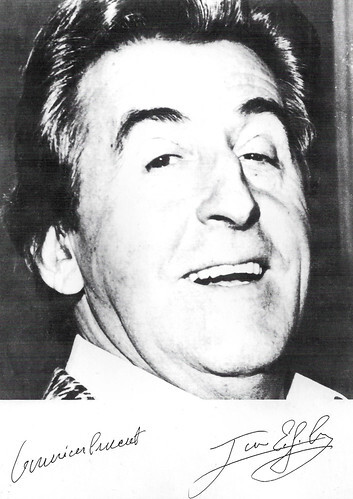
French postcard by La Roue Tourne, Paris.
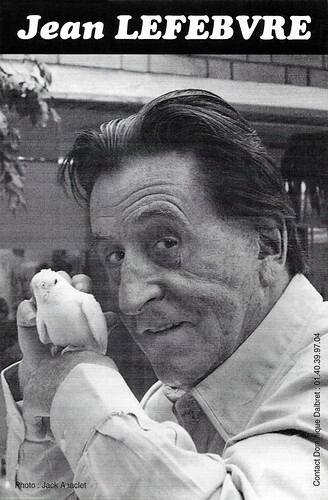
French card by Dominique Dalbret. Photo: Jack Anaclet.
Recut trailer for Les Tontons flingueurs/Crooks in Clover (1963). Source: Donny Brenton (YouTube).
Sources: James Kirkup (The Independent), Wikipedia, and .

East-German postcard by VEB Progress Film Vertrieb, Berlin, no. 2.632, 1966. Retail price: 0,20 MDN.

Romanian collector card. Jean Lefebvre and Dany Carrel in Un idiot à Paris/An Idiot in Paris (Serge Korber, 1967).

French postcard by Editions Atlas, Evreux, no. 28. Photo: INA. Jean Lefebvre in the TV series Chéri-Bibi (Jean Pignol, 1974-1975). IMDb: "Billy Bob Thornton appears to have lifted his Sling Blade (1996) performance - for which he lost the Best Actor Oscar, but won one for writing - entirely from Hervé Sand's Chéri-Bibi, down to his facial expressions, mannerisms and vocalizations (lower pitched voice and grunting). The French series being completely obscure and unheard of in the USA, no one was the wisest back in 1996." Hervé Sand was Lefebrvre's co-star.
Too big for his body
Jean Marcel Lefebvre (sometimes Lefevre) was born in Valenciennes, in the North of France in 1919 (some sources indicate he was born in 1922). He was the son of Georges Marcel Lefebvre and Zélia Louise Mathilde Masquelier.
As a boy, Jean made his first film appearance as the son of Judex in Judex 34 (Maurice Champreux, Roger de Trémeuse, 1933). After the war, he was an extra in films like Un flic/A Cop (Maurice de Canonge, 1947).
He went to the conservatory in Paris in 1948. He won second prize at the Opéra Comique, where he studied for a while. But his subsequent drama teacher, René Simon, took him down a few pegs when he informed Lefebvre that his stage acting voice was too big for his body. The effect was unintentionally ludicrous, so he was advised to stick to light comedy.
He made his stage debut in 'Vignes du Seigneur' at the Cabaret Amiral, then played a small part in Robert Dhéry's first great success, 'La Plume de ma tante' (The Pen of My Aunt), in the early fifties. He became a member of Dhéry’s company Les Branquignols.
He was to appear in numerous plays and in more than a hundred films, some of them total flops. In French, a flop is called a "navet" (turnip) which prompted him to remark that in his long career, he had planted a whole field of turnips. But he also appeared in some memorable comedies.

French postcard by Finart-Print (DR), no. 307. Lino Ventura , Francis Blanche, Robert Dalban, Bernard Blier and Jean Lefebvre in Les Tontons flingueurs/Crooks in Clover (Georges Lautner, 1963).

French postcard by Finart-Print (DR), no. 312. Francis Blanche, Robert Dalban and Jean Lefebvre in Les Tontons flingueurs/Crooks in Clover (Georges Lautner, 1963).
Les Gendarmes
Jean Lefebvre entered the film world in the early 1950s and played some minor roles. In 1954 he appeared as a drunken sailor in Les Diaboliques/Diabolique (Henri-Georges Clouzot, 1954) starring Simone Signoret .
Two years later he appeared as René in Et Dieu... créa la femme/And Woman… Was Created (Roger Vadim, 1956) with Brigitte Bardot , and again two years later in La Fille de Hamburg/The Girl From Hamburg (Yves Allégret, 1958) with Daniel Gélin and Hildegard Knef .
He also appeared in some comedies by his old buddy Robert Dhéry, La belle Américaine/The American Beauty (Robert Dhéry, Pierre Tchernia, 1961) and Allez France!/Up the French! (Robert Dhéry, Pierre Tchernia, 1964) with Diana Dors . He also appeared in the Hollywood production Gigot (Gene Kelly, 1964), an Oscar-nominated tribute to Charlie Chaplin and his film The Kid (1921) with Jackie Coogan .
Among his other successful films of the 1960s were the gangster comedy Les Tontons flingueurs/Crooks in Clover (Georges Lautner, 1963), and Ne nous fâchons pas/Let’s Not Get Angry (Georges Lautner, 1966), both with Lino Ventura .
Very popular was the comic series about the policemen of St. Tropez, starting with Le Gendarme de Saint-Tropez/The Gendarme of St. Tropez (Jean Girault, 1964). In these hilarious farces, he co-starred as the naïve Fougasse at the side of Louis de Funès and Michel Galabru . According to James Kirkup in The Independent , Lefebvre was called ‘le tendre pitre’ - the soft-hearted stooge. Audiences loved his randy adolescent's sidelong off-screen look of slightly panic-stricken bliss in the clutches of a statuesque but indulgently motherly hoofer.

Louis de Funès . Romanian postcard by Casa Filmului Acin, no. 294. Retail price: 1,50 Lei. Photo: publicity shot for Le gendarme se marie/The Gendarme Gets Married (Jean Girault, 1968) with Geneviève Grad .

Louis de Funès . Romanian postcard by Casa Filmului Acin, no. 309. Retail price: 1,50 Lei.
The Seventh Company
Jean Lefebvre appeared in the 1970s in some international productions, such as Treasure Island (John Hough, 1972) with Orson Welles . Among his most successful films of this decade were Le Magnifique/The Magnificent Secret Agent (Philippe de Broca, 1973) starring Jean-Paul Belmondo , and Pas de problème!/No Problem (Georges Lautner, 1975) with Miou-Miou .
He also starred in the popular war comedies about the seventh company, On a retrouvé la 7eme compagnie !/The Seventh Company Has been Found (Robert Lamoureux, 1975) and La 7ème compagnie au clair de lune/The Seventh Company Oudoors (Robert Lamoureux, 1977).
In the 1980s he made far fewer films. He published a book, 'Pourquoi ça n'arrive qu'à moi?' in 1984, in which he mentions his birth date as 1922 and not 1919. And in the following decades, he mainly appeared on TV.
In 1999, Lefebvre won 15 million French Francs (2.5 million euros) with the Lottery, and he opened a restaurant, 'La Bohème', in Marrakech, Morocco (some sources indicate that the fortune was won with gambling and not with the Lottery). Incidentally, he appeared in films or on TV. His last film was Fifi Martingale (Jacques Rozier, 2001).
At the age of 84, Jean Lefebvre died in Marrakech in 2004. He was married four times (of which twice with the same wife): to Micheline Reine Grasser (1950-1962); Catherine Chassin-Briault, aka actress Yori Bertin (1967-1973 and 1974-1977); and finally in 1994, with Brigitte Jacqueline Françoise Lerebours. He had five children: Bernard, Catherine, Marie-Christine, Carole and Pascal.

French postcard by La Roue Tourne, Paris.

French card by Dominique Dalbret. Photo: Jack Anaclet.
Recut trailer for Les Tontons flingueurs/Crooks in Clover (1963). Source: Donny Brenton (YouTube).
Sources: James Kirkup (The Independent), Wikipedia, and .
Published on February 26, 2024 22:00
Paul van Yperen's Blog
- Paul van Yperen's profile
- 13 followers
Paul van Yperen isn't a Goodreads Author
(yet),
but they
do have a blog,
so here are some recent posts imported from
their feed.



